- Skip to content
- Skip to primary sidebar
Full Time Explorer
Nepal Travel Blog

Mera Peak Climbing Itinerary: 15 Day Route
Nepal Itinerary , Trekking in Nepal / May 27, 2021 by fulltimeexplorer / 17 Comments
I decided to climb Mera Peak on a bit of a whim when the original trek I’d planned to Upper Dolpa turned out to be too expensive. Swotah Travel & Adventure gave me a Mera Peak climbing itinerary, but after doing some research I asked if I could make some alterations. I wanted to make sure I had plenty of time to acclimate and enjoy the trek, so I took the longest route.
Mera Peak Climbing Route Options
There are several different climbing routes available for Mera Peak. The most popular is to go over the Zatrwa La Pass on the second day. The pass is 4600m and you sleep at a whopping 4200m. Most of the people who came this way described it as extremely difficult, and most suffered altitude sickness on the second night.
Another route requires flying to Phaplu, and then, going a roundabout way toward Mera Peak. Although I didn’t take this route, it may be the smarter way to go for unexpected weather. My flight to Lukla Airport was canceled three days in a row on the way there; however, flights were getting into Phaplu Airport. Also, flying into Lukla is a crazy experience in itself. If you’re afraid to fly, here’s how to take a Jeep ride to Phalpu .
One can also take a jeep to Jiri and then trek up from there. This adds a lot of time to the trek, and I hear the jeep ride is rough, as it takes a lot of small unpaved roads. In the end, I chose to fly into Lukla, and take a long route around the Zatrwa La Pass to give myself time to acclimate properly.
Mera Peak Itinerary Overview
Duration: 15 days
Duration depends on which route you choose to take. This is a longer route that allows more time to acclimate.
Difficulty Level: Difficult/Very Difficult
Highest Altitude: 6,476 m (21,247 feet)
Permits: The Sargarmatha National Park entry fee is 3,390 rupees ($34 USD) and the TIMS is 2,000 rupees ($20 USD). You’ll also need a climbing permit.
Guide Required: A local guide is required for the areas above Khare. I recommend a guide for the entire trek as even the “easy” days were difficult.
Day 1 – Lukla to Paiya
Time Trekking: 4-5 hours
Lukla Altitude: 2,840 meters (9,317 feet)
Paiya Altitude: 2,730 meters (8,956 feet)
Oxygen Concentration: 73%
Distance Covered: 8km
Typically, you would take an early morning flight from Kathmandu to Lukla. Unfortunately, I experienced bad weather three days in a row and was stuck at Kathmandu’s airport. I ended up chartering a helicopter late in the afternoon on the third day, so we spent a night in Lukla and started to hike first thing in the morning.
Although most itineraries say that this is a few hour hike, it actually took us closer to five hours. We stopped in Pakhepani Village for lunch. After lunch, we crossed the Chutok La Pass (2,945m). I would describe day one as “hell.” After three days in an airport just sitting, plus a week of being sick before that, I felt highly unprepared. Day one is mostly walking up and down steep uneven steps. Training on a stair stepper at the gym for a couple hours a day would have made this a lot easier.
Day 2 – Paiya to Panggom
Time Trekking: 5-6 hours
Panggom Altitude: 2,804 meters (9,199 feet)
Oxygen Concentration: 72%
Distance Covered: 12km
Meters Walked Uphill: 1,700m
The trek from Paiya to Panggom is long and hard with huge steep inclines. There are a lot of uneven steps going uphill making it a difficult walk. Originally, I chose this route for acclimation purposes, and the fact that the first few days were all around 3,000m in elevation made it seem like a nice warmup. Another trekkers Garmin watch told us that we had actually gone downhill 1,700m and back uphill 1,700m over the course of five hours.
Despite the hard walk, it’s a nice way to lead up to Mera Peak. We had extremely warm weather, and I was able to walk in a t-shirt and leggings. We stopped at Karte for lunch on route to Panggom. The trek felt like we were going through a jungle which was a really nice contrast to all the snow we would face later. It also gave me time to acclimate and by day three or four, I was used to limited oxygen. In Panggom, there’s a small hike up to a monastery which is great if you have the energy. We happened to arrive during a Puja when hundreds of monks came to the area to pray.
Day 3 – Panggom to Ramailo Danda
Ramailo Danda Altitude: 3,276 meters (10,748 feet)
Oxygen Concentration: 68%
Distance Covered: 9km
Meters Walked Uphill: 1,300m
The original itinerary said we would sleep in Ningsow, but we ended up having lunch there and continuing onto Ramailo Danda. The trek to Ningsow has a nice slow decrease in elevation followed by a steady increase back up. We passed tons of mani walls which are stones engraved with Tibetan Buddhism prayers. You go over the Panggom La Pass (3,174m) on route.
After lunch, there’s a steep incline going up to Ramailo Danda. This part of the trek is difficult but offers beautiful views. I agreed with my guide afterwards that the extra 1-2 hours to the next village was a smart decision. Otherwise, you have to do that section first thing in the morning on day 4 which was already an excruciatingly long day.
In the first four days, you should expect extremely basic accommodations with squat toilet style outhouses, some solar power electricity or none at all, and limited water. One place we stayed didn’t even have a proper floor and was just dirt. That being said, you get to see a much more authentic version of Nepal that is off the beaten path of most tourists. I only saw two other trekkers in the first four days and would later run into big groups once we got back on the main trail.
Day 4 – Ramailo Danda to Takto
Time Trekking: 8 hours
Takto Altitude: 3,670 meters (12,040 feet)
Oxygen Concentration: 65%
Distance Covered: 14km
Meters Walked Uphill: 2,000m
The trail from Ramailo Danda to Takto starts out with the most beautiful rhododendron forest in the entire trek. The rhododendron is the national flower of Nepal, and you can see why. With the morning light, I felt like I was walking through a fairy tale with moss climbing up the trees and bright red and pink flower petals falling to the ground. If you sit around very quietly for long enough, you might get a chance to spot the rare red panda.
I found this day to be excruciating. We hit clouds and fog which made it feel like we were on a treadmill. I couldn’t see any views for 6 hours and was absolutely exhausted. I’m not sure if I just mentally lost it because I couldn’t see how far we’d come or how far we had left to go, but I actually broke down in tears in my room this evening. Another trekker I was with flew back to Kathmandu on a helicopter the next morning because he was exhausted, sore, and wasn’t enjoying himself. Go into this day mentally prepared for it to be extremely tough.
Our original itinerary said to stop earlier in Chhetra Khola but my guide (as well as other guides on the same path) insisted it was better to continue on. I’m not sure why, but I’d imagine stopping in Chhetra Khola would have made the day much easier. Day 5 was super easy, so adding more to that day seems like it’d be a smart choice.
Day 5 – Takto to Kothe
Time Trekking: 3-4 hours
Kothe Altitude: 3,580 meters (11,745 feet)
Oxygen Concentration: 66%
Distance Covered: 7km
Here you’ll pick up the main trekking route and run into people coming over the Zatrwa La Pass (the harder route). From Takto we headed North on a very gentle incline. This day is extremely easy in comparison to past days. We took a tea break at Tashing Ongma and ate lunch at Kothe. Kothe is one of the first places where you can purchase a hot shower for $3.50. Wifi is also available for purchase here and further up the mountain. $5 will get you 200MB while $10 will get 1GB. The only catch is that the cards expire in 15 hours.
Day 6 – Kothe to Thangnak
Thangnak Altitude: 4,358 meters (14,297 feet)
Oxygen Concentration: 60%
Meters Walked Uphill: 800m
The walk to Thangnak is quick and easy. It only takes three to four hours and is a very gentle incline along the river with beautiful views. The round river rocks also create a nice change of scenery from the previous days spent in the forest. We stopped in Saurya for tea and ate lunch when we arrived at Thangnak.
Day 7 – Rest Day in Thangnak
Time Trekking: Acclimation Hike
My guide opted to cancel our acclimation day in Thangnak. Most other groups spent an extra night here. I was feeling great at altitude and was barely having a problem breathing, so I didn’t argue. In hindsight, I didn’t remember how quickly the next few ascents were, and I wish we’d spent the extra day here.
On my trip to Everest Base Camp, I got a really bad cold which turned into pneumonia, so in my mind, I was battling between spending time acclimating, or possibly getting sick from being in cold conditions for an extra night. In the end, we skipped this day, but I wish I’d gone with my original plan to acclimate longer, since I got altitude sickness at High Camp and couldn’t even attempt to summit. If you choose to stay, there is an acclimation hike available up to 5,200m.
Day 8 – Thangnak to Khare
Khare Altitude: 5,045 meters (16,551 feet)
Oxygen Concentration: 55%
Meters Walked Uphill: 700m
Signs for a German Bakery located ahead in Khare made the trek a little easier and provided some extra motivation. It’s a fairly easy start with a gentle incline along the river. We had a tea break halfway there at one lone house in the middle of nowhere. After the tea break, there is a mildly steep incline the rest of the way to Khare. Altitude made it harder to breathe at this point, so the difficulty had more to do with altitude than the actual trail being challenging. At the end, there is a German Bakery and the apple strudel was worth the trek.
Day 9 – Rest Day in Khare
Meters Walked Uphill: 250
There’s a nearby hill which can easily be accessed from the village. Although it’s only a couple hundred meters higher than Khare, it’s still a good acclimation hike. Most people stop at the prayer flags, but I’d urge you to go to the top. The hike only takes an hour, and although it’s steep, it has incredible views from the top facing the opposite direction of the village. I’d recommend going right after breakfast as it got cloudy on the way back and a nice warm walk turned into freezing cold weather on the way down.
A lot of other groups had training for mountaineering on this day. My guide felt it was unnecessary because I was the only one in my group, and he could teach me as we went along. In larger groups, when you’re roped together, you can’t always see the guide, so knowing commands ahead of time is important for communication.
Extra Day Option
Possibly add a day at old Base Camp for acclimation.
Day 10 – Khare to High Camp
Time Trekking: 6-8 hours
High Camp Altitude: 5,780 meters (18,963 feet)
Oxygen Concentration: 50%
This is the first day that you get to use your mountaineering equipment. If you haven’t used it before, it’s going to feel extremely odd. The shoes were very bulky to me, and I wished we’d practiced the day before. Although, I looked at the other groups who had practiced, and they weren’t doing much better.
The trek starts with a hike to Base Camp. There are two Base Camps for Mera (an old and a new). The new one is pretty easy to access after trekking over rocks for a couple of hours. We did this in the snow which made it very slippery and difficult to navigate. I’d actually recommend staying at the old Base Camp for one night if you have time. It’s located at 5,350m. It seemed like the people who stayed at the new Base Camp had the same problem I did with the altitude. Those who spent a night at the old Base Camp had a higher summit rate.
My opinion of the trek to High Camp directly from Khare might be a bit skewed. We had a week of bad weather leading up to the hike, and a lot of people changed their schedules to accommodate for it. We blazed ahead with the original plan, hoping we’d get a window to summit. On the way, the weather changed from sunny to cloudy, which at this altitude meant walking through the clouds. Add in a snow storm, and I was trekking in a complete whiteout for 6 hours. I can’t explain how mentally draining this was, but not seeing how far you’ve come or how far you have left was extremely difficult. Again, if we’d spent a day at old Base Camp, we’d have been halfway there and the trek would not have been so draining.
Day 11 – High Camp to Summit to Khare
Time Trekking: 10-12 hours
Summit Altitude: 6,461 meters (21,197 feet)
Oxygen Concentration: 46% at summit
Unfortunately, I can’t shed much light on summit day. I woke up with a headache, and took some Diamox, but it was too late. We woke up at 2am to summit and kept pushing the time back an hour. By daylight my headache had gone from bad to worse. I felt as though someone had bashed a baseball bat into my skull. I could barely stand up without toppling over. My guide gave me the option to stay another night at High Camp to acclimate and try the next morning. After sitting there for five minutes, I knew there was no way I’d make it 24 hours.
The walk from High Camp back to Khare was beautiful. We were hit with a brutal snow storm during the night (which was probably just a regular snow storm for this altitude). We basically skied down the mountain in our boots. The fresh powder made it easy to slide down with little effort. The views that I hadn’t seen the day before were spectacular and the sky was crystal clear.
Day 12 – Khare to Khote
Kothe Altitude : 3,580 meters (11,745 feet)
The walk from Khare to Kothe is a nice slow easy downhill. The walk isn’t so bad, and it’s not too hard on your knees like other areas. Again, we got hit with bad weather. This time, a rain storm, which made the rocks along the river slippery to walk over. Our pace was a lot slower than usual, and the rain made an easy walk a little more difficult. In nice weather, I’d imagine this is a great day for a relaxing downhill trek.
Day 13 – Kothe to Thuli Kharka
Thuli Kharka Altitude: 4,300 meters (14,107 feet)
The trek starts with a steep uphill which reminded me of the first few days of trekking. Since I took the longer route for this trip, I actually felt mentally and physically prepared for this section. Other groups, who took a shorter route, seemed to struggle. We had an extremely early lunch at 10:30am which appeared to be the only teahouse along the way.
The day got a little more difficult later on. You’ll walk over a lot of uneven rocks, and it began to hail when we hit this section. The hail turned to snow and the snow turned to rain. The rocks slowly got covered in ice making a few sections hard to navigate. Otherwise, the walk was beautiful, serene, and not too difficult considering we were going uphill most of the way.
Day 14 – Thuli Kharka to Lukla
Time Trekking: 6-7 hours
Considering how it was the last day of the trek, I thought it would be easy. Day 14 was one of the most difficult (only behind High Camp and summit day). Since we received several inches of snow the night prior, the path over the Zatwra La Pass was covered. The other groups geared up with mountaineering equipment. Most had on mountaineering boots with crampons. Some wore hiking boots with a slip on crampon . A few were even roped to their guides in case they slipped.
My guide was helicopter rescued two days prior after getting the flu, and my porter took over the duties while carrying my 100L duffle bag. I felt a bit underprepared and unconfident as all I had with me were hiking sneakers. My amazing porter gave me one of his slip on crampons which I’m going to invest in next time. It took me twice as long as everyone else to descend and my mental state was a mess. I slipped a few times and the drop was enough to kill you if you didn’t catch your footing. Make sure to have the right footwear for this section just in case of the snow. You may not need it, but if you do, you’ll be so happy you were prepared.
We had lunch once we got over the pass, and then it was a long but easy trek back to Lukla. The second half of the day was spent in the jungle full of rhododendron trees that were fully bloomed. It reminded me of the first few days minus the steep stairs. Make sure to wear layers this day since you go from over 4,500m down to 3,000m and the climate change is pretty extreme.
Day 15 – fly back to Kathmandu
You might also like…, michelle della giovanna.
Writer at Full Time Explorer
I’m just your average New Yorker who quit her job in the fashion industry to explore the world. Come find out what it’s like to trade in five-inch heels for squat toilets.
- Visit Twitter account (opens in a new tab)
- Visit Facebook account (opens in a new tab)
- Visit Instagram account (opens in a new tab)
- Visit Pinterest account (opens in a new tab)
This website uses affiliate links. This means that I may receive a small commission (at no extra cost to you ) if you purchase something through these links. I only link to products and companies that I love. Those companies, in return, reward me for connecting them to you .
Full Time Explorer LLC is a participant in the Amazon Services LLC Associates Program, an affiliate advertising program designed to provide a means for sites to earn advertising fees by advertising and linking to Amazon.com.
Reader Interactions
March 28, 2019 at 5:01 pm
Hey FulltimeExplorer!
Love the handle. Excellent blog, shame you got hit by AMS on the last day though. Am attempting a very similar route in May, fingers crossed! What were the dates you trekked on? I shall be planning to trek from May 10 or so, and am wondering if i’ll be hit by bad weather like yourself
March 28, 2019 at 5:38 pm
I believe we reached high camp around May 5th. I actually went at the best possible time to summit and still got hit with bad weather. It’s hard to plan in the mountains hahaha I was told it was very unusual weather for that time of the year as May is usually the best time to trek in the Khumbu region. A week before I went almost everyone who tried summited and the week I went maybe 30% made it. Best of luck on your journey! I hope you make it to the top!
June 10, 2019 at 8:54 am
Hey fulltimeexplorer! I’m glad to report back with good news! We did manage to summit on May 20th. Thanks for all the info on your blog: we stayed the extra night at Thagnag as you recommended, and I do believe it helped. I’m currently blogging about the trip, I shall link you.
Thanks again!
June 10, 2019 at 9:14 am
That’s so great to hear! Congrats on summiting!! I’m glad you took the extra time to acclimate and that it worked! Yay
January 18, 2020 at 4:00 pm
Some questions: Did you only rented a guide and a porter for the trip from Lukla to Khare and back? How did you arrange the climb between Khare and the Merapeak? Or was it a fullboard service from lukla to Lukla? Entry permits for the Makalu Barun NP can you buy them in Lukla?
sorry a lot of questions. But we gone do this trip in April. greetings Francky
January 18, 2020 at 4:36 pm
Hi Francky! I did a pre booked trip with a tour company (Swotah Travel and Adventure https://www.swotahtravel.com/ ). I had a guide from Lukla to Lukla which I highly recommend. The pass can be really difficult if there is bad weather (we reached the pass after a bad snow storm in April). Depending on the itinerary you choose, the pass is in the first or last couple of days. Swotah arranged the permits for me in advance in Kathmandu. That can be done at the Nepal Tourism Board office. My tour company arranged them for me. I believe you need the guides information to get the permit or they won’t issue you one. Hope this helps and feel free to ask any other questions! The trek is amazing! Best, Michelle
November 11, 2021 at 2:43 am
Is it possible to do the trek in January. I am planning to trek without the guide and hire guide at Khare
November 11, 2021 at 11:58 am
Hi Deepak! I wouldn’t recommend January because planning will be difficult. If it does snow and the government closes peaks then your trip may be canceled halfway through or at the last minute. There is also a high pass at the beginning and end of the trip (depending which way you go) that is really difficult to navigate in the snow. It would be much better to do it in peak season where you have the best shot of summiting.
November 13, 2021 at 3:14 am
Thank you so much, would it be feasible to do EBC late January. I will avoid the 3 pass route. I to some time off late January early Feb. This way I will avoid the crowd. I would be carrying my own pack.
November 13, 2021 at 1:10 pm
I think you’d have a much better shot of completing EBC in January than Mera. I would pack crampons and really warm clothes though in case of snow. It’s sure to be super cold! I would also have a backup plan just in case weather is bad and your flight is canceled. And I’d try to contact at least one hotel in the everest region and ask if teahouses will be open. Usually they are but with reduced tourists it would be good to check in advance ?
November 13, 2021 at 10:21 pm
Thank you again for your valuable advise. I have been following your blog and website for a while. I am fellow New Jerseyans. Admire your courage to chase your dreams, been thinking about the same for 30 years.
November 14, 2021 at 12:17 pm
Awe thank you for following along! If you have any other questions, don’t hesitate to ask ? and I wish you a wonderful trek (and good weather) for January!
Leave a Reply Cancel reply
Your email address will not be published. Required fields are marked *
Get Instant Response:
- Hillary Classical Trek – 17 Days
- Everest Base Camp Trek – 14 Days
- Everest Three High Passes Trek – 18 Days
- Everest Base Camp Trek Via Gokyo Lake – 15 Days
- Everest View Trek – 5 Days
- Gokyo Renjo La Pass Trek – 13 Days
- Everest Base Camp Trek Heli Return – 10 Days
- Everest Base Camp with Island Peak Climbing – 16 Days
- Everest Base Camp with Lobuche Peak Climbing – 16 Days
- Everest Panorama Trek – 7 Days
- Luxury Everest Base Camp Trek – 12 Days
- Ama Dablam Base Camp Trek – 8 Days
- Short Everest Base Camp Trek – 10 Days
- Gokyo Ri Trek – 10 Days
- Annapurna Base Camp Trek – 7 Days
- Annapurna Circuit Trek – 14 Days
- Annapurna Base Camp Trek via Poon Hill – 13 Days
- Annapurna Circuit Trek with Annapurna Base Camp – 20 Days
- Annapurna Circuit Trek with Tilicho Lake – 15 Days
- Nar Phu Valley Trek – 14 Days
- Poon Hill Trek – 7 Days
- Upper Mustang Trek – 15 Days
- Mardi Himal Trek – 5 Days
- Khopra Danda Trek – 8 Days
- Annapurna Base Camp Trek with Helicopter Return – 8 Days
- Annapurna Sanctuary Trek – 10 Days
- Short Annapurna Circuit Trek – 10 Days
- Manaslu Circuit Trek – 13 Days
- Manaslu Tsum Valley Trek – 20 Days
- Tsum Valley Trek – 16 Days
- Langtang Valley Trek – 8 Days
- Langtang Gosaikunda Trek – 13Days
- Gosaikunda Trek – 5 Days
- Tamang Heritage Trail – 7 Days
- Kanchenjunga Trek – 22 Days
- Pikey Peak Trek – 6 Days
Everest Base Camp Trek
- Annapurna Base Camp Trek
- Manaslu Circuit Trek
- Langtang Valley Trek
- Mera Peak Climbing
- Gokyo Renjo La Pass Trek
- Everest Three High Passes Trek
- Annapurna Circuit Trek with Annapurna Base Camp
- Everest Base Camp Trek Heli Return
- Lower Dolpo Trek – 15 Days
- Island Peak Expedition – 15 Days
- Mera Peak Climbing – 13 Days
- Mera Peak Climbing – 15 Days
- Legal Documents
- Terms & Condition

Mera Peak Climbing - 13 days
Starting from
Starting Price USD 2,450
Group Size 1+
Trip Grade Challenging
Best Season March -May & Sep -November
Accommodation Tea house and Tent in Climbing section
Max Elevation 6470m
Meals Full Board
Transportation Flight
Trek Route Lukla -Chhutanga - Zatrawala Pass-Khare- Highcamp - Summit
Trip Highlights
- The highest ‘trekking peak’ of Nepal for travelers is Mera Peak at an elevation of 6461 meters.
- Witness the mesmerizing view of the Himalayas surrounding the peak including Mount Everest, Mount Lhotse, Mount Makalu, Mount Cho Oyu, and even Mount Kanchenjunga.
- Fantastic upgrade to the Everest base camp trek showing travelers the hidden side of the Sagarmatha NP.
- Wonderful view of landscape and scenery throughout the journey.
- Perfect adventure to choose that will help you transition from trekking to mountaineering.
- A cultural and spiritual journey passing by the Sherpa Villages and monasteries to reach the Peak.
Trip Overview
Mera Peak Climbing is the ultimate journey for adventure lovers in the Nepalese Himalayas. This 15-day -long peak climbing expedition takes visitors to the summit of the highest ‘trekking peak’ currently open for travelers in the country, Mera Peak at an elevation of 6461 meters above sea level. The peak is a hidden gem in eastern Nepal and is often considered the next level for someone who has conquered the world-renowned Everest Base Camp trek. If you are up for the time of your life crossing villages and farmlands and following the trail straight to the heart of the Himalayas, Mera Peak Climbing is a perfect match for you.
The trek to the base camp of Mera Peak starts from Kathmandu. We will land at Lukla the gateway to Everest by a short domestic mountain flight. Leaving the crowded trail behind we will go past Chutunga, Kothe , and iconic Thagnak villages to reach Khare . We’ll acclimatize and prepare to climb the Mera Peak on a rest day here at Khare. We are staying one night in the high camp. We will start the climb to the summit with a majestic view of snow-covered mountains all around us. From the top of the peak, you can have sublime scenery of the magical Himalayas, including Mount Everest, Mount Lhotse, Mount Makalu, Mount Cho Oyu, and even Mount Kanchenjunga. Returning from Mera Peak Climbing , you will find the true joy of travel and adventure in the Nepalese Himalayas.
More Travel Blogs/Guides for Mera Peak Climbing
Popular Peak Climbing in Nepal’s Everest Region
Day to Day Itinerary
Fly to lukla(2,860m/9,383ft) from kathmandu(1,350m/4,429ft) and trek to chhutanga (3500m).
We will meet you at the hotel early today for your flight to Lukla . From Kathmandu, this short flight will take you to the gateway of Everest. Soon after you’ve taken off, the views of the surrounding landscape and mountains will treat you with delight. Nearing Lukla, you can admire the views of the snow-capped peak once more before landing on the short & thrilling airstrip of Tenzing Hillary Airport. and Trek to Chutanga
Trek from Chhutanga(3,500m/10,007ft) to Thuli Kharka (Chatra-la) 4200m/13780ft via Zatrawala-Pass(4,610m/15125ft)
Today will be longer and slightly challenging as we ail to reach Thuli Kharka from Chhutanga. The scenic Zatrawala Pass will be the midpoint of the walk and you can enjoy a majestic view of the mountains all around you during the trek. Spend some time in the Pass and take a gradual downhill trail to reach Thuli Kharka in the late afternoon. Overnight at a teahouse in Thuli Kharka.
Trek from Thuli kharka(420000m/ 13790ft) to Kothe (3600m/11,811ft)
You have another beautiful day today to trek to Kothe from Thuli Kharka. Walking beside the Hinku river your trail goes up and down throughout the day without gaining significant elevation at any section. As you enter the Hinku Valley and near Kothe, you will get the first glances of the Mera peak nearby. Rest for the day after arriving at the small traditional village of Kothe. Overnight at a teahouse in Kothe.
Trek from Kothe (3,600 m/13,435ft) to Thangnak (4,350m/14,272ft)
We will continue to follow the trail beside the Hinku river today to reach Thagnak. The highlight of today will be a short visit to Lungsungba Gompa after Gondisung which is more than 300 years old. Traversing a gradually rising path you will reach a vast Yak pasture as you approach Thangnak. Thangnak also has a trail going towards Gokyo valley and some trekkers like to add an additional day or two to explore that valley.
Trek from Thagnak(4,350m/14,272ft) to Khare (4900m/16076ft)
You will walk in the terminal moraine of the Hinku Nub and Shar glaciers for most of today. The trail is not long but is steep and ascends with some tricky sections in Between to reach Khare. As the view of the Mera Peak gets ever so close, you will get past the 5000 meters mark in elevation to arrive at Khare. Overnight at a teahouse in Khare.
Acclimatization Day in Khare
For better acclimatization, we will rest and do short hikes around the little village today. After breakfast head out to climb the nearby viewpoints and warm up your body. Prepare for a bit challenging couple of days from Khare coming your way. Also, be ready to stay in a camp for some days from now on. Rest for the day after returning from the hikes from Khare. Overnight at a teahouse in Khare.
Trek from Khare(4900m/16,076ft) to High camp (5,800m/19,028ft)
Trek up to the High Camp today from Khare. In the morning you will climb through a steep section over the Mera glacier to reach the Mera Base Camp. Rest for a while and have your lunch here. a snowy and rocky trail will take you to the top of the Mera pass and straight to the Mera High Camp. your team will set up the cam and prepare for the early ascend to the summit tomorrow. We will also check the weather condition and your oxygen levels to ensure the safety of everyone climbing the peak. Overnight at a camp in Mera High Camp.
Summit to Mera Peak(6,470m/21,227ft)) from High camp and descend to Khare
Today is the day you’ve prepared and waited for a long time to reach the summit of the majestic Mera Peak. The ascend starts very early in the morning and we will leave the high camp by 3 am. Your experienced guides will set the footsteps for you to follow as you scale this beautiful peak. Follow the instructions of the guide as there are a couple of tricky sections where you might require proper instructions and ropes for climbing.
After reaching the summit you can have a magical sunrise view of the Himalayas with a clear view of Mt. Everest (8,848m) , Cho-Oyu (8,210m ), Lhotse (8,516m) , Makalu (8,463m), Kangchenjunga (8,586m) , Nuptse (7,855m) , Chamlang (7,319m) , Baruntse (7,129m) and others. Spend some time here and we will be back at the High Camp. Gathering our items from here we will continue further down to Base Camp and have our lunch. Retracing our steps from here we will reach Khare and rest for the day. Overnight at a teahouse in Khare.
Contingency Day for Mera Peak
you can’t guarantee favorable weather when you are in the Himalayas. We have an extra day prepared for you here just to be assured. You will push for the summit today if the day before had adverse or unsafe climbing conditions. If everything goes well you can have a sightseeing tour in Kathmandu on this extra day
Trek from Khare(4900m/ 16,076ft) to Kothe( 3600m/11,811ft)
We will retrace our steps back to Kothe from Khare today. Our lunch stop will be arranged at Thangnak and you can enjoy their trail even more with the successful completion of the trek. Rest for the day after arriving at Kothe in the afternoon. Overnight at a teahouse in Kothe.
Trek from Kothe(3600m/11811ft) to Thuli Kharka(4200m/17780ft)
We will return to Thuli Kharka from Kothe today. You’ll have plenty of time to try some local snacks talk with the locals and enjoy the stops more during the trek back today. Rest for the day after arriving at Thuli Kharka in the afternoon. Overnight at a teahouse in Thuli Kharka
Trek from Thulikharka(4200m/13780ft to Lukla(2860/9383ft) via Zatrawala Pass (4610/15125ft)
For the last stretch of our Mera Peak Climbing adventure, we will return to Lukla via Zatrawala pass. You will enter the forest trail and enjoy a different landscape once more leading you to our destination today. Enjoy the completion of the trek and treat yourself to some bakeries, bars, massage parlors, and more in Lukla. Rest for the day after arriving at Lukla in the afternoon. Overnight at a teahouse in Lukla.
Fly back to Kathmandu(1350m/4429ft) from Lukla (2860m/9383ft)
You have got a morning return flight from Luka to TIA, Kathmandu. From the plane enjoy one last spectacular view of the Himalayas. We will drive you back to the hotel from the airport. You can explore more of Kathmandu in your spare time today. We will provide you with some key spots to buy some Nepalese souvenirs as well. Overnight at a hotel in Kathmandu
Cost Inclusion
Accommodation.
- Lodge accommodation during the trek ( twin sharing basis)
- Tent Camp at High Camp during the Climbing Section
- All the standard meals ( Breakfast, Lunch & Dinner/The main course) during the trek
- Farewell dinner in Kathmandu
Transportation
- Pick up/Drop off / from /to International & Domestic Airport
- Kathmandu/Lukla/Kathmandu by flight with airport tax
- Mera Peak Climbing permit fees
- Makalu Barun National Park Permit Fee
- Professional & Government licensed holder English Speaking Trekking Guide
- Climbing Sherpa during the Climb section
- Porter (2 trekkers: 1 porter)
- Staff costs including their salary, insurance, equipment, food, accommodation, etc
- Cook and helper in Mera High Camp
- Sleeping bag ( if needed)
- Hillary Step Treks Duffel bag (return after trek)
- Hillary Step Treks Complementary T-shirt & Warm Hat)
- Trekking Map
- First aid kit
- Seasonal fruits
- Mera Peak Climbing Certificate
- All government and Local Taxes
Not Included
- International airfare and visa fee (15 Days US$30 and 30 Days US$50).
- Hotels and Meals in Kathmandu( We can arrange if you ask)
- Extra night accommodation in Kathmandu due to early arrival late departure or early return from the trek
- All the drinks like tea, coffee, Coke, Fanta, mineral water, boiled water, hot shower, battery charge, desert, etc
- Your Climbing gears (Climbing Boot, Crampons, Ice Axe, Jummer, Harness Set, Carabineer, Figure 8, Tap Sling) Hire in Khare
- Your travel insurance should include emergency rescue.
- Tips for guides and porters ( Customary)
- Any other expenses which are not mentioned in the ‘Price Include’ section
Trekking Information
The best time to climb mera peak.
Post monsoon and early spring periods are the best time to attempt the Mera Peak Climbing in Nepal. These include the months of March, April, May, September, October, and November. You can expect clear weather, fully-functional teahouses, plenty of daylight, and ideal peak climbing conditions in these months. However, off-season climbing is also an option if you are experienced enough. We suggest you do thorough planning and preparation while attempting to complete the Mera Peak Climb during any time of the year.
Lukla flights from Kathmandu
Lukla is the starting point of your Mera Peak Climbing adventure. Your domestic flight to Lukla will most likely be in the morning time from Kathmandu. It will be a short 45 min flight. Leaving the valley, you can enjoy a fantastic view of diverse Nepalese geography topped by an amazing view of the Himalayas. The landing at Tenzing Hillary Airport in Lukla is Infamous for its short runway and extreme geographic location. You will have a nerve-racking experience while landing here. You’ll have a proper introduction to the remote Himalayas from this flight.
Mera Peak Permit Cost
You will need a special permit from the Nepal mountaineering association (NMA) for the Mera Peak Climbing. The cost for this permit by NMA differs according to the season. The general cost for Mera Peak as of 2022 is:
– From March to May USD 250 per person
– September to November USD 125 per person
– December to February/ June to August USD 70 per person
Additionally, you will also require the usual permits to trek in the Everest region and the Sagarmatha National Park. The first permit is to enter the Sagarmatha National Park (SNPP). It will cost you around 34 USD per person and will be valid for the duration of the trek. Similarly, the next permit will be for the Khumbu Pasang Lhamu Rural Municipality Entrance Permit available at Lukla. It will cost you about 20 USD per person.
Altitude sickness & Acclimatization
Altitude sickness is common for trekkers heading over the 3000 meters (10000 ft) mark in the Himalayas. You will be doing plenty of high-elevation trekking during the Mera Peak Climbing too. We have carefully planned acclimatization days to make sure your body is adapting to the altitude.
Primary symptoms of altitude sickness include headache, nausea, breathlessness, vomiting, and in extreme cases hallucinations and unconsciousness. Make sure you let your guides know if you have any of these symptoms anytime while doing the Mera Peak Climb. Here are some tips to prevent altitude sickness:
– Drink plenty of water. Keep rehydrating at regular intervals. It is best to drink a liter every hour you’ve walked here.
– Try eating a balanced diet. Avoid too-much salty food and alcohol throughout the climb.
– Get plenty of rest & sleep. Don’t push yourself too much while walking. The key is to ascend slowly and gradually.
– Do warm-up hikes and stretching before starting the walk for the day.
– If necessary, take the pills for Altitude sickness by consulting with your guide. If you feel too uncomfortable descend immediately.
Internet Connectivity
The trail has a stable internet connection for the lower region thanks to the Everest Link’s Wi-Fi cards. These cards can be purchased at different stops during the trek. However, there will be no internet connection once you are past a certain elevation here. Similarly, mobile network coverage is also only available in the lower regions of the trek. Ask for the availability and additional charge for WIFI while staying in your teahouse during the trail.
Packing checklist for Mera Peak Climbing
Here is a general checklist:
Gears for climbing
- Ice Axe with a waist leash
- Mountaineering Crampons
- Lightweight Mountaineering Harness
- Carabiners (2 Screwgate and 2 Snapgate)
- Ascender/Jumar
- Prussik /Accessory Cord
- Thermal Base Layers – Tops and Bottoms
- Heavy Base Layers
- Trekking Pants
- Hard-shell pants
- T-shirts – Short and long sleeve
- Mid Layer Top
- Insulated Jacket
- Hard-shell Jacket
- Double-insulated mountaineering boots
- Hiking boots (Full and waterproof)
- lightweight shoes for general use
- Sunhat and glasses
Other items
- Small pack (35-40 liters)
- Waterproof duffel bag
- Water Bottles with insulation cover
- Trekking poles
- Headlamp: 200-300 lumens with spare batteries
- Power bank/Solar Charger
- Warm Sleeping Bag
Travel insurance for Mera Peak Climbing
Travel insurance is important for trekking and peak climbing expeditions in Nepal. it is best if your insurance policy covers expenses from personal accidents to medical bills in Nepal. We can link you with some trusted international travel insurance providers if necessary.
Trip Safety
- To ensure your safety during the whole duration of the Mera Peak climbing in Nepal, HST will make sure:
- Your guides are licensed, experienced, and knowledgeable about the trek and basic first aid.
- The weather, trail, and climbing conditions are ideal for your climb with minimum risk.
- Balance diet and hygienic stay arrangement for the peak climbing period.
- You have all the necessary equipment and gear for the Mera Peak expedition.
- Your team has operational emergency contact devices like satellite phones.
A Typical day in the mountains
While trekking in the Everest region we will try to have around 6 hours of walk each day to reach our overnight stay. We’ll start with a light breakfast at the teahouse pack the bags and hit the trail. Our lunch stop will be somewhere in between and we can also take small breaks during the walk. You can also stop at the teahouses and shops for snacks and tea.After reaching the overnight teahouses, dinner will be served there and you can rest for the day
– Climbing
A typical climbing day will begin very early in the morning. You have two primary reasons for that. First, the weather conditions can get adverse as the day goes on and secondly you can have a fantastic sunrise view while doing so. We will set up a pace and stop at checkpoints for rest and food. After reaching the summit we will spend a brief time there and return to the camp carefully. You will most likely return in the afternoon and rest for the day after a long climbing session. In case of bad weather, we will stay in the camp and attempt the climb the following day.
Being a Responsible Traveler in Nepal
- Nepal is a beautiful country and it will always welcome travelers from all around the world. You must be a responsible traveler while in this country. This means: –
- Respect the local culture, lifestyle, and tradition. Be polite.
- Try to reduce your weight space and litter while traveling in Nepal.
- Have your documents and permits with you and be patient with the checkpoints.
- Don’t break any rules or laws and always be aware of these from your travel companies.
- Don’t disturb the wildlife or vegetation of the places you’ll trek in.
- Don’t take anything from the religious/ heritage sites back with you.
Difficulty of Mera Peak Climbing
Mera peak Climbing is not everyone’s cup of tea. However, with HST’s guidance, you can be assured that the climbing will be fantastic and safe. It is best if you have some trekking and hiking experience before.We can also add mock-up hikes around Kathmandu valley at an additional cost if you want to be familiar with walking in Nepal. As for the climbing experience, a basic knowledge of climbing will be enough. We will provide you with some tips during your orientation session and all you have to do is follow your guide. To sum it up, anyone with average fitness and minimal experience can attempt to do the Mera Peak Climbing with the help of Hillary Steps Trek.
Why Climb with Hillary Step Treks (HST)
- We are experienced. Our team has managed peak climbing expeditions in Nepal like Mera peak for over a decade now.
- Our guides are fluent in English, Nepali, and Local Sherpa dialects. They know the terrain, culture, people, and the Everest region through & through.
- HST will provide you best value services for your money. No hidden cost, every step with HST is transparent and clear. We value our clients over profit any day.
- Your safety is the top priority while trekking with the HST team.
- We go the extra mile to assure you of a complete peak climbing experience in Nepal. HST is your ideal choice for Mera Peak Climbing as well.
Photo Gallery
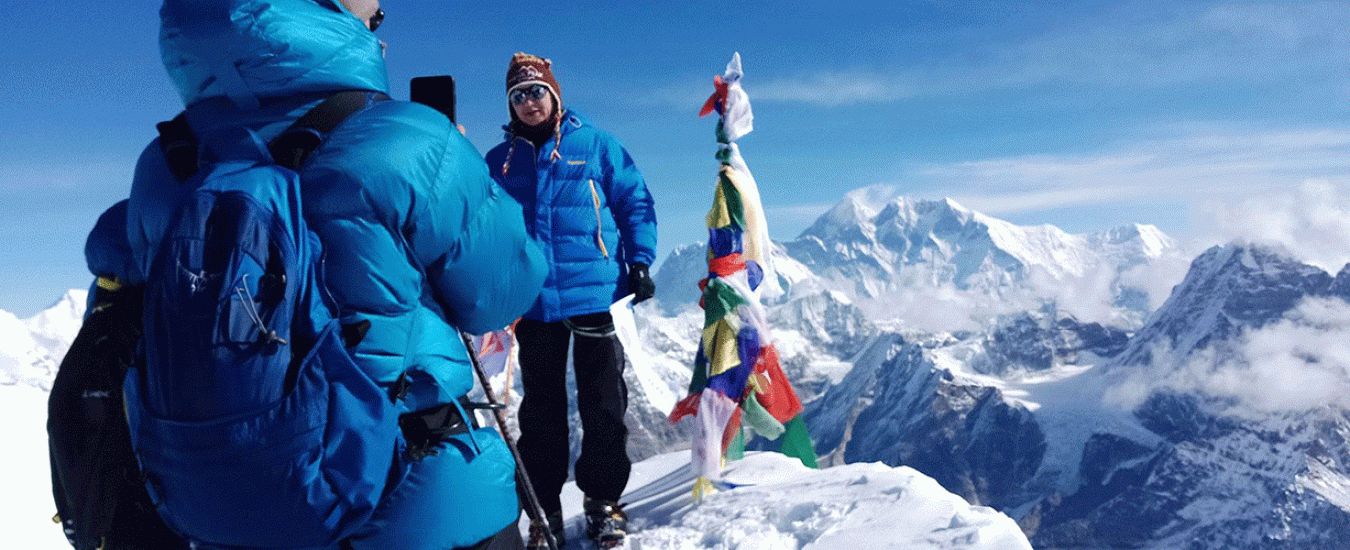
Frequently Asked Questions
Why trek with hillary step treks.
Hillary Step Treks is regarded as one of the best trekking companies in Nepal. We have extremely experienced staff who have viable knowledge of all the treks and tour operations in Nepal. They have a reputation for successfully leading different types of treks and providing you with different types of services to make your stay memorable.
We are also an extremely charitable company that focuses on giving back to the community by getting involved with several cultural, religious, and eco-friendly activities.
Do I need to hire a guide and porters during my trek?
As of April 1, 2023, a new rule requires that visitors to any trekking spots in Nepal must hire at least one guide. This regulation aims to enhance safety and security for tourists, addressing the rising concerns regarding tourists going missing or requiring rescue. Guides help you explain more about the region, help in securing lodges, and hotels, and can even help you get helicopter rescue.
In the case of porters, although hiring them is not compulsory it is recommended. The porters carry heavy loads and have access to yaks, mules, and other animals to carry heavy loads of entire groups. They are also familiar with the local area and will help you in case of any type of emergency.
Can your guides speak English?
Our guides speak English fluently to ensure effective communication throughout your journey. They will share intriguing stories, traditions, and folklore of the mountains, making your experience more enriching. Furthermore, they will help you converse with locals as most shopkeepers and teahouse hosts may not be able to speak English.
Can I get an arrival visa in Nepal?
For any foreign nationals, you must apply for a visa to enter Nepal. Citizens from many countries listed on the Nepal Tourism Board can also get their visas on arrival. You just have to fill up the Nepal Visa application form at the Nepal immigration website.
To get your application verified you must submit certain documents like your original passport and at least one passport-size photo. Now pay the visa charge fee listed below and within a few hours your Nepal visa will be on your hand.
- Visa fee for up to 15 Days: USD 30
- Visa fee for up to 30 Days: USD 50
- Visa fee for up to 90 Days: USD 125
Do I need to add extra days as delays while booking to/from Nepal?
It’s always wise to add a day or two before and after your intended trek to cover the possibility of delays. Sometimes an unforeseen situation arises like flight delays and cancellations so it is wise to cover those days by booking a couple of days early.
The extra days or time will also give you time to purchase any necessary clothing. Gears or equipment if you need it. You must also keep in mind that Hillary Steps Treks is not responsible for missed international flights or delays.
Which is the best season for trekking in Nepal?
The best season for trekking in Nepal is generally a debate between Autumn or Spring. The months of September to November fall under the autumn season and the months between March to May fall under the Spring Season. During these two seasons, the temperature and weather are moderate to trek and there is less chance of rainfall and snowfall.
In certain Himalayan areas, the Winter season is also considered optimal for trekking. During the winter season, the temperature drops considerably below freezing point and there are chances of regular snowfall and snowstorms. Monsoon season is the worst of all the seasons because of continuous rainfall.
Do I need any kind of experience to trek in Nepal?
Trekking in Nepal presents challenges, yet it is not impossible. The difficulty of treks varies based on the region and the type of trekking you choose. While prior experience can enhance your adventure, it is not essential.
In recent times you must hire at least one authorized guide with you. These guides will help you in any kind of emergency or medical help. You can also hire porters from the local area to make your experience even more enjoyable and distribute your burden. With the assistance of guides and porters, completing a trek in Nepal is easily achievable even without prior experience.
Do I need permits for trekking in Nepal?
Yes, You need some important permits for any kind of trekking in Nepal. First of all, you need the TIMS Card which is also known as the Trekkers Information Management System which records all the data of the trekkers and tourists visiting the country. This card is mandatory for any type of trekkers who want to trek in any region of Nepal.
If you’re planning to trek in a conservation area, you’ll need a permit for that area. For example, if you are trekking the Everest region you must issue a Sagarmatha National Park permit and if you are visiting the Annapurna region then you need Annapurna Conservation Area Permit. There are few other trekking permits for other trekking regions in Nepal.
Trip Review
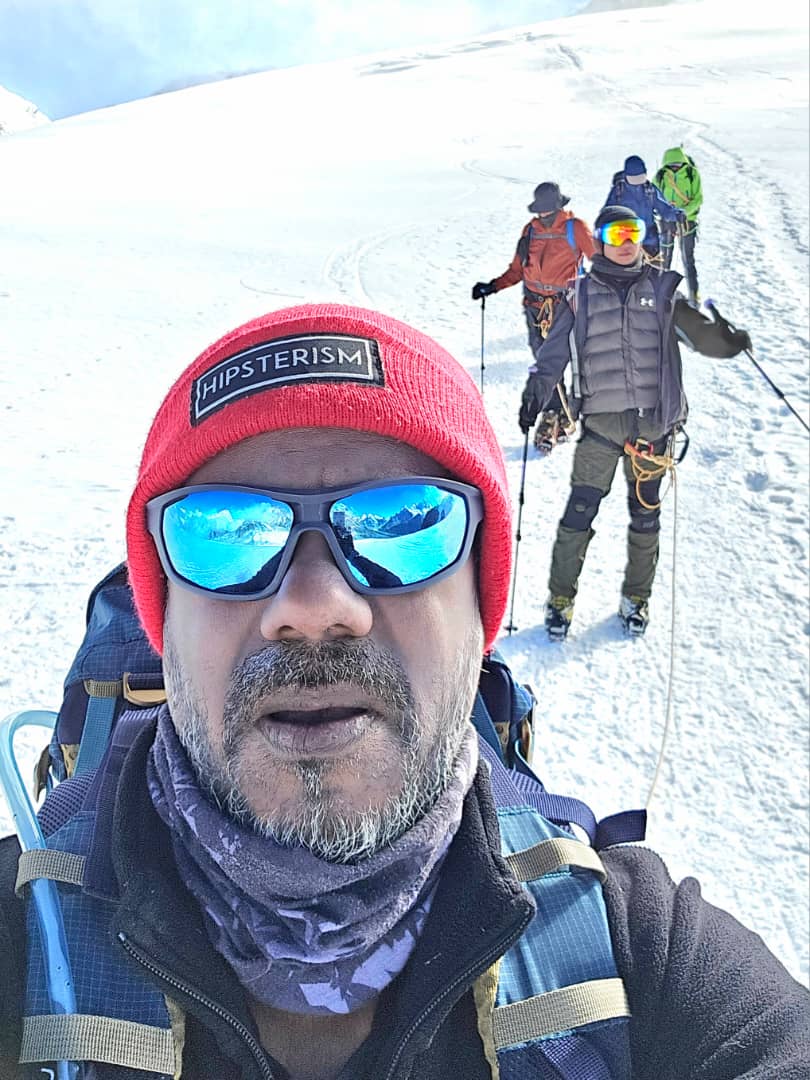
Travel Year : 2023 Sadik YB Malaysia
A personal touch of a very best and friendliest service. Hillarysteptreks.com is simply the best.
Travel Year : 2023 Lim Chak Meng Malaysia
Together We Attaining New Heights ( Mera Peak Climbing 17th Sep 2023)
Review trip, similar trips.

Island Peak Expedition
Island Peak Expedition (6,160 m) is a perfect destination to expedite in the Himalayas. Locally it is named “Imja Tse” but worldwide popular as Island…

Modarate - Challenging
Imagine yourself at the base camp of the world’s highest mountain, Mount Everest, surrounded by snow-capped mountains and massive glaciers. What an amazing feeling it…

Everest Base Camp with Island Peak Climbing
Everest Base Camp with the Island Peak Climbing is an adventurous trekking ideal for seasoned trek enthusiasts. This challenging trek takes you to the top…
Trip Inquiry

Discover the essential travel requirements for Nepal, including visa procedures, current travel restrictions, and health and safety guidelines. Our travel expert will guide you through the latest entry requirements based on your departure country and passport, ensuring you’re prepared for your Himalayan adventure.

- Best Hikes In The World
- Appalachian Trail
- European Hikes
- Nepal Hikes
- Patagonia Hikes
- See All Hikes
- Mount Kenya
- Mount Kilimanjaro
- Mount Toubkal
- See All Mountains
- South Africa
- New Zealand
- Switzerland
- United Kingdom
- Packing Lists
Mera Peak Climb – The Highest Trekking Peak In Nepal
Asia , Nepal
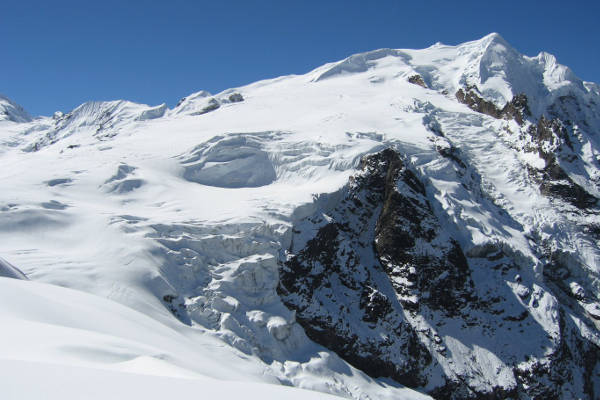
Mera Peak is widely regarded as the one of the highest trekking peaks in Nepal . The trek is suited for experienced high-altitude trekkers but does not require technical climbing skills as slopes rarely exceed 40 degrees.
It is an Alpine Grade F (easy) except for the final 30 or 40 metres, which are Grade PD (not very hard). Its ease is what attracts many hikers to it, but don't underestimate it's difficulty.
On this page, you will find a comprehensive and impartial guide to the Mera Peak climb.
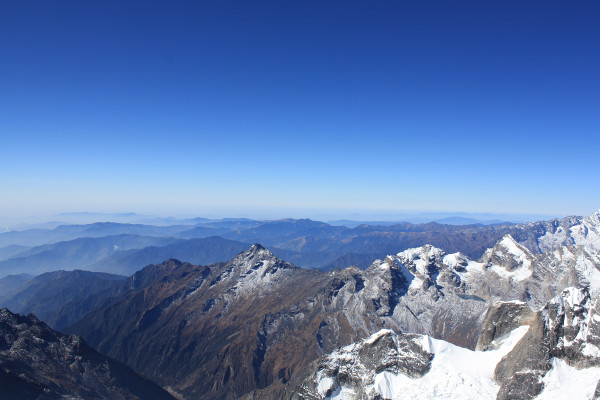
Mera Peak Trek
Trekking to Mera Peak (21,247 feet) will see you crossing glacier terrain.
Although the climbing is straightforward, it is physically demanding. Heavy snow can make things much more so, as do the potential exposure to crevasses. Use of an experienced guide is important.
From the summit of Mera Peak, you will be able to see five of the six highest mountains in the world : Mount Everest (29,029 feet), Kanchenjunga (28,169 feet), Lhotse (27,940 feet), Makalu (27,825 feet), and Cho Oyu (26,906 feet). This is perhaps the most stunning view from a trekking peak in Nepal. You can see as far as India!
The most appealing feature of the Mera Peak climb is the beautiful and uninhabited Hinku Valley, which is filled with a lovely forest. You will rest under mammoth magnolias and pass immaculate forests with banks of raspberries and strawberries.
The trek takes from 16 to 22 days. Outside of Kathmandu and Lukla, you will be spending most of your nights in a tent or basic Nepal tea house . Most groups camp despite there being tea houses all along the trail, a recent phenomenon. As recently as 1994, there was no more than a yak herder’s hut at Tangnag.
Please Note: The Mera Peak hike ascends to some high-altitude points. At its highest point, Mera Peak summit, you will reach an altitude of 6,476 meters (21,250 feet). There are steep sections on this trek where you will ascend very rapidly. It is important to have a clear understanding of the risks associated with high altitude trekking and how the body acclimatises to high altitude.
Where Is Mera Peak?
Mera Peak is situated on the eastern edge of the Khumbu region, which is the orange square below.
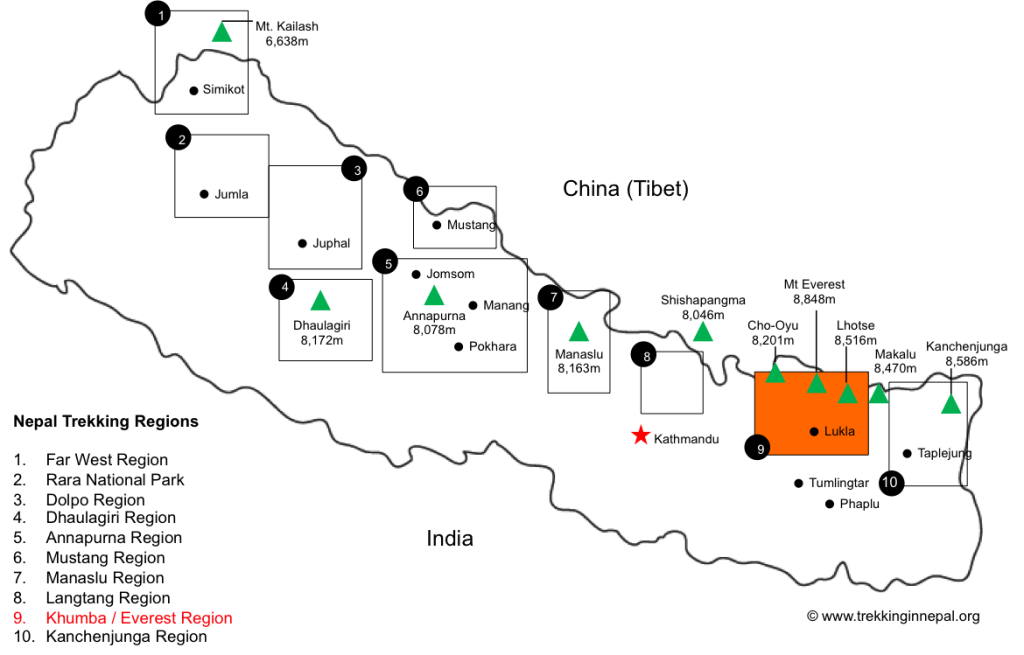
Mera Peak Map
We recommend the following map for Mera Peak - Island Peak/Mera Peak: Climbing and Trekking Map by Sandra Greulich and Sacha Wettstein.
Mera Peak Itinerary
Below is a detailed Mera Peak itinerary. Please note that there are several Mera Peak trek itineraries that can be done.
Below we have laid out the most popular version – 21 days, leaving from Kathmandu.
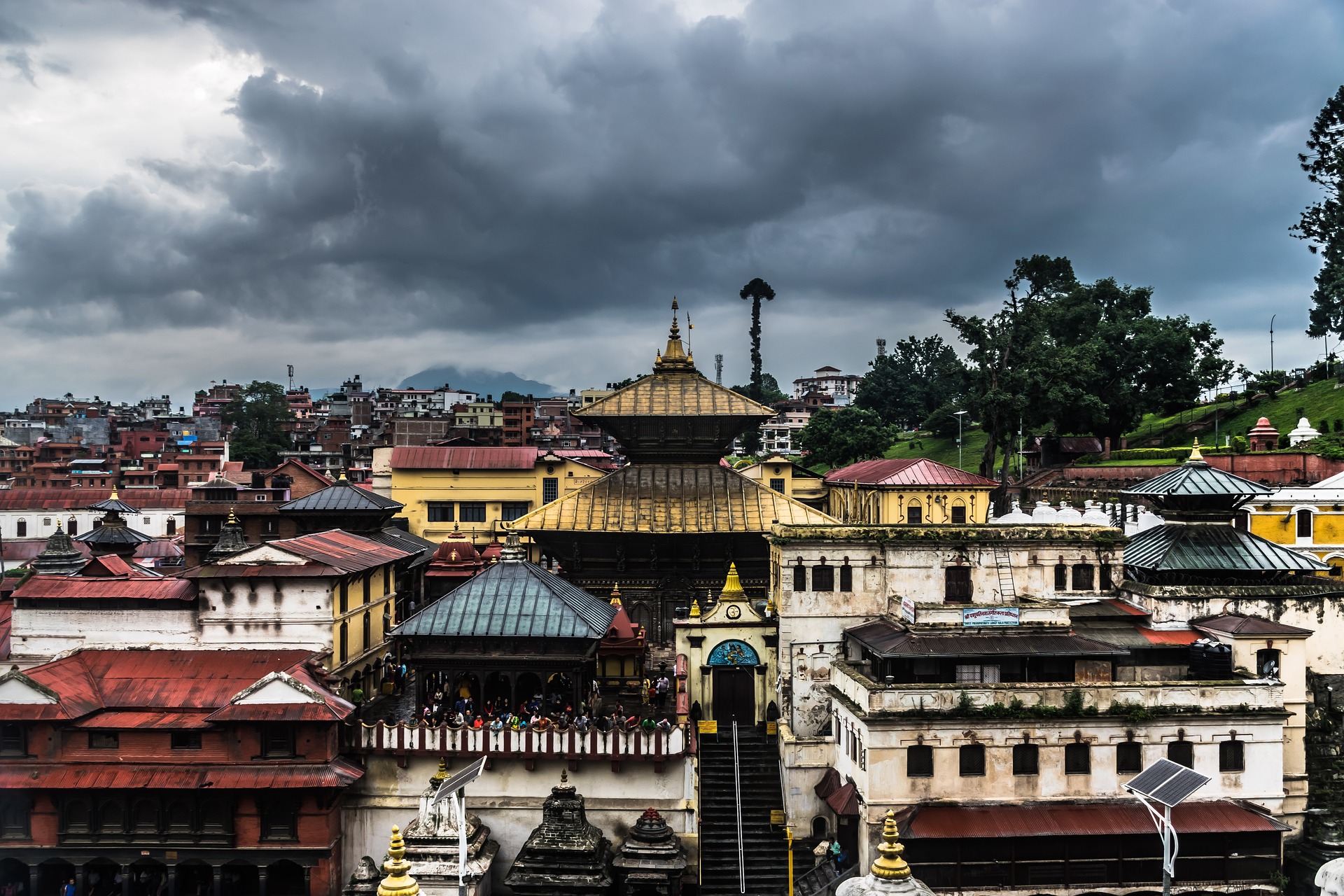
Day 1-2: Kathmandu
You arrive in Kathmandu. Flights are generally overnight, perhaps via Dubai or another Gulf state. I recommend spending a day or two in Kathmandu, there are lots of things to do and see in Nepal .
Day 3: Kathmandu to Lukla
You fly to Tenzing-Hillary, the infamous landing strip at Lukla, taking 40 minutes, and then it is time to walk.
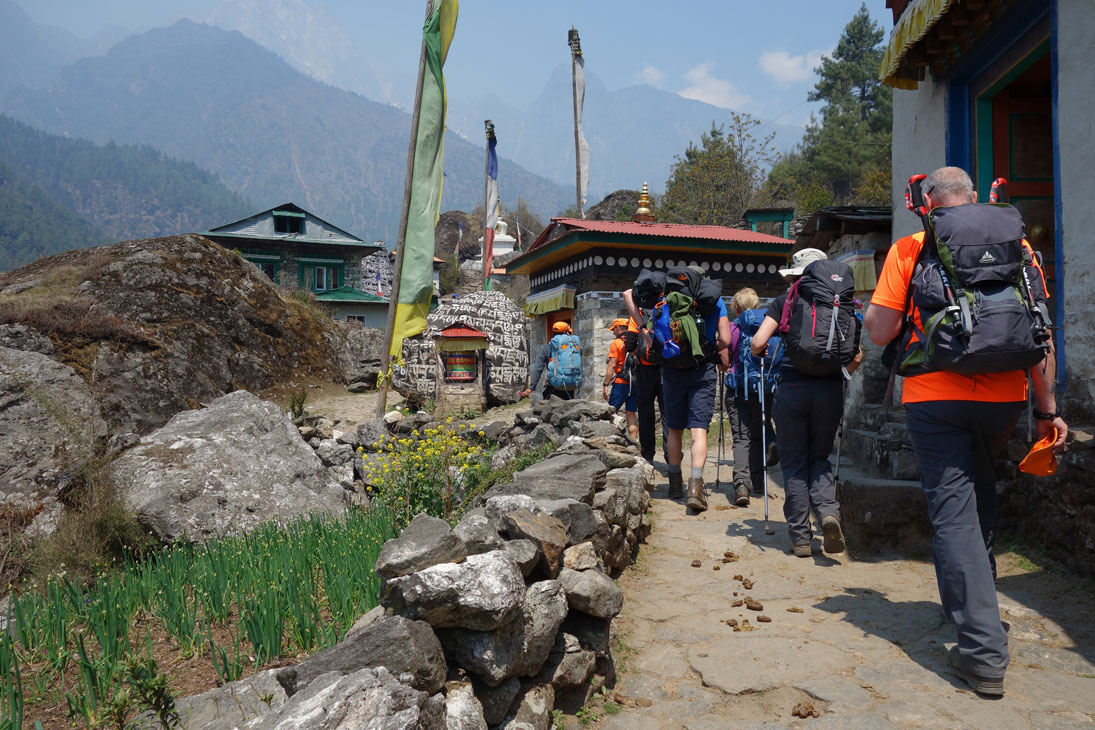
Day 4: Lukla to Pangkongma
You cross the Poyan Khola pass, with Khara Khola in the distance. You make it to Pangkongma.
Day 5: Pangkongma to Nashing Dingma
You ascend to Pangkongma La pass, granting you your first good views of Mera Peak. You then trek down into the Hinku Valley, cross a river using a wire bridge and ascend to Nashing Dingma.
Day 6: Nashing Dingma to Chalen Kharka
You climb to Chalen Kharka through the Surke La pass. Despite being 11,800 feet above sea level, there is still vegetation including rhododendrons and fir trees.
Day 7: Chalen Kharka to Chunbu Kharka
Today, you hike over rough ground. Jannu and Kanchenjunga can be seen. Jannu, 25,295 feet high, is the 32nd highest mountain in the world. Kangchenjunga is rather more impressive: the third highest mountain in the world at 28,169 feet. When you get to Chunbu Kharka, you camp.
Day 8: Chunbu Kharka
This day is for acclimatisation. If you are of an energetic disposition – many nearby walks are possible.
Day 9: Chunbu Kharka to Hinku Valley
Today you trek back to the Hinku Valley once more. You pass the site of flooding in 1998 that resulted from a dam giving way after an unusually strong earthquake.
Day 10: Hinku Valley to Tangnag
You cross a river and, passing grazing yaks, ascend to Tangnag. There are some wonderful tea houses here.
Day 11: Tangnag to Hinku Nup Glacier
You rise above the tree line and ascend Dig Kharka-wards (15,520 feet). This is near the Hinku Nup glacier .
Day 12: Hinku Nup Glacier
By day, you walk onto the glacier to be instructed in the use of crampons and axes, which will be indispensable when you tackle Mera La and Mera Peak.
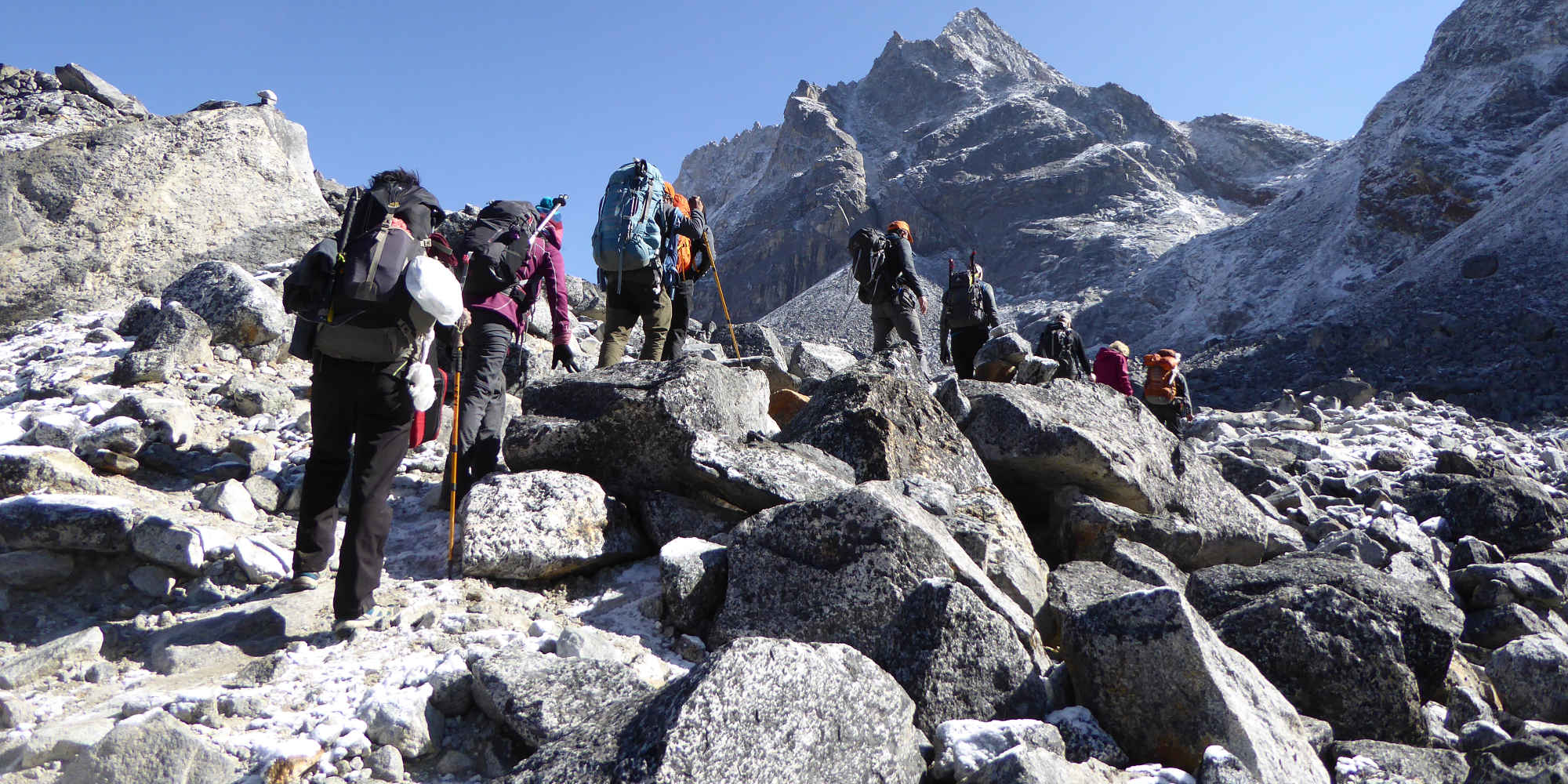
Day 13: Mera Peak Base Camp
Today you arrive at Mera Peak Base Camp.
Day 14: Mera Glacier
Ice school continues on the Mera glacier.
Day 15: Mera Peak
Several crevasses must be crossed to reach the high camp.
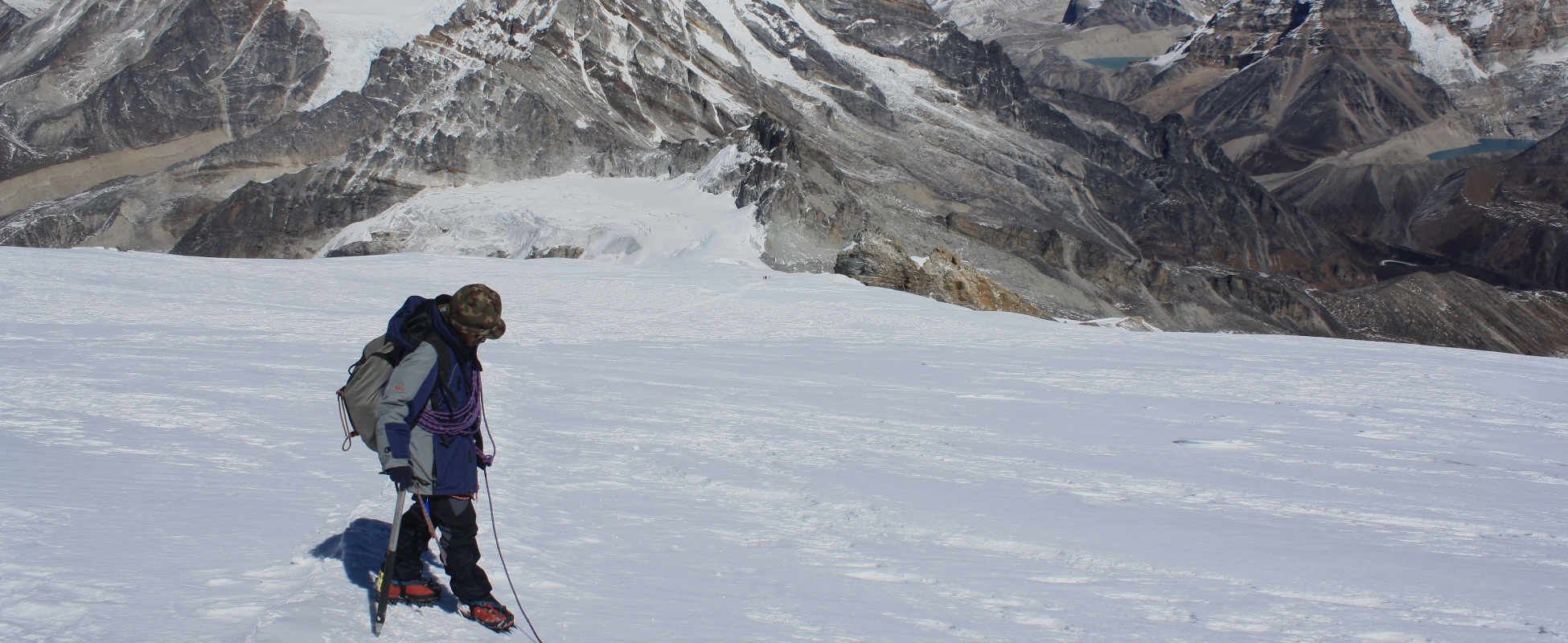
Day 16: Summit Mera Peak
After fixing ropes, you reach the summit of Mera Peak and then descend to Base Camp again.
Day 17: Mera Peak
This is a spare day in case of foul weather.
Day 18-20: Mera Peak to Lukla
You return to Lukla, which could conceivably take as little as three days. From Base Camp, you cross the Zanwa La pass (15,090 feet) and then drop – this is steep – to the Dudh Kosi Valley on the way. You might avail yourself of Lukla’s bars.
Day 21: Lukla to Kathmandu
You fly to Kathmandu.
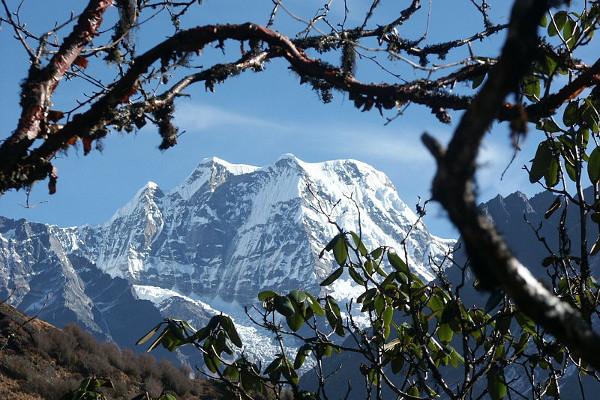
Mera Peak Hike FAQ
When is the best time to trek mera peak.
October and November are the best times to trek Mera Peak. These months are peak months for trekking in Nepal . December and particularly January and February are mostly regarded as excessively cold. Trekking the Mera Peak begins again in March and April, which coincides with the Mt Everest climbing season .
How much does the Mera Peak Trek cost?
A Mera Peak climbing tour costs anywhere from $3,500-$5,000 per person depending on group size and Nepal trekking agency . We highly recommend seeking out a quality operator.
Are permits required for Mera Peak?
Yes, a permit is required for Mera Peak, which costs $350 for as many as four people.

How difficult is the Mera Peak trek?
The Mera Peak trek is considered a moderately difficult trekking peak. Slopes rarely exceed 40 degrees and you will be told everything you need to know prior to climbing the actual peak. Saying this, a very good level of fitness is required and experience of trekking at high altitude is recommended, as the trek is both long and often through heavy snow.
Is altitude sickness a risk on the Mera Peak trek?
Altitude sickness is a risk on the Mera Peak Trek as it ascends to some high-altitude points. At its highest point, Mera Peak summit, you will reach an altitude of 6,476 meters (21,250 feet). There are steep sections on this trek where you will ascend very rapidly. It's important to have a clear understanding of the risks associated with high altitude trekking , and how the body acclimatises to high altitude.
Are there any recommended books for Mera Peak?
For a great book on Mera Peak, we recommend Islands in the Snow: Climbing Nepal’s Trekking Peaks by Mark Horrell.
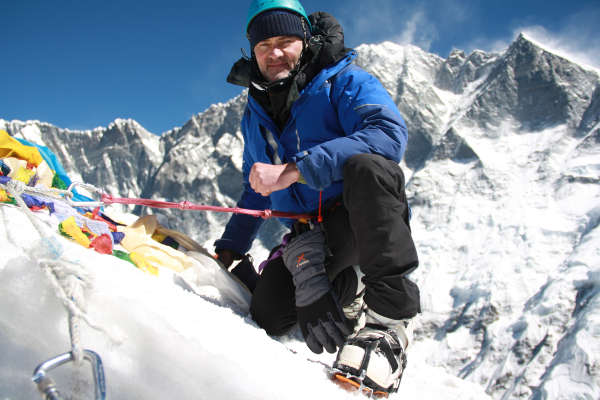
Tags: Mera Peak Nepal, Mera Peak climbing, Mera Peak trek, Mera Peak itinerary
Continue browsing
See more information on Nepal . Or check out these other Nepal hiking articles:
- Nepal hikes
- Short Nepal Hikes
- Beginner Treks in Nepal
- Food on the EBC hike
- Kala Patthar Trail
- Kanchenjunga Base Camp Hike
- Rara Lake Trek
- Annapurna Circuit Trek
- Hiking the Manaslu Circuit
- Helambu Trek
- Hiking the Mustang Circuit
- Gokyo Lakes Trek
- Makalu Base Camp Trail
- Gosainkunda Trek
- Hiking the Limi Valley
- Island Peak hike
About the author
Mark Whitman
Mark has trekked extensively in Asia, Europe, South America and Africa. He founded Mountain IQ in 2014 with the sole aim to be the best online information portal to some of the most popular mountain destinations around the world. When not writing for Mountain IQ, Mark is out exploring the outdoors with his wife!
Leave a Reply
Your email address will not be published. Required fields are marked
We work with local guides to offer great value adventures at unbeatable prices

- You are here:
- Destination
- Peak Climbing in Nepal
Mera Peak Climbing - 18 Days
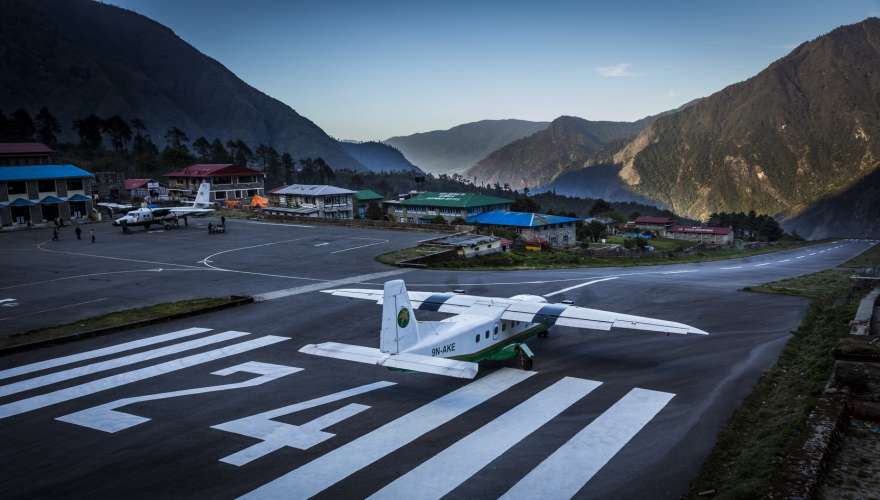
- Trip Duration 18 Days
- Difficulty Level Moderate - Strenuous
- Best Season Spring & Autumn
- Max Altitude 6480 m
Mera Peak (6480 m) is the highest of trekking peaks in Nepal located in SoluKhumbu district in the Everest region’s eastern part of Nepal. It is a very high mountain although it is a normal climb that requires no technical climbing on this route. One can experience its climb with an average fitness even though no previous experience of climbing.
Mera Peak Climbing 18-Day itinerary is a perfect itinerary designed for all the groups of climbers from begging to experienced adventure enthusiasts. Our guided trip is eighteen days long including some spare days for the acclimatization along the way and it’s completely flexible to attempt the summit in terms of the weather and preparation factors.
We organize this exciting small group and private tour every Spring ( March-May) and Autumn (September-November), our focus has been always on a small group of climbers with moderate climbing and hiking experience looking to try a snowy summit in Nepal which is not a technical but which requires basic alpine skills. Our success rate with small groups is 99 percent since we have been organizing the climbing trip to Mera for almost one and half decades.
However, we also organize private trips for solo travelers with a private guide (one-on-one ratio) at a reasonable price. We have open dates for solo travelers or small groups of friends to sign up, book the tour with a sky-high offer today. Remember, on our guided 18 days Mera peak climb itinerary, we provide a highly experienced local trekking guide for a group or solo travelers and porter (1 porter for every 2 trekkers), and one climbing guide for every 2 climbers during the climb from the Khare or Mera Peak Base Camp.
During the trek to Khare, we accommodate you at the tea houses or trekking lodges along the way, and from Khare to High camp or Basecamp, we provide tents for sleeping and clocking tents where we will prepare all your foods including breakfast, lunch, and dinner.
CLIMBING MERA
The multiple-day trek into the peak provides us a great chance to enjoy all aspects of the Himalayan experience, from the lush green forests of the lower Khumbu region before crossing high passes and making your way up into the more sparse and rocky upper reaches. As we near the northern approaches of the peak we pass steep glaciers plunging into spectacular lakes behind huge ridges of glacial moraine.
We use a high camp for this peak so experience camping on the snow and keeping warm, dry, hydrated, and well-fed is important to ensure you're in the best shape for summit day. We have plenty of time on the walk-in, which is stunning, to practice the skills needed. If you're unsure of your suitability do feel free to contact us for a chat at [email protected]
TERRAIN ON THE TREK AND CLIMB OF MERA PEAK
The walk starts by heading south from Lukla and our altitude certainly fluctuates as the path ascends and descends the valleys of the region. Underfoot we have well-trodden paths which at times can be rocky, slippy if wet, and uneven in parts. Our itinerary uses and longer trek in to allow for really good acclimatization and a shorter route back to Lukla after the climb.
Once on the mountain itself, there will be scrambling at times on quite loose rock to below the snow line. Once on the snow, the route can vary depending on local conditions at the time and if required you will be roped up in groups of three or four. The terrain is not difficult but it does require care and alertness. The route is normally well marked, and groups tend to follow a similar 'path'. The terrain requires no technical climbing, but you will need to use winter skills and equipment (ax, crampon) when on the snow, which you will practice on the trek in.
- Enjoy a scenic mountain flight to Lukla from Khathmandu
- Ideal first Himalayan climb into the heart of the Himalayas
- Challenge yourself at altitude with your local private guide!
- Enjoy the trek through the beautiful villages of Khumbu Nepal as it involves a culturally stimulating journey through remote picturesque villages and forests, followed by a gentle climb to the summit.
- Nepal’s highest trekking peak- Mera Peak (6480 m)
Day 1: Arrival in Kathmandu
Welcome to Nepal! Our friendly driver and an airport representative will greet you and pick you up from the airport and transfer you to the hotel. We can then spend the rest of the day taking a rest. In the evening, we get to try Nepalese cuisine at a welcome dinner hosted by ART. Overnight in Kathmandu.
- Accommodation: Hotel
- Meal: Breakfast
- Maximum Altitude: 1,350m/4,429ft
Day 2: Kathmandu: trip preparation
We’ll get an early start today to enjoy the best sights and attractions that Kathmandu has to offer. This morning, you’ll join an exciting sightseeing tour of the city’s many UNESCO World Heritage sites. You’ll visit the enormous Buddhist stupas of Swayambhunath and Boudhanath, where Buddhists and Hindus alike come to show their devotion. You’ll also visit the splendid temple of Pashupatinath on the banks of the Bagmati River, which is dedicated to the Hindu god Shiva. And you won’t want to miss the many pagoda-style temples which comprise the world-famous Kathmandu Durbar Square. In the afternoon, you’ll meet back up with your guide to check your gear and make any final arrangements for your upcoming trek. After dinner, you’ll spend one more night in your hotel.
Day 3: Fly to Lukla, trek to Paiya (Chutok)
On the first day of our trekking toward the mountains. We catch an early morning flight to Lukla and begin our trek to Paiya after landing at the Tenzing-Hillary airport in Lukla (2840 m). The trail as we walk on a jungle trail, cross a bridge over the Handi Khola and reach Surke Village. From here we continue moving south and cross the Chutok La pass before reaching the small settlement of Paiya where settle our first night over stay at this peaceful place.
- Accommodation: Tea House/ Trekking lodge
- Flight: 35 min
- Meals: Breakfast, Lunch and Dinner (Included)
- Maximum Altitude: 2,800m/9,187ft
Day 4: Paiya to Panggom
After taking our first breakfast in the mountain, We descend for a while and reach a small bridge. From here the trail is slippery until we cross the Kari La pass. We walk through rhododendron and bamboo forests on a narrow mountain trail. On today’s trip, we also get to be in awe of the Dudhkoshi Valley. We continue our trek to Panggom Village whose settlers are dependent on farming and trading. Overnight in Panggom.
- Trekking time: 5-7 hrs
- Maximum Altitude: 2,846m/9,338ft
Day 5: Panggom to Ningsow
We begin our trek after breakfast. Approching to cross the Panggom La pass. Then we ascend, walk on a steady path and turn north. We cross Peseng Kharka Khola first then after walking for some time, reach Peeng Kharka Danda. We cross Ningsow Khola (stream) before reaching the Ningsow Village. Overnight in Ningsow.
- Trekking time: 4-5 hrs
- Maximum Altitude: 2,863m/9,394ft
Day 6: Ningsow to Chhatra Khola
After breakfast, We start trekking From Ningsow, we climb first then descend for a while and climb some more to reach Ramailo Danda. From here we get extraordinary views of Mera Peak and Salpa. After ascending and descending our trail, we enter the Makalu Barun National Park. Our trail from here to Chhatra Khola is called Pasang Lhamu trail. On the way, if we are lucky, we might even come across the elusive Red Panda. Overnight in Chhatra Khola.
- Trekking time: 7-8 hrs
- Maximum Altitude2,800m/9,187ft
Day 7: Chhatra Khola to Kothe
After breakfast, We walk towards the north on the main trail to Mera Peak. After walking on a trail next to the Majang Khola, we merge with another trail that moves alongside the Hinku Khola. Our trail moves straight ahead towards Tashing Ongma which has seasonal tea shops. We continue our trek and cross the bridge over the Sanu Khola before reaching Kothe. Overnight in Kothe.
- Maximum Altitude: 3,691m/12,110ft
Day 8: Kothe to Thaknak
After breakfast, start trekking along the ridge of the Hinku Khola in the shadow of Mera Peak. We take lunch at Gondishung, the summer herders’ settlement on the west bank of the Hinku Drangka. Beyond Gondishung, we pass a 200-year-old Lungsumgba Gompa where we can find Mera Peak scripted in rock along with its route to reach Mera. A short walk takes us to Thaknak, which is a summer grazing area with primitive lodges and shops. Overnight in Thaknak.
- Trekking time: 3-4 hrs
- Maximum Altitude: 4,358m/14,299ft
Day 9: Thaknak to Khare
We leave the Thanknak after breakfast, we follow the lateral moraine of Dig Glacier to Dig Kharka, which offers spectacular views of Charpate Himal. The trail climbs through moraines to the snout of the Hinku Nup and Shar glaciers and then climbs more steeply to Khare. From here, we can see the northern face of Mera Peak which will be an amazing experience. After lunch, we can hike in and around Khare. Overnight at Khare.
- Trekking time: 2-3 hrs
- Maximum Altitude: 5,045m/16,553ft
Day 10: Khare: Acclimatization and pre climb training
We have a separate day set aside solely for acclimatization and basic training just to prepare ourselves better for the Mera Peak climb. Our climbing leader will help us polish our basic climbing techniques and demonstrate the best ways to use our climbing gears like the ice axe, harness, ascender climbing boots, and crampons. The training will also include learning the best climbing technique with the rope. Overnight in Khare.
Day 11: Khare to Mera High Camp
Today's our walk through a boulder-strewn course on a steep trail to reach the Mera Peak Base Camp. From here, we continue further through the Mera La pass to reach the Mera High Camp. Our path is along a rocky trail, which can be hazardous if it has recently snowed, as there are a number of crevasses here. We make our way to the top of the rock band, which is marked by a large cairn. Then we set up a high camp while enjoying excellent views of Mt. Everest, Makalu, Cho Oyu, the south face of Lhotse, Nuptse, Chamlang, and Baruntse. Overnight at Mera High Camp.
- Maximum Altitude: 5,780m/18,964ft
Day 12: Mera High Camp to Summit and back to Khare
Today is a really important day for the expedition. We wake up very early in the morning around 2 in the morning for breakfast. It’s going to be very cold in the beginning but soon we warm up as we continue up the glacier and onto a peculiar ridge. The first rays of the sun hit the big peaks in an amazing red glow. The route is still non-technical as we slowly climb higher into the ever-thinning air. The slope steepens for a section behind the ridge and the summit comes back into view. At the foot of the final steep summit cone, we may use a fixed rope if the climbing leader believes it’s required. The summit is only a few meters away. From the summit, we take in spectacular views of the mighty Himalayas including Mt. Everest (8,848m), Cho-Oyu (8,210m), Lhotse (8,516m), Makalu (8,463m), Kangchenjunga (8,586m), Nuptse (7,855m), Chamlang (7,319m), Baruntse (7,129m) and others. Later, we retrace our steps back to the high camp where we rest for a while before descending to Khare. Overnight in Khare.
- Trekking time: 8 hrs
- Maximum Altitude: 6,461m/21,199ft
Day 13: Reserve Day for Contingency
Weather in the Himalayas is quite unpredictable. Hence, it is good to take on a contingency days considering unfavorable weather or any other obstructions that might delay the group in climbing the peak. If the group summit the peak on the planned date and everything goes well, this day could be cut off from the itinerary.
Day 14: Khare to Kothe
After our breakfast at the Lodge, We will continue our descending trail on this day from Khare to Kothe. The beautiful routes pass through incredible courses. We will make some ascents before descending for a few hours to arrive at Kothe's settlements. After walking the natural terrains for 4 hours approx, we will reach the destination for the day. We will then spend the night at a teahouse in Kothe from the destinations. There you can socialize with fellow trekkers and rest for the night.
Day 15: Kothe to Thuli Kharka
After our breakfast, we Begin climbing up through the lush forest of Rhododendron, Bamboo, and Pine, on the west side of the Hinku valley to the Tuli kharka for your overnight stay.
Day 16: Thuli Kharla to Lukla via Zatrwa La pass
The last day walk of the adventure morning leads with a climb over the high ridge of Naulekh or Kalo Himal including Zatrwa Og and Zatrwa-La passes, after a tough long climb then descends to Chutanga into green areas and forest, where a few hours of the great walk takes you back at Lukla for final overnight around Khumbu and Everest area.
Day 17: Fly to Kathmandu
For the last breakfast in the mountain, we enjoyed our early breakfast and jump on our early morning flight to Kathmandu. After reaching Kathmandu, we can take a rest or do some souvenir shopping. If we want to explore any other areas of Kathmandu, we may do that today. Our guides can help you with both souvenir shopping and sightseeing. There will be a farewell dinner in the evening to celebrate the climbers’ successful summit of Mera Peak. Overnight in Kathmandu.
Day 18: Final departure
Our adventure comes to an end today. There is nothing to do but trade emails with your travel companions and organize your photos. A representative from ART will take you to the airport, approximately 2 hours before your scheduled flight with a beautiful farewell ceremony!
Trip inclusion
- Cost Includes
- Cost Excludes
- International and domestic Airport pick-up and drop-off and all
- ground transport private vehicles.
- Meals on a full-board basis (Breakfast, Lunch, and Dinner) during the trek and Climbing the mountain.
- A highly experienced and knowledgeable English-speaking trekking Guide
- A highly experienced and knowledgeable English-speaking climbing guide
- All Food, Accommodation, Transportation, Insurance, and transportation for the guides.
- All necessary paperwork: Sagarmatha national park fee, climbing permit, and TIMS card.
- 2-Night at a 3 Star tourist hotel in Kathmandu with breakfast.
- Special climbing permits for Mera Peak
- Round trip flight from Kathmandu – Lukla - Kathmandu including applicable departure taxes
- Water purification tablets to purify your water during the trek for a safe drink
- All Camping Equipment (kitchen tent, dining tent, toilet tent, table, chair, and kitchen utensils
- Trekking equipment such as the Sleeping bag, down jacket, etc.. on return basic
- Trekking lodge (Tea House) and tents during the trek and climbing periods.
- Group gears and supplies (ropes, ice screws, snow bars).
- Snacks (crackers) and Seasonal available fresh fruits during the trek.
- ART's Certificate of appreciation after the successful trip
- Farewell dinner at the best typical Nepalese restaurant along with the cultural performances
- Alpine Rumble's complimentary free T-shirt, route map, and duffel bags
- An Oximeter to monitor your oxygen and pulse at high altitudes.
- Basic first aid box including Diamox for the high altitude sickness
- Emergency rescue operation assistance in arranging in case of complex
- health conditions in the mountain (funded by Travel Insurance)
- All government, Local taxes, and official Expenses.
- Travel Insurance and any sort of rescue.
- Hot shower.
- Personal Expenses such as laundry, phone, internet, etc.
- All soft and hard drinks.
- Tips for guide, and staffs
Video & Photo Gallery
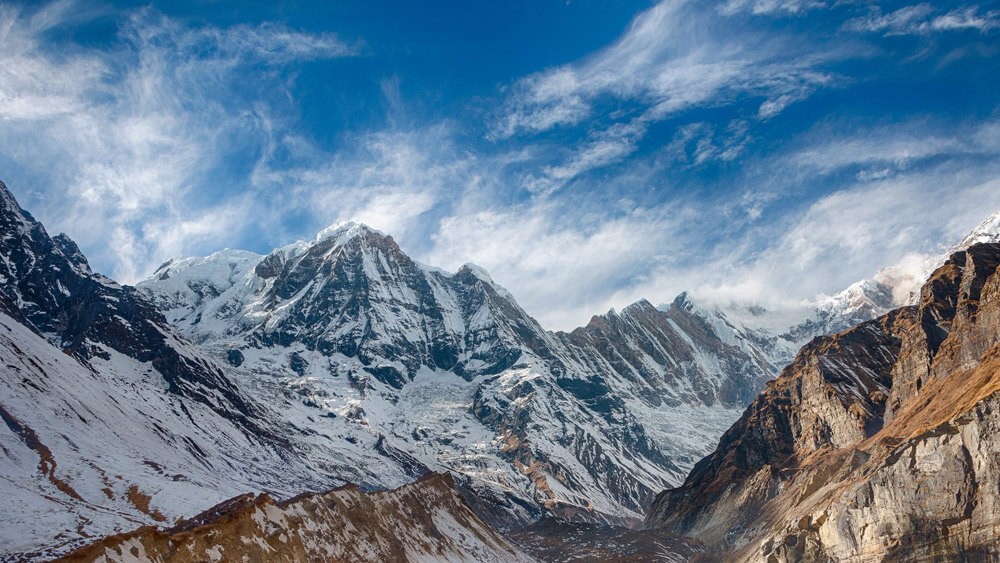
ACCOMMODATIONS
Before and after the climb, the accommodation on the trek is in comfortable tea houses or trekking lodges run by local families of the Sherpa people. Each tea house or lodge has a central communal area with a stove, while the bedrooms are unheated with two beds and blankets, mattresses, and pillows. The sleeping bag should be carried by us (it can be provided by the company). The lodges generally offer hot showers at request which are powered by gas and most of the places have buckets of hot showers rather than flush.
We stay 2-night in tents during the climbing process at the places of Mera Base Camp, and High Camp.
Meals
Meals on the trek are very convenient and of good quality, they can be found in a mixture of a variety of local and western recipes and food throughout the trek. Some of the most popular foods like Dal Bhat (typical Nepalese food) or Momos, Noodles, spaghetti, bread, soups, Chowmien, noodles are a great choice and burgers & chips are a common meal in Lower areas like Lukla. At Mera Peak base and High camp we will be staying in tents usually sleeping two persons per tent, a private tent will be provided for solo travelers.
We would recommend carrying a 4-season sleeping bag if you do not have your own then the company will be provided it to you.
NOTE: Kathmandu has a large range of luxury stars hotel offers to select for your stay. However, we will also be pleased to be part of this help to make the reservations for the 4 and 5-star hotel booking as well on request.
Passport and Visa
If you are traveling to Nepal you need to have a visa to enter Nepal. However, the arrival visa is available at Tribhuvan International Airport, Kathmandu where you can simply get an On Arrival Visa” and you must enter Nepal within six months from the visa issued date. Your total stay is counted starting from the day you enter Nepal.
Travel Insurance
In Safety reasons, Travel insurance is mandatory for trekkers in participating in any trek and tour programs on the mountains. Getting travel insurance, especially while traveling in the mountain areas is like security on which you can rely and enjoy your trip without any worries. We highly recommend getting good compressive travel insurance that covers things like emergency helicopter rescue, and medical evacuation expenses it will be assisted protection tour to cover personal injury, injury, repatriation expenses, and any kind of illness will be covered. Having good travel insurance will not only guarantee you peace of mind while you travel with us but also provide you with complete coverage for anything things that may go wrong.
Packing list for CLIMB MERA PEAK SHORT
The following lists are the essential trekking gear that is recommended for trekking in Nepal and all listed gears can also buy easily in Kathmandu, Kathmandu has a number of shops selling the necessary clothes and gear for trekkers.
CLIMB MERA PEAK SHORT Safety and Satisfactions
SAFETY IS OUR TOP PRIORITY- NOTHING IS MORE IMPORTANT THAN THE SAFETY AND HEALTH OF OUR CLIENTS AND EMPLOYEES.
On this trek, you will be accompanied by one of the experienced and friendly trekking guides/ Sherpa who originally come from the mountain (same region) of Nepal, the guide will be carrying all the essentials equipment with a first aid kit for safety reasons; we would like you to take some of your own personal mediation on this trek. However, in emergency cases, if our clients have any trouble with mountain sickness or any unforeseen circumstances then we will always be standing by to send a rescue helicopter to bring our clients back to lower places or Kathmandu.
Note: During the trek, make sure you are always in the safe zone of the place wherever you are while trekking on the mountain because you may encounter a number of mules, yaks are carrying the suppliers for hotels, Yaks Donkey and Jokpa use for the major transportations in the Himalayas region, as we always need to be aware with them, and stay at the safe place, especially at the narrow section of the trail.
Responsible tourism
Our experienced field staff/team strongly believes that we all are equally responsible to act in favor of the local culture and environment. We would like to follow the important role of following the rules.
please respect the local people and their laws, custom, and their beliefs
- Please always ask your guides for permission before doing something in the local community.
- please support the keep environment clean, wherever you would travel and dispose of rubbish
- Please help the local community to encourage the positive sides of tourism as long as possible.
- We Alpine Ramble Treks are involved in the Kathmandu Environmental Education Project (KEEP) and organize eco-friendly trips that teach to make the sustainable positive environmentally sensitive of both travelers and communities.
Booking and payment process
Alpine Ramble Treks (P) Ltd. is a government-authorized and registered trekking and adventure operator based in Nepal. The company registered number is 178805/074/075 . We are also associated with various local and international tourism associations, therefore, any adventure-interested persons are heartily welcomed to be booked and be part of our family now, we treat you as family members while traveling with us. we called mountain family, home away from home with us.
To process a trip booking with us, you're required to deposit 10 % of the full trip cost in advance to the prior time to make sure all the reservations such as Hotels, guides, trekking permits, transportation, etc. the remaining the payment can be easily made to us on your arrival by credit cards or in cash - cash would be much appreciated. At the same time, we would also like to request you to send us all your documents such as passport, travel insurance copies, and flight details at the time of booking.
Extra personal expenses on trekking
During the trek, all your foods are included in the package (Lunch, Breakfast, and Dinner with hot drinks), the foods will be served as per the package program and besides that, any personal and Barbier bills would be extra.
Last-minute booking
The last-minute booking can be made by any interested travelers a day before the trip gets started. Moreover, the payment should be made 100% if you are booking this for the last minute and the booking can be made directly through the online form or, by sending us an email, messages on Whatsapp, or by calling. But, Last minute booking may not be acceptable for Bhutan and Tibet trips.
Fitness and Experiences
For your personal safety and success, we recommend physical activities like running, swimming, and some smaller climbs to lower peaks which incorporate climbs that involve the use of crampons. Be prepared for extreme exposure and steep drop-offs and be capable of carrying around 30lbs/15 kilos. If possible, get some experience in technical rock and mountaineering climbing to prepare for your trek and climb to Island Peak. Be familiar with using other climbing equipment, such as jumar ascenders, crampons, and ropes.
Weather Forecast
During the climb, your guide will have access to current weather conditions. Any questions can be directed to ART. We are here to ensure you are well-equipped and prepared for this fantastic adventure
CLIMBING GEARS
Mountaineering Equipment Crampons, Ice ax, Helmet, Harness, Lock and unlock Carabineers, Shovel, Climbing pack, Rope, Ski poles, Desender/abseil device, Jumper (Ascender), Tapes, Prusik Loops, Rappel device, Hand Warmer (if possible)
Clothing and Wears
Trekking shoes with spare laces, Mountaineering Boots, Plastic or leather for mountaineering boots, Gore-Tex pants, Long shorts, Insulated Parka, Jumper, Waterproof Jackets, Down Jacket, Fleece Vest, Wool cap, Neck Gaiter, Gloves, Climbing Socks, Thermal Underwear, Sandals, Snow Goggle
Essential Gears
Backpack, Duffle bag, Sleeping Bag, sleeping pad, Tents
Map, Compass, Camera, GPS, Two-way radios, Binoculars, Head Lamp, Flashlight
Sun Protection Items Sunglasses, sun scream, Lip balm,
Other Essentials
Energy Bars, Water bottle, Water Purification Tablets, Toiletries, Trekking poles, Pocket knife, raincoat, Satellite Phone, Altimeter
We look forward to experiencing this trip with you soon!
Similar Packages
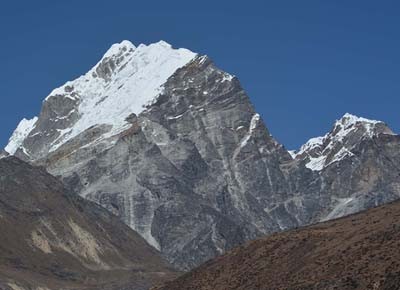
Lobuche East Peak Climbing with Everest Base Camp Trek
- from US$2499
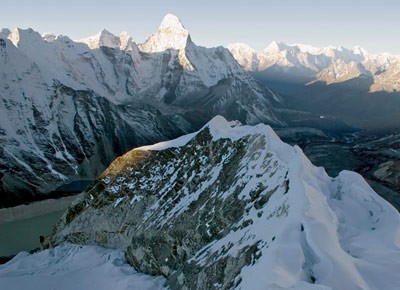
Island Peak Climbing 15 Days
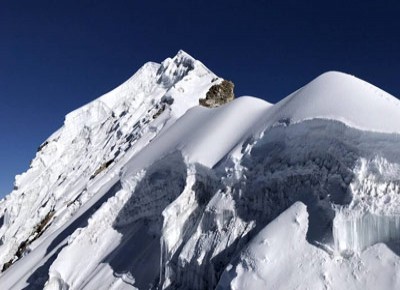
Island Peak Climbing with Everest Base Camp Trek
- from US$1999
Incredible Asia
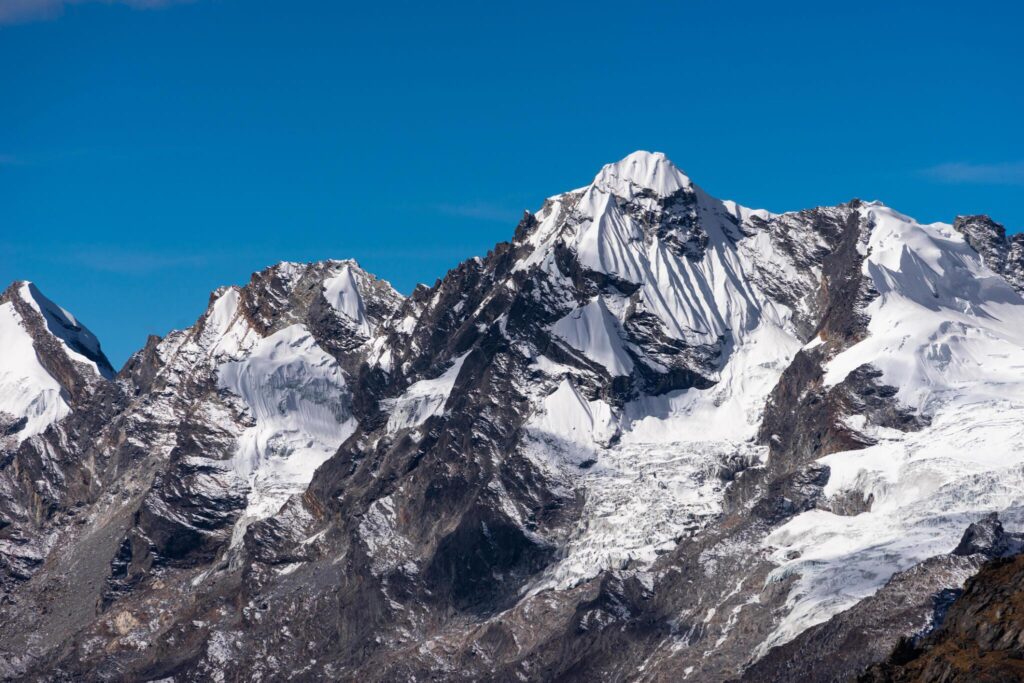
Mera Peak Trek: A Journey To Nepal’s Highest Trekking Peak
- January 2, 2024
MD. Mohaiminul Haque
As I embarked on the Mera Peak trek, determination and excitement quickened my pulse. Standing at Nepal’s highest trekking summit meant pushing my limits on an incredible Himalayan journey.
I pictured gazing down from dizzying heights upon snow-capped giants like Cho Oyu. The remote villages and Buddhist culture enriching the trail ahead promised memories to last lifetimes.
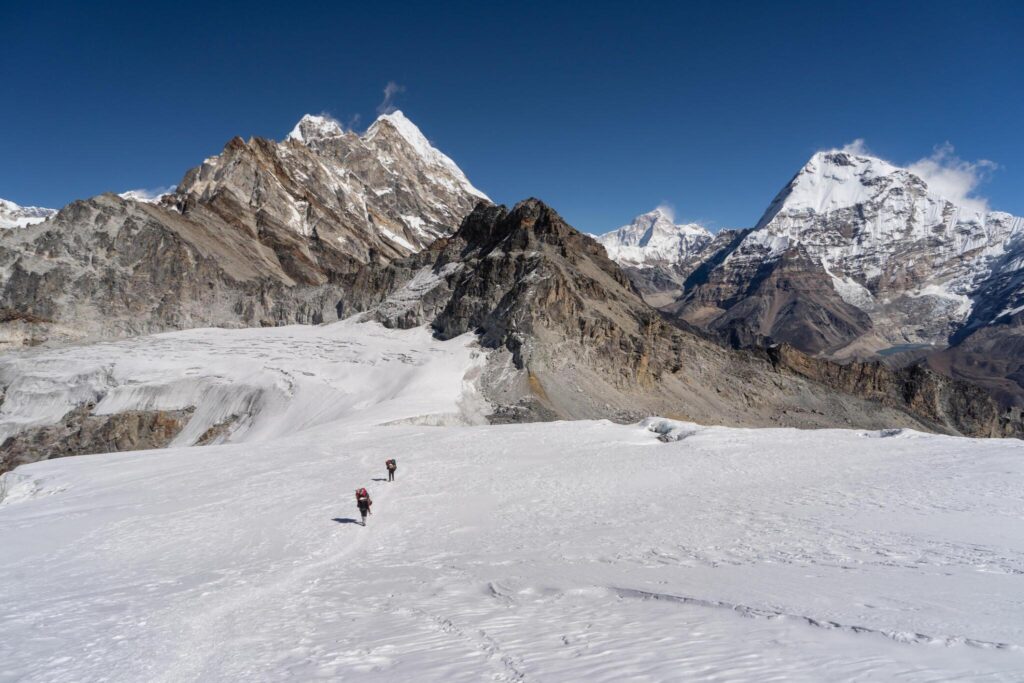
With my sights set on Mera’s thin air over 21,000 feet up, each step took me closer to views only the hardiest adventurers would ever savor.
This is just the beginning. Buckle up, because the next few paragraphs will take you on a whirlwind adventure you won’t soon forget.
Why Choose Mera Peak for Trekking?
Mera Peak stands out in the Himalayas for its unique appeal. Unlike other treks, it offers a blend of moderate challenge and stunning scenery. This trek is perfect for those looking to step into high-altitude climbing without extreme technical demands.
But the real cherry on top is the panoramic playground of five 8000m giants, including Everest . Imagine standing there, dwarfed by these legendary titans, their snow-clad shoulders brushing the sky.
It’s like peering into a postcard come to life, a kaleidoscope of glacial glint and wind-carved rock. Compared to this amphitheater of Everest and its kin, other treks feel like peeking through a keyhole.
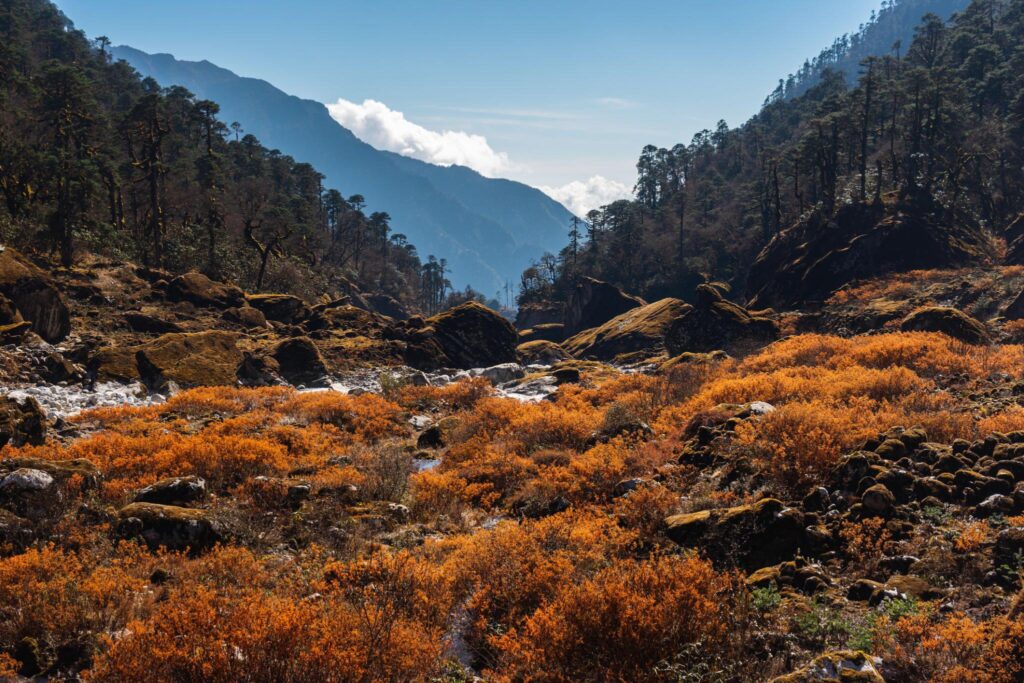
Preparing for the Mera Peak Trek
Conquering mera peak: gear up and get ready to fly.
Mera Peak beckons, but let’s be real, it’s no walk in the park. To stand triumphant on its summit, you need to prepare like a pro . So, let’s get down to the nitty-gritty:
Fitness First:
- Train Hard: Think uphill hikes, lunges, squats, and anything to build leg strength and cardiovascular endurance .
- Acclimatize Wisely: Slow ascent is key. Spend nights at increasing altitudes in the days leading up to the climb. Your body will thank you (and won’t reward you with altitude sickness!).
Gear Essentials:
- Warm Layers: Think thermal socks, fleece mid-layers, and a down jacket – layers are your friends!
- Sturdy Boots: Crampon-compatible and waterproof – your feet will be your loyal steeds, treat them well!
- Sun Protection: Sunglasses, sunscreen, and a hat – the Himalayan sun is no joke!
- Headlamp: For those pre-dawn summit pushes.
Don’t Forget:
- Trekking Poles: They’ll be your trusty balance buddies.
- Hydration Pack: Stay fueled and keep those vital fluids flowing.
- First-Aid Kit: Be prepared for anything, from blisters to minor cuts.
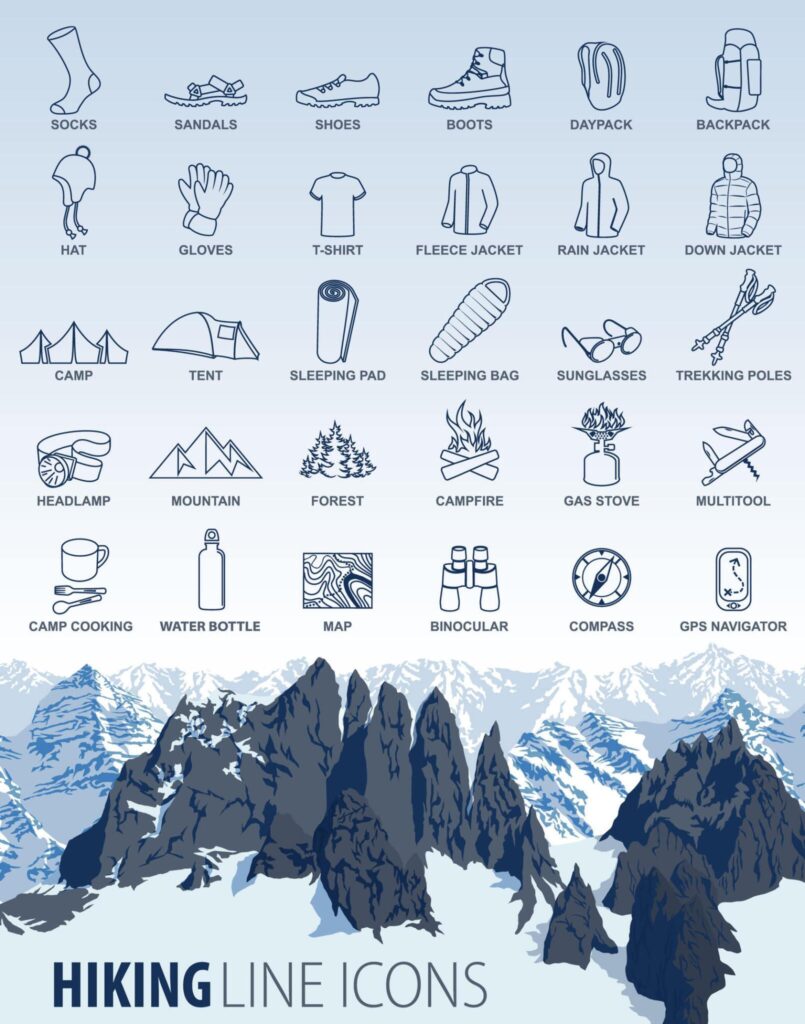
Consult with experienced trekkers or outfitters for a more detailed list specific to your needs and the time of year.
Ready to pack your bags and chase the horizon? The next part unveils the exciting journey that awaits, day by glorious step!
The Trek Outline (Travel Plan)
The trail to Mera Peak unfolds like a story with each day revealing a new chapter. Here’s a glimpse of the typical itinerary:
Days 1-2: Kathmandu Captivation: Breathe in the vibrant chaos of Kathmandu , explore ancient temples, and gear up for adventure.
Day 3: Lukla Landing: Take a thrilling flight to Lukla, the gateway to the Himalayas, and embark on your trek through verdant valleys and quaint Sherpa villages.
Days 4-8: Base Camp Bound: Trek through rhododendron forests, cross roaring glacial rivers, and acclimatize in charming villages like Kothe and Thaknak, soaking in the stunning Himalayan panoramas.
Day 9-10: Acclimatization Awaits: Rest and explore Khare Base Camp, venturing to Mera La for breathtaking views and preparing your body for the summit push.
Days 11-12: High Camp Heroics: Ascend to High Camp, nestled amidst the icy embrace of the Himalayas, and rest up for the ultimate challenge.
Day 13: Summit Showdown: Rise before dawn, strap on your crampons, and conquer the icy slopes of Mera Peak. Witness the sunrise paint the world in gold as you stand atop the “Queen of Himalayas.”
Days 14-17: Descent and Delight: Retrace your steps, relishing the familiar landscapes with a newfound appreciation. Celebrate your victory in Lukla before flying back to Kathmandu, your heart brimming with memories.
Remember, this is a flexible framework. Weather, individual pace, and acclimatization needs can influence the exact timing. But one thing’s for sure: every step on this journey will be an unforgettable encounter with the magic of the Himalayas. Stay tuned for the next parts!
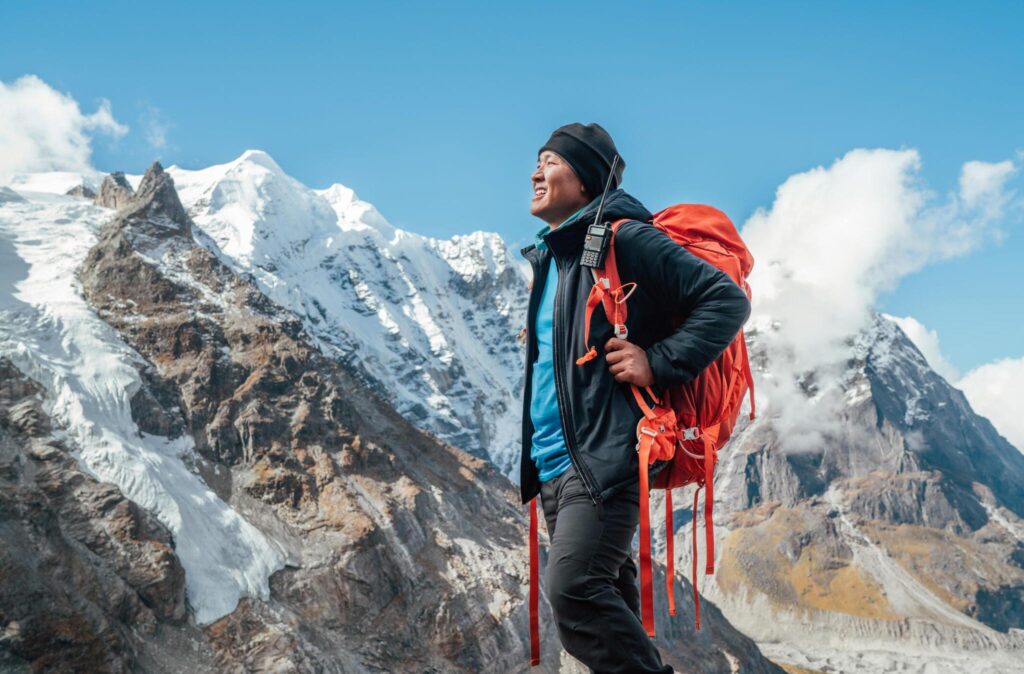
Challenges and Rewards of the Trek
Trekking Mera Peak presents both challenges and rewards:
- Physical endurance: Steep climbs and high altitude demand stamina.
- Mental resilience: Coping with altitude and unpredictable weather tests determination.
- Stunning views: Panoramic sights of Everest and neighboring giants.
- Achievement: Reaching the summit brings immense satisfaction and a sense of triumph.
Best Time to Trek Mera Peak
The best times to trek Mera Peak are:
- Clear skies and warmer weather.
- Blooming rhododendrons enhance the trails.
- Stable conditions are ideal for summit attempts.
- Crisp visibility and dry paths.
- Post-monsoon freshness in the air.
- Fewer clouds, offering uninterrupted mountain views.
Both seasons offer distinct advantages, from spring’s vibrant landscapes to autumn’s clear, stable conditions.
Cultural Insights
Trekking to Mera Peak offers a deep dive into Sherpa culture:
- Local Villages: Encounter traditional Sherpa villages like Lukla and Khare.
- Lifestyle: Observe their self-sufficient, agrarian way of life.
- Hospitality: Experience the warm, welcoming nature of the Sherpa people.
- Cultural Practices: Witness unique customs and Buddhist rituals.
- Architecture: See traditional Sherpa homes and monasteries.
This journey isn’t just a physical trek but a cultural immersion, offering insights into the resilient and rich heritage of the Sherpa community, nestled in the heart of the Himalayas.

Safety and Sustainability
Here’s how to make your trek not just unforgettable, but responsible too:
Safety First:
- Listen to your body: Altitude sickness is no joke. Acclimatize properly, heed your guide’s advice, and turn back if you feel unwell.
- Buddy Up: Trek with a partner or group, and let someone know your itinerary and expected return date.
- Gear Up: Invest in proper clothing, footwear, and trekking poles. Remember, the weather in the Himalayas can change quickly.
- Respect the Elements: Weather can be unpredictable. Learn to use crampons and ice axes safely, and be prepared for snow, wind, and even blizzards.
Eco-Friendly Footsteps:
- Leave No Trace: Pack out all your trash, including food scraps and toilet paper. Use designated campsites and toilets.
- Minimize Waste: Opt for reusable water bottles, containers, and bags. Avoid single-use plastics.
- Respect Wildlife: Don’t feed or disturb animals. Observe them from a safe distance.
- Support Local Communities: Choose local guides and porters, and patronize local businesses whenever possible.
How Difficult is Mera Peak?
Mera Peak is moderately challenging, requiring good fitness. It involves glacier travel and high-altitude trekking but is not technically difficult.
Is Mera Peak Harder than Kilimanjaro?
Yes, Mera Peak is generally considered harder than Kilimanjaro due to higher altitude, colder temperatures, and the need for basic mountaineering skills.

How Long Does It Take to Climb Mera Peak?
Climbing Mera Peak typically takes about 18-20 days, including acclimatization, trekking to base camp, and the summit climb.
Can You See Everest from Mera Peak?
Yes, from the summit of Mera Peak, you can see Mount Everest along with other Himalayan giants, offering a spectacular panoramic view.
What is the Success Rate of Mera Peak?
The success rate for Mera Peak varies but is generally high, around 80-90%, depending on weather conditions and climbers’ acclimatization and fitness levels.
Give us feedback
Related posts.
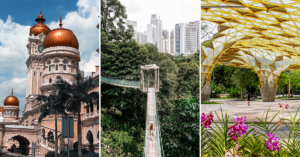
Free Things To Do in Kuala Lumpur
Are you planning to travel to Kuala Lumpur? First, learn some free things to do in Kuala Lumpur. Kuala Lumpur is Malaysia’s dynamic capital that
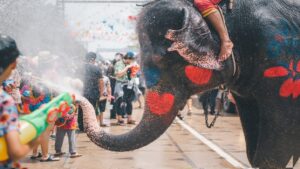
Songkran 2024: Your Guide to the Thai New Year Festival
Are you planning to fly to Thailand in April? Then get ready for the wildest water fight of your life! Songkran, the Thai New Year
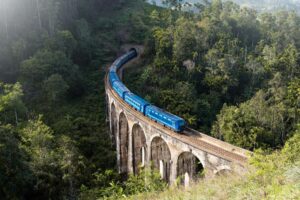
Is Sri Lanka Worth Visiting: Sun, Sand, and Soulful Experiences
If you have ever attempted to navigate the globe map, you have undoubtedly already encountered Sri Lanka’s breathtaking island paradise. Its magnificent scenery, friendly people,
- 🇧🇩 Bangladesh
- 🇲🇻 Maldives
- 🇹🇭 Thailand
Important Links
- Monetization Disclosure
- Privacy Policy
- Write for us
- Terms and Conditions
Europe might have a lot of Good Travel Guides, but the scenario is a bit different in Asia. There are some resourceful country based sites, But There is no resourceful Continental Travel Guide For Asia. This is where Incredible Asia comes.
© All right reserved
Find your adventure. The mountains are calling.
Discover A New Adventure
- Duration 0 - 10 10 - 20 20 - 30 30 - 40
- Trip Difficulty Easy Moderate Moderate to Strenuous Strenuous Very Strenuous
- Group 1 - 20 1 to 20 1 to 5 1-10 2 to 20 2-20 2+
- Altitude 0 - 500 500 - 1000 1000 - 1500 1500 - 2000 2000 - 2500 2500 - 3000 3000 - 3500 3500 - 4000 4000 - 4500 4500 - 5000 5000 - 5500 5500 - 6000 6000 - 6500 6500 - 7000 7000 - 7500

- Everest Region
- Annapurna Region
- Langtang Region
- Manaslu Region
- Other Treks
- 10 Days Himalyan Buddhist Pilgrimage Tour Nepal
- 13 Days Nepal Buddhist HimalayanTour
- 14 Days Nepal Bhutan and Tibet Tour
- 11 Days Nepal and Tibet Tour
- 9 Days Nepal and Bhutan Tour Package
- 11 Days Delights of Bhutan tour
- 5 Days Bhutan Highlights tour
- 5 Days Bhutan Cultural Tour
- 7 Days Taste of Bhutan tour
- 4 Days Tibet Lhasa Tour
- 14 Days Manasarovar and Mt. Kailash tour
- 8 days Lhasa EBC Tour and Trek
- 1 Day Kathmandu world heritage sites tour
- 6 Days Kathmandu Pokhara Tour
- 5 Days Kathmandu Nagarkot Dhulikhel
- 10 Days Highlight Nepal Tour
- 28 Days Himlung Expedition
36 Days Ama Dablam Expedition
- 22 Days Naya Kanga Peak Climbing
- 19 Days Tharpu Chuli Climbing
- 16 Days Lobuche East Peak Climbing
14 Days Chulu East Peak Climbing
- 16 Days Yala Peak Climbing
- 15 Days Pisang Peak Climbing
- 14 Days Island Peak Climbing
18 Days Chulu west Peak Climbing
- 14 Days Mera Peak Climbing
- 14 Days Everest Base Camp Trek
- 16 Days Everest Base Camp Trek By Road
- 20 Days Everest Classic via Jiri Trek
- 18 Days Everest Base Camp With Gokyo Trek
- 13 Days Gokyo Lakes Trek
- 12 Days Scenic Pike Hill Trek
- 1 Days Everest Base Camp Helicopter Tour
- 11 Days Everest Base Camp Heli Trek
- 20 Days Everest Three Passes Trek
- 9 Days Everest panorama Trek
- 14 Days Everest Base Camp Luxury
- 12 Days Ama Dablam Base Camp Trek
- 13 Days Annapurna Circuit Trek
- 10 Days Annapurna Basecamp Express Trek
- 12 Days Annapurna Base Camp Trek
- 8 Days Annapurna Panorama View Trek
- 11 Days Khopra Danda Trek
- 10 Days Mardi Himal Trek
- 11 Days Mohare Danda Trek
- 14 Days Annapurna Sanctuary Trek
- 8 Days Jomsom Muktinath Trek
- 21 Days Nar Phu Valley Trek
- 10 Days Langtang Valley Trek
- 11 Days Langtang Gosaikunda Trek
- 10 Days Tamang Heritage Trek
- 15 Days Tamang Heritage and Langtang Valley Trek
- 8 Days Helambu Trek
- 13 Days Ganja La Pass Trek
- 22 Days Manaslu Trek with Tsum Valley
- 20 Days Tsum Valley Trek
- 34 Days Manaslu Circuit Nar-Phu Trek
- 16 days Manaslu Circuit Trekking
- 17 days Upper Mustang Trekking
- 5 Days Nagarkot Chisapani Trek
- 18 Days Lower Dolpo Trek
- 24 days Kanchenjunga Trek
- 26 Days Upper Dolpo Trek
- Why Book with Us
- Legal Documents
- Our Friends
- Terms and Conditions

View Of Mera Peak
Trip Difficulty
very-strenuous
Accommodation
Trekkers Hut
Trekking and Tour
Breakfast + Lunch + Dinner
We Offer Group Discount
No. of Persons
Price Per Person in USD
Table of Contents
Trip highlights.
- Panoramic views of Mt. Everest, Makalu, Chamlang, Baruntse, Melungtse, Amadablam, Thamserku, Pumori, Tower Peak, Kusum Kanggru, Kanchanjunga from the summit.
- Different Communities with a majority of Sherpa, Tamang, Chhetri, Brahmin, and Newar.
- Great Himalayan Landscape.
- Climb on top to the stunning and magnificent Mera peak with the far-reaching panorama of the Himalayas.
- A popular 6000m trekking peak.
- An enchanting journey through forests and obscure villages.
- Prep at Mera Peak Base Camp and High Camp.
- Climb with our certified and experienced Sherpa climbing guides.
Mera Peak Trek Overview:
The Mera Peak is one of the most popular trekking peaks in Nepal, and it is popular for a good reason. Situated in the Everest Region, the peak lies at an altitude of 6,476 meters . The summit of the peak provides a breathtaking 360-degree view of the Himalayan range, including Mount Everest (8,848m) , Mt Lhotse (8,586m) , Mt Cho Oyu (8,201m) , and Mt Makalu (8,643m) .
In the Mera Peak trek, you will find everything you can imagine, such as unique Sherpa settlements, lush forests, swinging suspension bridges, and traditional gompas. There’s something for everyone to enjoy. And of course, you can’t forget about the prayer flags and stunning mountain views.
Whether you’re an experienced climber or just looking for an adventure, Mera Peak is the perfect destination. So what are you waiting for? Start planning your trip today!
Why Mera Peak is the perfect choice for beginners?
Mera Peak trek is ideal for those who want to enjoy a little bit of everything Nepal has to offer. From the stunning views of the snow-capped mountains to the different cultural monuments and settlements, you’ll be treated to a truly unique experience.
Climbing Mera Peak is the perfect choice for beginners for a number of reasons. First and foremost, it’s one of the tallest peaks in the world that is open to anyone who wants to submit it. That’s because the Nepalese government has made it a priority to make Mera Peak accessible to as many people as possible. In fact, they’ve even set up a base camp at the base of the peak that provides all the necessary amenities for climbers.
The feeling of accomplishment after summiting a Himalayan peak is beyond words. Our team of expert guides and porters will ensure that you have a safe and enjoyable trek. The trek is moderate in difficulty and can be undertaken by people of all ages.
During your trek, you’ll be overcome with joy however make sure to take some time to just breathe and take some beautiful photos. The landscape below is described by some as snowy, moon-like scenery. Of course, these moments of bliss cannot be possible without some exhausting (but rewarding) trekking.
The Mera peak is the perfect choice for those who wish to attempt a Himalayan summit for the first time. It is an achievable goal, with a well-defined trail and a comfortable base camp that makes it the ideal choice for beginners . Getting to the summit is a truly amazing experience, as the views are simply breathtaking.
Best Time For Mera Peak Trekking
Mera Peak trekking is a popular option for those looking to explore the Everest region. The best times to make the trips are during the spring (March to May) and autumn (September to November) seasons. These seasons provide the best weather and clearest skies. It is possible to climb in the winter, though the snow can pose difficult challenges. The key is to be prepared and to have the right gear.
Additionally, you should avoid traveling during the monsoon season (June to September), since heavy rains and landslides can make it impossible for you to travel.
Once you’re on the trail, the hardest part is the ascent to the summit. The trail is steep and strenuous, and altitude sickness is a real concern. Be sure to take your time and acclimatize to the altitude before making your final push to the top.
The rewards, however, are more than worth it. From the summit, you’ll be treated to some of the most incredible views on earth. Soak it all in, and enjoy the feeling of accomplishment that comes with reaching the top of one of Nepal’s most iconic peaks.
Trekking Map, Route & Accommodation To Mera Peak
The trekking route to Mera Peak starts from Lukla, which is a small town in the Everest region of Nepal. Trekking routes from Lukla take you through the Everest region, then onto Mera High Camp after the village of Khare. The trekking route to Mera Peak is a strenuous one and takes around 14 days to complete.
After a short 45 minutes flight from Kathmandu, you’ll find yourself in Lukla – the gateway to the world’s tallest mountain. During your visit to Lukla, you’ll be mesmerized by the beauty of your surroundings and can’t resist taking pictures. While it’s fun to take in the sights, you’ll need to prepare for the trek ahead.
After a relaxing night of sleep, you’ll make your way through Lukla to Chutanga. The trail leads you toward the edge of the forest, where you’ll find beautiful rhododendron and pine trees. You’ll pass through several small villages before you reach the thick woods on the slope beneath the Kalo Himal Ridge.
The next day, you’ll be greeted with spectacular views of Numbur Himal , Kongdi Ri , Karyolang , and numerous other mountains and peaks. You’ll spend the night at Chatara La, and the following day is just as adventurous. You’ll pass through woodlands of juniper, rhododendron, and other local vegetation. Enjoy the views of Mera and the Hinku Valley, and keep an eye out for wild animals like sloth bears and mountain cats among the tall pine trees.
As you trek for hours on your fifth and sixth days, you will reach your acclimatization day on the seventh. Today is another acclimatization day, which means you’ll be moving one day closer to your high peak. Get ready to walk around and prepare for the peak.
On your next day, you’ll be trekking from Khare to Mera High Camp . This is an energetic day, as you’ll be able to take in the spectacular views of Everest, Makalu, Baruntse, Kusum Kanguru, and many other mountains. Moreover, If you haven’t taken any pictures yet, make sure to have your camera ready as you make your way back to Khare from Mera High Camp.
The next few days will be spent enjoying the hospitality and sights of the villages you’ll be visiting on our way back. But eventually, your short trek will come to an end in Thuli Kharka . From there, you’ll make your way back to Lukla, where we’ll say goodbye and depart for Kathmandu.
When you book a trekking package with us, you can rest assured that your accommodation will be taken care of according to the itinerary you have selected. You’ll be staying in tea houses and hotels along the way, and we will provide you with guides and porters to make sure you have the best possible experience.
The food that is offered on our trekking packages is of the highest quality and is absolutely delicious. You’ll be able to choose from a variety of different dishes, and we’ll make sure that you’re well-fed and taken care of throughout your journey.
Tips for a Successful Mera Peak Climb
Mera Peak is Nepal’s most popular trekking peak and for good reason. At 6,476m it’s the highest trekking peak in the country and offers stunning views of some of the world’s tallest mountains, including Mt. Everest. It’s also a relatively non-technical climb, meaning that you don’t need any special mountaineering skills or equipment for the summit.
However, that doesn’t mean that climbing Mera Peak is easy. You’ll still need to be in good physical shape and be prepared for the altitude. Here are some tips to help you have a successful climb.
1. Choose the right time of year to go
The best times to make the trip, though, are during the spring (March to May) and autumn (September to November) seasons. These months offer the best weather conditions for trekking and climbing, with clear skies and moderate temperatures. Avoid the monsoon season (June to September), when heavy rains and landslides can make the trail impassable.
2. Get in shape
It is probably most important to remember that Mera Peak is only a moderate hike, so you will need to be in good physical shape to reach the summit. If you’re not used to hiking at altitude, start training a few months before your trip. Go for long hikes in the hills or mountains and try to do a few multi-day hikes. If you can, do some hikes with a backpack to get used to the extra weight.
3. Hire a guide
While it is possible to trek and climb Mera Peak without a guide, we highly recommend hiring one. As part of our package, you will receive a guide as well as porters to assist you throughout the trek. As a guide, you won’t only gain insight into the trail and technical sections of the climb, but also gain local knowledge and experience.
4. Stay hydrated & eat healthily
As your trek progresses to higher altitudes, it is extremely important that you stay hydrated and drink plenty of water. Be sure to drink enough water every day – at least 3-4 liters. You might not feel thirsty, but your body needs water to function properly.
On a similar note, it is important that you eat healthily throughout your trek. You’ll burn a lot of calories during your trek, so you need to replenish your energy. Don’t forget to eat plenty of carbs and protein throughout the day. Also, Snacks like nuts and bars are good choices for energy boosters.
5. Be prepared for the altitude
The altitude is one of the biggest challenges on the Mera Peak climb, so it’s important to be prepared for it. The best way to prepare for the climb is to acclimatize yourself. This involves gradually increasing your exposure to altitude over a few days or weeks. Symptoms of altitude sickness can include headache, nausea, vomiting, shortness of breath, and fatigue.
If you start to experience any of these symptoms, it’s important to descend to a lower altitude as soon as possible. In severe cases, altitude sickness can lead to edema (fluid in the lungs) or cerebral edema (fluid on the brain), which can be fatal.
Detail Itinerary
Flight from kathmandu to lukla - 45 minutes..
As part of our trek, our first day will be spent flying from Kathmandu to Lukla , which is the gateway to Everest, the tallest mountain in the world, which takes around 45 minutes from Kathmandu . We will be greeted with lush mountains and picturesque views as we travel and explore the natural beauty of Lukla along the way. During our stay here in Lukla, we will be staying at a tea house , where we will be served lunch, breakfast, and dinner throughout the day.
Destination:
Accommodation:
Breakfast, Lunch and Dinner
Trek from Lukla to Chutanga - 4 hours.
On our next day, we will follow a decent trail that led through the field to the edge of a decreasing forest of rhododendrons and pine that cover the precarious slopes on either side of the trail. The trail will take us through a few small villages before we enter thick woods below the Kalo Himal Ridge on the slopes of the mountain. There is a preliminary route that goes straight from Lukla for up to an hour , then it somewhat rises up to Chutanga through the mountains. At an altitude of 3450 in Chutanga, we will be staying our night at a tea house, which is near the top of the mountain.
Breakfast, Lunch and DInner
Trek from Chutanga to chatara La - 7 hours.
The next day on our journey to climb up to the Chatara Pass, we can appreciate the spectacular views of the Numbur Himal , Kongdi Ri, Karyolang crest , and many other mountains and peaks. Straight ahead and up through the rhododendron woodlands, we may encounter wild animals if we are lucky enough to have good weather. The view from the Chatara La over the Dudh Kosi towards the Karyolung and the Lumding Himal , and the scenery over the rolling lower regions of the Hinku Valley is simply breathtaking. Crossing to the left and finally plunging steeply to Tuli Kharka (large field) , we will reach the Chatara La for our overnight stay.
Trek from chatara La to kothe - 5 hours.
Today on our journey, we’ll pass through woodlands of juniper, rhododendron, and other neighborhood vegetation. While on our way we can spot the mountain creatures like Sloth Bears, Wilderness Felines and is covered with tall pine trees. Also, we can appreciate the sight of the Mera and the Hinku valley on our way. After eating in Thakthor , we again begin our trek to Kothe . This is a decent spot to camp and there are a few teahouses around you can visit and wander to nearby places for the rest of the time.
Trek from Kothe to Thagnag - 4 hours.
Our plan today is to climb along the west bank of the riverbed up to Thagnag (4350m) . This will be a continuous climb and we will have hit the peak of the Kusum Kanguru crest and many more Himalayan peaks for the day.
The views from the top are said to be incredible, with a clear view of Mt. Charpate and Mera La as well as a Buddhist Gompa . The climb is a continuous one, so we’ll be putting in a lot of effort today. But it will be worth it when we reach the top and get to see all the incredible sights that the Himalayas have to offer.
There are a lot of hotels and shops beginning to be constructed in Thagnag as spring touches the region. Our trek will take us along the Hinku Khola in the shadow of Mera Peak before we stop at Gondishung , the herders’ settlement on the west bank of the Hinku Drangka for lunch. Then it’s just a short walk to Thaknak , a mid-year territory with crude cabins and shops.
Trek from Thangnak to Khare - 4 hours.
Early morning, we’ll be leaving Thaknak to pursue the difficult trek day as we’ll have to pass through the steep moraine trails. The Moraine way will be from Dig Glacier to Dig Kharka where you will be in front of Charpate Himal. This trial will make posts near the nose of the Hinku Nap and Shar glaciers .
Soon after, our steep climb of 3-4 hours will soon end in Khare where we’ll have plenty of time to rest and enjoy the beautiful sceneries this place has to offer. Khare is the acclimatization point of the Mera Peak climbing itinerary which means you will spend another day tomorrow here.
Acclimatization day
It is yet another acclimatization day for our high-peak climb that is set to take place one day from now. Walk around today and prepare ourselves for the challenge before us. We have set aside a day exclusively for acclimatization and preparation just to ensure that we are set up better for the climb up Mera Peak the following day.
Our climbing head will enable us to clean our necessary climbing procedures and exhibit the ideal approaches to utilize our climbing apparatuses like the ice hatchet, tackle, climbing boots, and crampons. The preparation will likewise incorporate learning the best climbing system with the rope and our entire day will be spent preparing ourselves for the Mera Peak climb.
Khare to Mera high camp - 7 hours.
This is an energizing day as we climb onto the Mera Glacier and tail it to the pass. We need to walk through the soaked course (around 260 meters) and it takes about 2 to 3 hours to achieve Mera Base Camp. The perspectives puzzled us as we can appreciate the Everest, Makalu, Baruntse, Kusum Kanguru, and numerous different mountains and crests on display.
Also, we will trek high to High Camp. In transit see the decent perspective on Mera peak and the icy mass. From High Camp, if climate grants, we will have a display of Kanchenjunga far toward the east. The camp is situated at an amazing point from where you can have some extraordinary mountain sees.
Mera High Camp
Mera high camp and back to Khare - 12 hours.
We are about to embark on the most thrilling and most challenging day of our hike in any mountaineering excursion throughout this journey. In general, it is important to rope up for a substantial portion of the summit approach as there is a danger of precipices along the way. As we proceed along the trail, we are rewarded with breathtaking views of Baruntse (7129m) , Chamlang (7319m) , and Nau Lekh (6360m) , with Makalu (8481m) approaching behind. After accomplishing the summit, you backtrack your means down to high camp.
Once we have taken pictures and admired the view, we will head back to our campground at Khare, where we will spend the night and get some rest. Throughout the course of this day, you are going to discover why this is such a long but motivating day for you.
Reserved day
There is no assurance that we will have an ideal climate on our arranged day for the summit. Along these lines, this day is put aside as a possibility in the event that we can’t summit the Mera on an ideal day because of awful climate conditions or some other unexpected reason. In any case, if the excursion goes easily, this day won’t be required. This is particularly a climate day (most potentially) as it gets changed habitually.
The summit of the Mera is an amazing feat that should not be taken lightly. The weather conditions can change very quickly and without warning. It is important to be prepared for anything when you are attempting to summit the Mera . This includes having a backup day in case the weather conditions are not ideal on your original planned summit day.
Trek back to kothe - 7 hours.
Today we will climb for like 7 hours along a similar trail utilized already to reach Kothe . We plummet right off the bat to Tagnag before proceeding to Kothe . Subsequent to coming to Kothe, we commend our prosperity by evaluating neighborhood delights and wines.
Trek back to Thuli Kharka - 6 hours.
You will pursue another new course back in Thuli Kharka after breakfast. It’s pleasant to stroll through the red Rhododendron woodland with a beaten trail of the Himalayas of Nepal. We watch the broad scope of Mera crests, Mera North, Mera Central, and Mera South from Thuli Kharka . We move up and plunge, crossing a few tributaries of the Inkhu Khola before achieving a forked trail close by Taktho . We pick the path to our right side and keep strolling. Our trail goes by a Chorten after which we walk downhill on a precarious trail. Next, we climb to Thuli Kharka and go by another Chorten in transit.
Thuli Kharka
Trek back to Lukla - 8 hours.
We cross the Zatrwa-La pass at 4,600m . When we cross the pass, we are invited by seeing the great perspectives of Lukla Valley which are encompassed by Cho Oyu, Kongde Peak , Numbur Himal, Kusum Khangru thus numerous others. From Zatrwa La pass we walk right down to Chutang and then straight forward to Lukla town. At night we appreciate supper in the Himalayas of Nepal with our group. Spend the most recent night of trek walking around the Lukla valley.
Fly to Kathmandu - 45 minutes.
We find an early morning trip to Kathmandu to say goodbye to everyone. In the wake of achieving Kathmandu , we can take a rest or do some keepsake shopping. On the off chance that we need to investigate some other territories of Kathmandu, we may do that today. There will be a goodbye supper tonight to commend the climbers’ influential summit of Mera Peak . You can get a few gifts.
- All transportation by private vehicle including airport transfers as per itinerary.
- Three daily meals with tea/coffee (Breakfast, Lunch and Dinner) during the trek.
- Round flight to Lukla
- Professional Guide
- Tented accommodation during the climb
- Staff costs including their salary, insurance, equipment, domestic airfare, food and accommodation
- All necessary paper work; trekking permits and Mera peak climbing permit and Government taxes levied in Nepal
- Porter service, two trekkers and 1 porter
- Medical kit (carried by your guide)
- Nepalese visa fee
- Kathmandu Hotel and food.
- International airfare to and from Kathmandu
- Excess baggage charges (if you have more than 15 kg of luggage, a cargo charge is around $1.5 per kg)
- Extra night accommodation in Kathmandu because of early arrival, late departure, early return from mountain (due to any reason) than the scheduled itinerary
- Altitude chamber (PAC) or oxygen
- Lunch and evening meals in Kathmandu (and also in the case of early return from the mountain than the scheduled itinerary)
- Travel and rescue insurance
- Personal climbing equipment
- Personal climbing guide if requested
- Optional trips and sightseeing if extended
- Tips for guides and porters
- Additional Cost if you decided to stay in any place, besides the itinerary, we suggest you make a private trip if so.
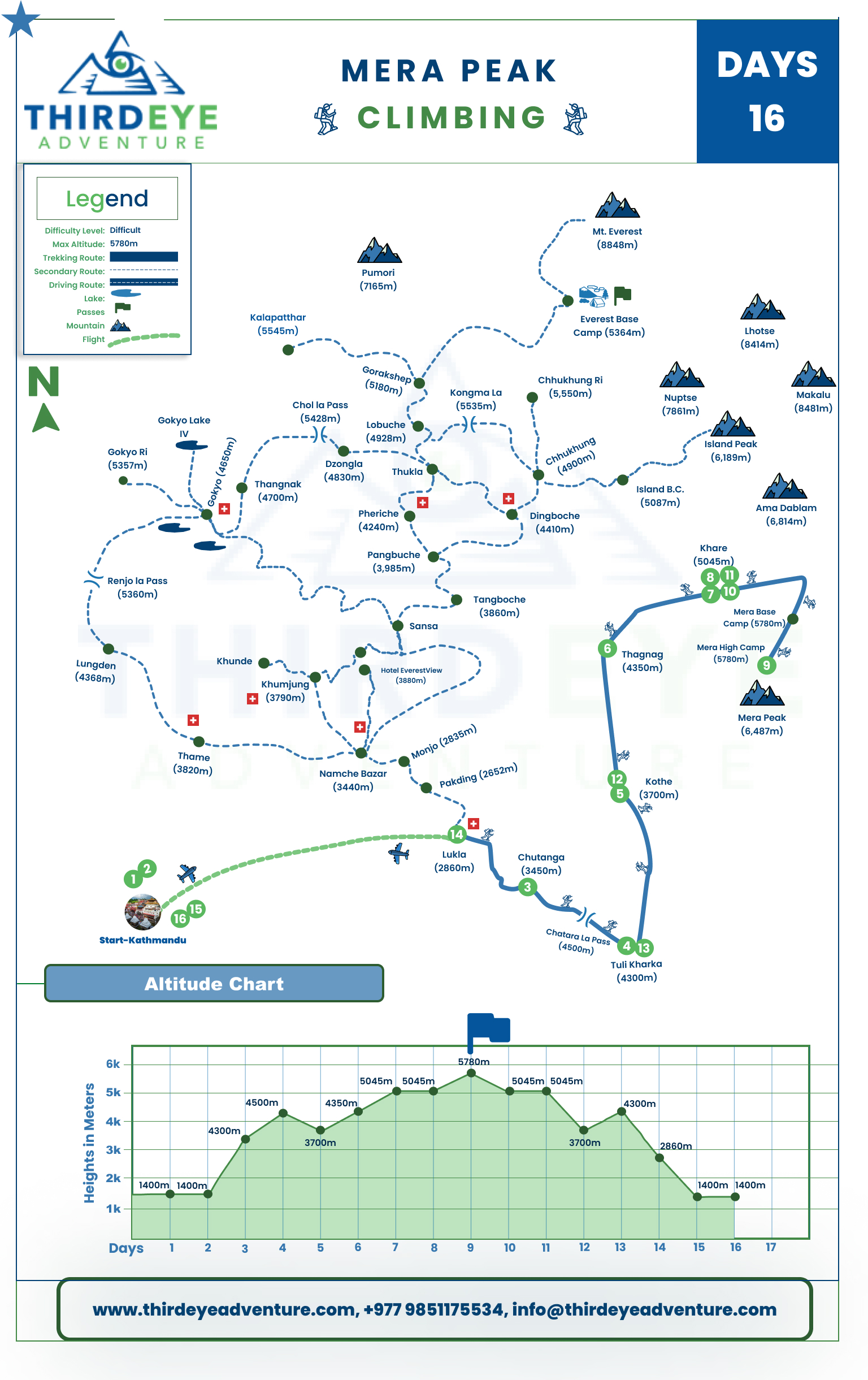
Equipments Checklist
– Backpack 55-65 litres – Harness – Ascender/Jumar – Descender – ATC Guide – Carabiners – Prusik cord X 2 – Slings X 2 – Ice Axe – 12-points steel crampons – Climbing helmet – Inflatable sleeping mattress – Two Sleeping bag (One for base camp and one for higher camps)
– Warm Hat and Bandana/Scarf – Baseball cap – Thermal Balaclava – Sunglasses with UV protection – Ski goggles (Anti-fog and good ventilation) – Headlight X 2 with spare batteries
– Long-sleeved shirts – T-Shirts – Baselayers – Warm Jackets/Sweater/Pullover – Waterproof jackets – Down Jacket with hood (800m fill) – Primaloft or light down jacket – Down Suit (Lightweight, comfortable fit and 800m fill) (For Summit Climb Only)
– Thermal – Inner wears / Baselayers – Undergarments – Waterproof trousers – Trekking trousers – Down or Primaloft pants
– Warm socks (4 pairs of thin socks and 4 pairs of thick socks) – Trekking shoes (Preferably full to protect/support your ankle) – 8000m Mountaineering boots (Lightweight and comfortable size) – Camp Shoes – Gaiters – Down shoe
– Gloves – Primaloft Mitten – Down Mitten
– Trekking poles – Reusable water bottle with an insulated cover – Thermos – Multi-tool knife – Pee bottle – Laundry bag to keep dirty clothes – Large plastic bags to keep the clothes dry – Padlock – Binoculars – Sewing kit – Duct tape – Reading materials, playing card, notebooks and pens – Extra clothes to wear in Kathmandu when you come back from the expedition.
– Quick-drying towel – Small face towel – Toothbrush & toothpaste – Deodorants, soap and shampoo – Face and body moisturizer, – Sunscreen and lip balm – Hand sanitizer/Antiseptic wipes – Hygiene products – Basic first aid kit
– Digital camera and extra battery – Smartphone – Charging cable for camera and mobile phone – Portable Power Bank – Multifunctional Watch – International Travel Adapters
Need a Private Date? We got you.
Get ready to embark on an unforgettable journey with your group of friends! Our private adventure specialists have got you covered with the ultimate “Third Eye” experience. From planning your trip to answering any questions you may have, our team is here to make sure that your private adventure goes off without a hitch and creates memories that will last forever!
Call +977 9851175534 or email [email protected] for more information on all the amazing options we offer and get ready to set out on the adventure of a lifetime!
Frequently Asked Questions.
Can a beginner climb mera peak.
Even though Mera peak climbing is a strenuous type of climbing you don’t need to have special technical climbing skills. Beginners with high-altitude trekking experience can easily climb this peak with proper planning and preparation. You need to be physically and mentally fit to reach the altitude of 6476m.
If you have basic mountaineering it will be helpful. During this trek, you will also be given training about basic climbing skills from the professional Guides. So you don’t have to worry about using the ropes, ice axe, and other climbing equipment.
Can I climb Mera Peak without a guide?
You need to climb through a professional licensed trekking agency and hiring a guide is a must for this climbing. The experiences Guide will help you to navigate the difficult terrain as well as help you to reach the summit successfully.
Guides are well-known about the route and also give you valuable insights into the surrounding environment, local culture, and wildlife. Additionally, if you are climbing any peak in the mountain region of Nepal you need to hire a professional local guide.
How long does it take to climb Mera Peak?
If you are trekking through the standard route presented by the third adventure then the trip will be completed in 14 days from the arrival to the departure. And if you have your own itinerary plan then it is also possible to change according to your choice.
Depending upon your budget you can also choose the side trips along with this climbing. If you don’t want side trips but want to explore different places for sightseeing, tours, or adventure activities like paragliding, rafting, etc it is also possible. Don’t hesitate to ask us about any change or adjustment that you want to make to your itinerary. With our expert team, we are here for you to make your trip more memorable and adventurous in every possible way
What is the cost of Mera peak climbing?
The cost of climbing Mera Peak varies from $2000 to $3500 per person. The cost of climbing is affected by various factors such as the number of climbers, itinerary days, transportation, accommodation, food, seasons, etc. So before you book the package, managing the budget wisely is extremely important.
If you want to save the cost try to climb in a big group because trekking agencies will provide heavy discounts if you are in a big group. Also, choose the best seasons for traveling, and don’t forget to book early. Further, you can also save some bucks by renting some gear and equipment here in Nepal.
How hard is Mera Peak?
Being renowned as the highest climbing peak in Nepal, climbing Mera Peak is not as difficult as you think. If you have some high-altitude trekking experience with great physical and mental fitness then you can remark on this journey.
Climbing on this peak is a straightforward process but only in the last part you need to ascend vertically. Even though it has an extreme altitude of 6416m it is considered easier than most of the other trekking peaks in Nepal.
Which is the best time for climbing Mera Peak?
The best time for climbing the Mera Peak is when the climatic conditions are perfect and the temperature also supports the climbers without adding difficulties. This type of ideal time is found during the month of the spring and autumn seasons.
Therefore, we suggest you climb on either in the spring or the autumn seasons to increase your chances of success and ensure a more comfortable experience. .
How to train for the Mera peak climbing?
On this Mera peak summit, you need to walk daily for 6-7 hours uphill and downhill in a high-altitude area. So this summit demands a high level of physical fitness as well as mental fitness. There are certain ways to increase physical fitness:
- Joining the Gym and Yoga
- Start doing small hikes around your home
- Do regular cardiovascular activities and aerobic exercise.
- Do exercise that increases your strength
- Hydrate your body all the time and eat a balanced diet of food
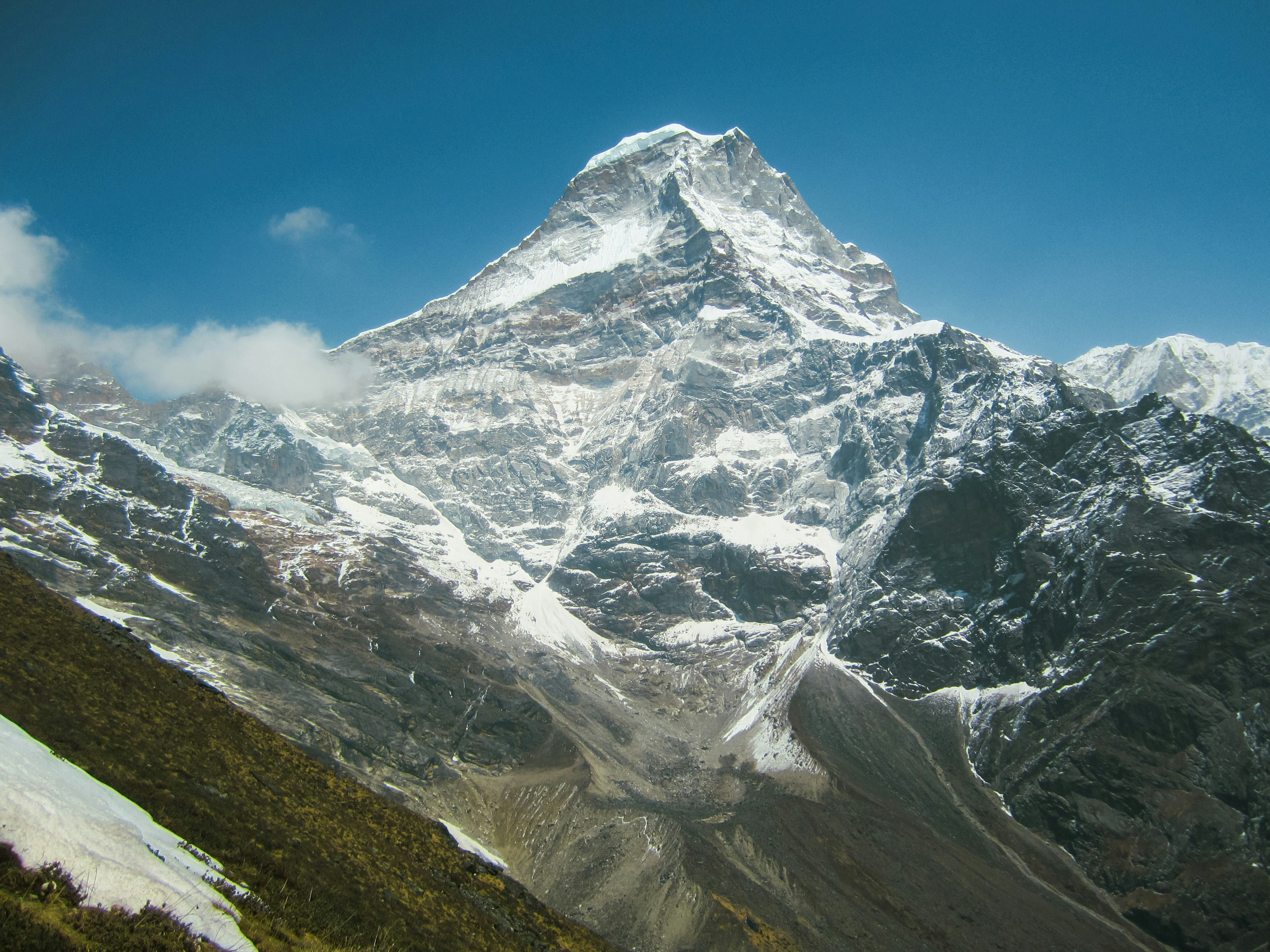
It was a fantastic trip of a lifetime for me at Mera Peak.ganesh arranged the trip responsively and promptly answered my many questions. I was well taken care of throughout the trip by Sherpa Sudip, and appreciated the extra effort he had taken in arranging my itinerary when weather changed rapidly and unpredictably. Truly amazing experience when we summited. Thank you Sudip for the unforgettable experience! Thumbs up!

Thanks, Ganesh, Rabin, and the team for this wonderful Mera Peak trekking. Will definitely return back with Third Eye Adventure for the Manaslu trek.

I recently went to Mera Peak climbing in March with my family and we had an amazing time. The trip was professionally organized and the team at Third Eye Adventure was so knowledgeable and helpful. We hiked up to the top of Mera peak and were rewarded with stunning views. The trek itself was challenging but the staff was there to help and support us every step of the way. We had plenty of time to explore the area and take in the breathtaking sights.
Trending trips
Don’t want to miss.
Explore Nepal and discover the unique attractions it has to offer – from cultural sites to breathtaking landscapes and activities that will take your breath away.
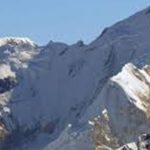
Himlung Expedition – 28 Days
Starts From USD
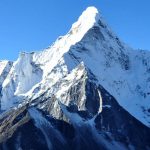
Naya Kanga Peak Climbing – 22 Days
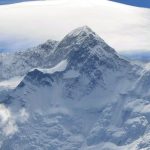
Tharpu Chuli Climbing – 19 Days
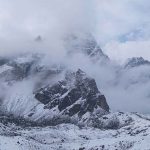
Lobuche East Peak Climbing – 16 Days
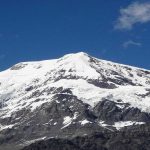
Yala Peak Climbing – 16 Days
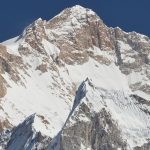
Pisang Peak Climbing – 15 Days
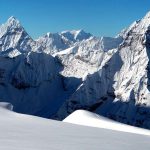
Island Peak Climbing – 14 Days
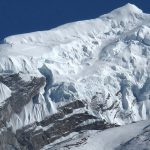
How To Get from Kathmandu to Besisahar? Flight, Bus
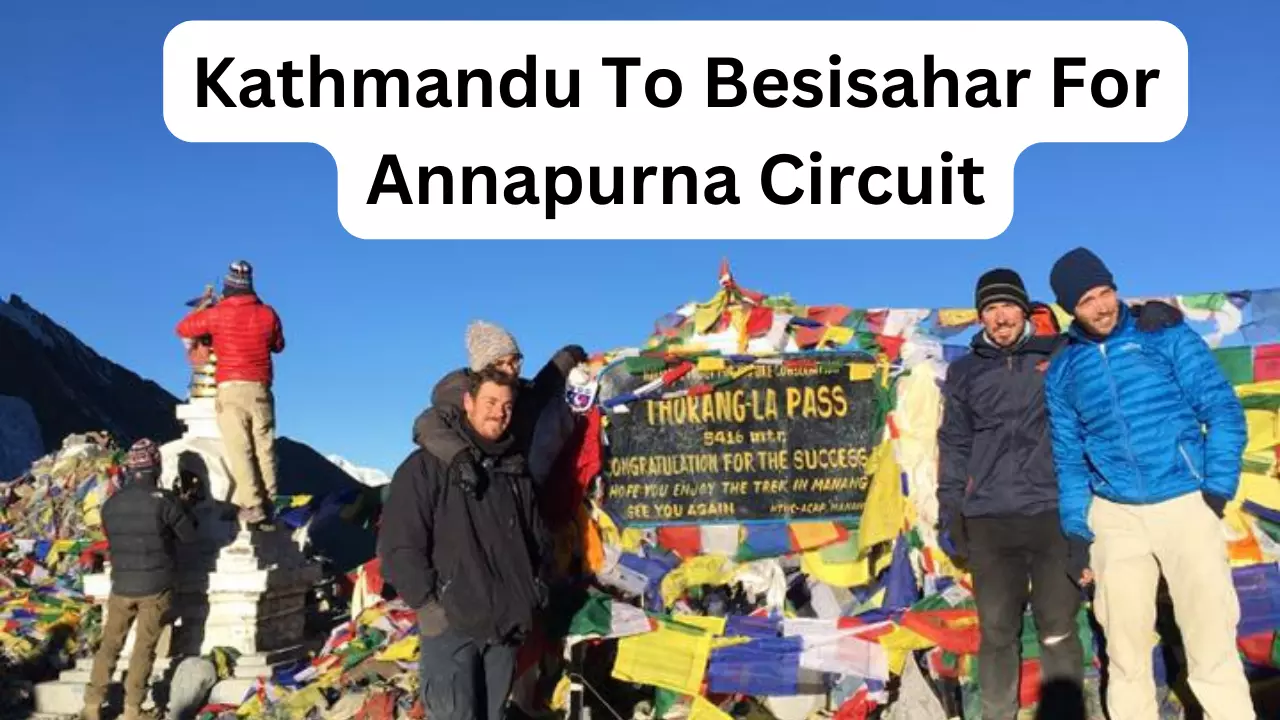
Easiest And Short Treks in Nepal
Nepal is a paradise for trekkers as it has various trekking routes to meet the different needs of the trekkers. The landscape goes through a…
Annapurna Base Camp vs Annapurna Circuit: Which is suitable?
Introduction to the Annapurna RegionWhat is the duration of each trek?What is the maximum altitude reached on each trek?Which trek is more difficult?What is the…
- You are here:
- Destinations
- Peak Climbing in Nepal
- Mera Peak Climbing
Mera Peak Climbing Itinerary

Mera Peak High Camp 5800 Meter
Day 1 arrive at kathmandu airport, pick up and transfer to hotel.
You will arrive at the Tribhuvan International Airport where one of our team representatives from Mera Alpine Treks will pick you up. He will take you to your hotel. You can rest for the day, and later in the evening, you will meet with your guide. He will take you to a traditional Nepali restaurant to have welcome dinner along with cultural dance. Overnight in the hotel.
- Meals: Welcome Dinner
- Accommodation: Hotel
- Place: Kathmandu
- Altitude: 1300 Meter / 4,264 Feet
Day 2 Drive from Kathmandu to Patale Dhap (2900m) 8 hours, BP Highway
After breakfast, we will depart from Kathmandu for Patale Dhap (2900m), Okhaldungha via the BP highway. Patale Dhap is the popular viewpoint of Mount Everest. The road runs along the valley of the Sun Koshi river and passes several valleys, beautiful landscapes. We use 4 wheels Jeep, Scorpio, TATA Sumo for transportation. Spend the night in a lodge.
- Meals: Breakfast, Lunch and Dinner
- Accommodation: Lodge
- Place: Patale Dhap
- Altitude: 2900 Meter / 9,512 Feet
Day 3 Drive to Pangom (2840m) 6 hours, Off Road, Cultural Day Trip
Off road drive from Patale Dhap to Pangom (2840m). It takes 6 hours by Jeep to reach Pangom via Kharikhola. During the trip you can see several village, people and their daily lifestyle. The journey will present you with beautiful views of the landscape and will pass through forests and small villages. Stay overnight at the Lodge.
- Place: Pangom
- Altitude: 2840 Meter / 9,315 Feet
Day 4 Trek to Ningsow (2863m) 5 hours, Rhododendron Jungle Trail
Today the trail will feature some great scenic views. You will climb to Nankung La (3110m) from where you can observe a breathtaking view of Mera Peak. Further on, you descend to Sibuje (2770m) and walk to reach Ningsow. Night in Lodge.
- Place: Ningsow
- Altitude: 2863 Meter / 9,390 Feet
Day 5 Trek to Chhetrwa Khola (3122m) 5 hours, Himalayan Pine Jungle Trail
You will ascend on a steep trail and reach a tea shop from where you will get to witness a gorgeous landscape view. Further, you will ascend and descend steeply towards a river. You will take a lunch break here and after that, you will continue trekking through a forested rugged trail.
- Place: Chhetrwa Khola / Jungle Camp
- Altitude: 3122 Meter / 10,240 Feet
Day 6 Trek to Kothe (3580m) 5 hours, Himalayan Pine Jungle Trail
You will go through the Himalayan pine forest trail with the beautiful panoramic view. You will climb steeply to the Hinku Valley. On the way, you will also meet the small village of Taktor and reach Kothe. Kothe is the junction of Mera Peak Trek and located at bank of a river. You can visit the local houses and see their way of life, culture and traditions. You will spend the night in a lodge.
- Place: Kothe
- Altitude: 3580 Meter / 11,742 Feet
Day 7 Trek to Thangnak (4358m) 4 hours, through Inkhu River
Today you will start trekking following the west bank of the Inkhu river bed to the Thangnak valley. In addition, you will ascend gradually. On the way, you will get a close-up view of Kusum Kanguru and many other Himalayan mountains. You will also pass by a Dukfuk Monastery located at the lap of a large rock and arrive at Thangnak, which is a summer grazing area. You will spend the night in a lodge.
- Place: Thangnak
- Altitude: 4358 Meter / 14,294 Feet
Day 8 Trek to Khare (5000m) 4 hours, Glacier Trek
You will wake up early and start the trekking, you will be able to see the open valley and have amazing views of the north side of Sabai Glacier and Hinku Nup Glacier as well as the Himalayan Range. After reaching Tama Pokhari, you will descend and cross a Dig Glacier. From there you will ascend to Khare with impressive panoramic views. You will spend the night in a lodge.
- Place: Khare
- Altitude: 5800 Meter / 19,024 Feet
Day 9 Rest day for acclimatization and Climbing preparation training
Today is your day to acclimatize your body with the increase in altitude. You will start your day with a delicious hot breakfast with a superb view of Mera Peak. Later, you will spend the day walking around the village and preparing climbing gear for the summit. You will spend the night in a lodge.
Day 10 Climb to Mera High Camp (5800m) 6 hours, Camping Trek
After breakfast you will climb the Mera Glacier and climb back up to Mera La Pass. Further on you will climb the steep path and about 2-3 hours of walking will take you to Mera Base Camp. Along the way, you can see panoramic views of Mt. Everest, Mt. Baruntse, Mt. Makalu, Kusum Kanguru and many other mountains. You will gradually move towards Mera High Camp. The trail will be steep and difficult so make sure you hike carefully and follow your guide's directions properly. You will then climb to Mera High Camp with the view of Mera Peak and the glaciers. If the weather is clear you will have a fantastic view of Mt. Kanchenjunga far to the east. You will spend the night in a camp.
- Meals: Breakfast, Pack Lunch, Normal Lunch and Dinner
- Accommodation: Camping Tent
- Place: Mera High Camp
Day 11 Summit Mera Peak (6,470m) and back to Khare 10 hours, Summit Day
Today is the most exciting and challenging day as you will reach the top of Mera Peak. You will wake up at 3 a.m. and start climbing after a light breakfast. Sherpa climbing guide helps to summit Mera Peak. You must also use a rope several times to cross the crevices. As the sun begins to rise you will be able to see some excellent views of Mt. Makalu, Mt. Baruntse, Nau Lekh and Chamlang. Upon arriving at the top, you will spend some time enjoying the views of the surroundings and descend back to Mera High Camp to Khare for the night.
- Altitude: 5000 Meter / 16,400 Feet
Day 12 Trek Down to Kothe (3580m) 5 hours, Back to Same Way
After the summit of Mera Peak you will start to descend back down to Kothe. The day is going to be long and a little exhausting, but the beautiful view of the surroundings will accompany you until the end of the day. You will reach Thangnak and descend via the Inkhu river to reach Kothe. You will spend the night in a Lodge.
Day 13 Trek up to Thuli Kharka (4200m) 6 hours, Off the Beaten Trail
Today you will follow a new route back to Thuli Kharka, located on an open hill. You will walk through beautiful forests and later you will walk on trails off the beaten track. On the way, you will have a wonderful view of Mera North, Mera Central and Mera South. You will spend the night in a lodge.
- Place: Thuli kharka / Chhatrwa
- Altitude: 4200 Meter / 13,776 Feet
Day 14 Trek Down to Lukla (2840m) 6 hours, Cross Zatrwa La Pass
After breakfast, you will climb to the Zatrwa La ridge (4600m) which divides the Khumbu valley and the Hinku valley. After crossing the Zatrwa La pass, you will descend to Chutanga to reach Lukla. You will cross a dense forest of oaks, firs, rhododendrons and junipers. You will also have the opportunity to see beautiful views of Numbur Himal, Kusum Kanguru, Mt. Cho Oyu and Kongde Peak. Overnight in a lodge.
- Place: Lukla
Day 15 Flight from Lukla to Kathmandu and transfer to Hotel
You will wake up early and move to Lukla Airport according to your flight time. As a matter of fact. Lukla Airport is also labeled as the second most dangerous airport in the world, so be prepared to fly from here to Kathmandu. The flight will be short and give you a breathtaking view of the hills and snow-capped mountains of the Himalayas. Arriving in Kathmandu, you will move to your hotel. The rest of the day is free to relax or explore the surroundings on your own. Overnight at the hotel.
- Meals: Breakfast and Farewell Dinner
Day 16 Reserve Day for Mera Peak Trip otherwise sightseeing at Kathmandu
It is an additional optional day. If the trip to Mera Peak will be delayed due to an acclimatization issue or bad weather. These extra days give some flexibility to continue the Mera Peak trip. Otherwise, visit the city of Kathmandu on your own. Stay overnight at the hotel.
- Meals: Breakfast
Day 17 Drop to Kathmandu Airport for Final Departure Day
After having your last breakfast of the day, you will check-out of the hotel. One of our team members will drop you at the terminal of the Tribhuvan International Airport for your flight back to your home and bid you the last goodbye of ours.
- Accommodation: Home
Send an Enquiry
- +9779851276377
- 977 01 5348594
- [email protected]
- Follow us on:
Mera Peak Climbing
On the way to mera peak, tent camping, view from mera peak summit, you can also, things to know before trip, trip introduction.
“Climb the highest peaks and see the world from a different perspective.”
Mera Peak Climbing takes you on an adventurous trek to Mera Peak, one of the highest trekking peaks in Nepal. Mera Peak with an altitude of 6,476 m is situated in the Khumbu region of Nepal. It is well-liked by climbing enthusiasts. In principle, this peak is an exceptional initial peak for those without climbing knowledge. As you trek higher into this remote valley, following the river to the glaciers; you shall notice that this is a clear-cut climb for which acclimatization is the crucial component.
Overview of Mera Peak Climbing
Our 18-day Mera Peak Climbing shall commence from Lukla, which is a short 30-minute wonderful flight from Kathmandu. The trekking route shall follow a direct path to Mera Peak. An expedition that’s famous for its miscellaneous experience to the climbers. Mera Peak climbing coalesces the contentment and gratification of mountain trekking.
One of the main highlights of our trek is the availability of rich Sherpa culture and heritage. Along with the discovery and sighting of the extravagant landscapes on the edge of the Khumbu region; rarely and seldom visited by other tourists. This is a teahouse trek with camping only during the climb. The forest ranges are occupied by alpine meadows and glacial rocks.
One of the main reasons people climb Mera Peak is for the magnificent summit views of the over-8000-meter-mountains such as Mt. Everest, 8848m, Mt. Lhotse, 8516m, Mt. Cho Oyu, 8201m, Mt. Makalu, 8463m, and Mt. Kanchenjunga, 8586m. You shall have a glimpse of authentic Sherpa culture, green and lush landscapes, and quaint trekking trails are other attractions.
This unblemished area of the Everest region is proud of having gorgeous terraced grasslands, impenetrable forests, hastening tributaries, and yak pastures with the surroundings of the utmost premier mountains on the planet. Here in this wilderness of the Himalayas, the Sherpa guesthouse provides a welcoming place for exhausted and worn-out trekkers.
After completing this epic trek a sense of achievement and self-joy shall reward trekkers with the utmost respect for the Himalayas. As our Mera Peak Climbing comes to a conclusion, we shall retrace our steps and gradually follow the trail back to Lukla for a flight back to Kathmandu.
Who can join this trek? When and how?
The trek gains high altitude fast with less time for acclimatization with an average 6-7 hours walk per day in hilly terrain. Preceding climbing understanding can be a benefit for this trek, but it is not obligatory. Because our exclusively trained guides shall help you commence and finish this trip entirely.
The most preferred point in time for Mera Peak Climbing is generally from March to May and September to December. So contact Nepal Mountain Trekkers now and join us on this adventurous peak climbing for a qualitative service. Simply fill out the b ooking form and let us know about your interest. Or you can contact us directly by sending us an email in order to get more information about this trek.
If this itinerary doesn’t suit your requirement or if you want to customize it, please feel free to contact us. This trek could be customized as per your required time frame and budget limits.
- Day 1 Arrival in Kathmandu (1,350m/4,428ft):
- Day 2 Kathmandu (1300m/4264ft): Sightseeing and Preparation:
- Day 3 Fly to Lukla and explore around Lukla (2730m/8954ft):
- Day 4 Trek to Chutanga (3,430 m/11,250 ft): 3-4 hours:
- Day 5 Trek to Thuli Kharka (4320m/13200ft) via Zwatra la (4600 m/14720 ft): 5-6 hours:
- Day 6 Trek to Kothe (3600 m, /11808ft): 5-6 hours:
- Day 7 Kothe to Thaknak (4,350m/14,270ft): 3-4 hours:
- Day 8 Thaknak to Khare (5,045m/16,486ft): 2-3 hours:
- Day 9 Rest day in Khare/Acclimatisation::
- Day 10 Khare to Mera Base Camp (5300m/17,384ft): 3-4 hours:
- Day 11 Mera Base Camp to High camp (5,780m/18,958ft): 4-5 hours:
- Day 12 Mera High Camp to Summit (6,461m/21,1907ft) and back to Khare (5045m/16,547ft): 8-9 hours:
- Day 13 Reserve Day for Contingency:
- Day 14 Khare to Kothe (3600m/11808ft): 4-5 hours:
- Day 15 Kothe to Thuli Kharka: 5-6 hours:
- Day 16 Thuli Kharka to Lukla: 6-7 hours:
- Day 17 Lukla to Kathmandu:
- Day 18 Departure Day:
Detail Itinerary
Day 1 : Arrival in Kathmandu (1,350m/4,428ft)::
Welcome to the land of the Himalayas for experiencing one of the truly magical climbing experiences in Mera Peak. As you arrive in Kathmandu, the City of Temples, and complete the formalities at the customs, you shall be greeted by our representative who shall be there for the reception. You shall then be transferred to the hotel for your stay in a private vehicle by him/her. Get proper rest for the jetlagged body and in the afternoon you may stroll around the streets of Kathmandu to get refreshed. Prepare yourself for the sightseeing of the heritages of Kathmandu and its neighboring cities. Stay overnight in Kathmandu.
Day 2 : Kathmandu (1300m/4264ft): Sightseeing and Preparation::
Today we shall be exploring the medieval-aged heritages of the buzzing and lively Kathmandu city and another well-preserved city of Patan. Today you might want to see the ancient royal palaces in the heart of the old city with the ornate woodcarvings, the home of Kumari , revered as the living goddess, and several other temples and heritages. You may also pay a visit to the Swayambhunath Stupa, the 14th-century stupa also known as the Monkey Temple, which is famous for being the self-appearing stupa. Another heritage is the Boudhanath Stupa, one of the world’s largest stupas in the world, and the sacred Hindu pilgrimage of Pashupatinath Temple located at the bank of the holy Bagmati River. Later in the day, you shall have a full trek briefing by the climbing guide along with a gear check. Cash in the opportunity to clarify any queries regarding climbing to the highest trekking peak in Nepal. Pack your bags and get ready for the adventure beginning the next day. Overnight stay in Kathmandu.
Day 3 : Fly to Lukla and explore around Lukla (2730m/8954ft)::
The journey begins today. We shall take the route through Lukla for the climbing to Mera Peak. The flight to Lukla is a spectacular experience where you fly above the lush hills and valleys, the high Mahabharat hill range, torrential rivers that weave the valleys, and the view of the glittering and humongous Himalayas. Land in the Tenzing-Hillary Airport in Lukla, the gateway to the Khumbu or Everest region and the starting point of most of the trekking expeditions in the region, we shall today explore the richness and diversity of this beautiful village in the hills of eastern Nepal. Lukla, besides being the entry point to the Everest region, is also a full-sized and busy village catering to a large number of tourists and is known for its airport, often called one of the most dangerous airports in the world. We shall also explore the surrounding areas and enjoy the awesome mountainous views around this place, busy yet small market, Chortens, and monasteries, and interact with the locals to get an insight into the local culture and traditions. Stay overnight in Lukla.
Day 4 : Trek to Chutanga (3,430 m/11,250 ft): 3-4 hours::
With the hardworking porters who carry our gear and bags, friendly and experienced climbing Sherpas who shall assist in setting up tents and camps, and the Trekking guide, we shall leave for Chutanga. In an easy and introductory trek today, you shall take on the less traveled trail that takes us eastwards from Lukla. Wander through small hamlets and wood yards, the dense forest that hosts varieties of flora including pines, rhododendron trees, bushes, silver fir, and birch, and you shall reach the foothills of Nau Lekh or the Kalo Himal Ridge. Continuing along the trail that passes through several small streams, lush hillsides, and varieties of vegetation and summer pastures for the cattle before reaching the Chutanga, you shall be enjoying this introductory trekking in the Everest region. Stay overnight in Chutanga in a simple teahouse.
Day 5 : Trek to Thuli Kharka (4320m/13200ft) via Zwatra la (4600 m/14720 ft): 5-6 hours::
The level of strain shall increase a bit today as you shall cross a pass above 4000 meters of altitude. The trek today shall begin after we leave the lush village of Chutanga and have a short and steep climb to cross the Kalo Himal Ridge which is a part of the Nau Lekh range that separates the Khumbu Valley from the Hinku Valley in the region. The steep trekking continues as we shall be proceeding to a pass at 4500m marked with cairns and prayer flags before we head further to the higher Zwatra La Pass at 4600m trekking through a boulder slope and winding path. A pass that may accumulate substantial snowfall in the season, Zwatra La may be a bit difficult and confusing on a bad weather day. However, on a clear weather day, you can have a view of the extensive landscape of Hinku Valley, the mighty Dudh Koshi River, the impressive Lumding Himal, Karyolung Peak, and the rolling hills of the lower valley. Descend from this pass and you shall reach the settlement of Thuli Kharka after trekking for about an hour. Overnight stay in Thuli Kharka.
Day 6 : Trek to Kothe (3600 m, /11808ft): 5-6 hours::
In a wonderful trekking experience today you shall pass through three ridges, namely Hinku River, Hinku Valley, and Kothe. Beginning the trek, we shall have ups and downs from the settlement of Thuli Kharka as we leave the place with the view of sunrise over the high hills surrounding the village. You shall trek over the three rides mentioned earlier and reach the ridge top high above the Hinku River. From this hilltop, you may have a breathtaking view of the south side of Mera Peak if the weather is clear. Further on the trail get ready for a long and steep walk as you shall be descending through a long and narrow path through the dense forest adored by rhododendron trees, pine, and mosses. The trail leads us to the western side of the Hinku Valley. The trail then follows the Hinku River and through a forest with varieties of flora and fauna which shall lead you to Kohte, a settlement surrounded by high hills and guarded by huge boulders. Get rest during the overnight stay in Kothe.
Day 7 : Kothe to Thaknak (4,350m/14,270ft): 3-4 hours::
The trek today continues along the riverbed of the Hinku River and through the dense forest covered with rhododendron flowers mainly. Following the rocky riverbed, the remainder of the glacial lake outburst, and the trek continues upstream of the river. We reach the small village of Gondishung, a place for lunch for the trekkers and summer settlement, and thereafter to the Lungsumgba gompa, a 200-year-old Tibetan-styled monastery. Through the confluence of the Hinku and Sanu Drangka rivers and loose boulders, we carefully trek with the excellent views of the Kusum Kangaru and Peak 43 mountains to reach the Thaknak village after some trekking. Thaknak is a small village and a summer settlement with a few teashops and lodges. Overnight stay in Thaknak.
Day 8 : Thaknak to Khare (5,045m/16,486ft): 2-3 hours::
The destination for today is Khare, a small settlement we shall be using for acclimatization before we proceed for the Mera Peak climbing. Today we leave the village of Thaknak and follow the lateral moraine of Dig Glacier to reach the summer settlement of Dig Kharka. Here the trekkers can have the pleasure of witnessing the marvelous view of the Charpate Himal. We climb carefully through the lateral moraines and to the terminal face of the Hinku Nup and Shar glaciers. The climb further is steeper till we reach our destination for today, Khare. This place provides an amazing view of the northern face of Mera Peak, our ultimate destination. We shall be using this place as our base camp before we head for climbing Mera Peak. You may also opt for some light hiking around this place. Stay overnight in Khare.
Day 9 : Rest day in Khare/Acclimatisation:::
Today we shall separate our efforts for acclimatization as we shall be climbing as we head ahead from this place to the base camp and summit of Mera Peak. During our acclimatization, we shall be going for a day hike of a couple of hours to a glacier where we shall be practicing ice climbing as per the instruction of the leader of our expedition. Give your full attention to the instructions provided to you as these shall come in handy while you are climbing to the summit of Mera Peak. You shall have an idea of the use of an ice axe, climbing boots, crampons, harnesses, ascenders as well as the use of rope to go up and down. Learning these climbing techniques shall be useful to make your ascent to Mera Peak a successful one. After a few hours of practice, you shall return to the camp and prepare the equipment and pack your bags for the experience you are striving for the past several days. Stay overnight in a camp in Khare.
Day 10 : Khare to Mera Base Camp (5300m/17,384ft): 3-4 hours::
You shall be one step closer to your destination today as we shall be looking forward to reaching the Mera Peak Base Camp. There shall be short yet hard trekking to the base camp. On a trail marked with several boulders, big and small, the trail begins with a climb to the height of the moraine above Khare. Trekkers then have a slow and gradual ascent through a steep slope of snow to reach the bowl-like landscape. Trekkers then reach the Mera La Pass (5,415m) where the breathtaking views of Mera Peak and the surrounding areas can be seen. Descend little to find a suitable camping spot at the base camp on the side of Honku Himal. Trekkers may go for more practice if they feel that previous practice in Khare was not sufficient. Marvel at the spectacular sunset over the Honku Himal where the peak glows red due to the setting sun. Stay overnight in Mera Base Camp.
Day 11 : Mera Base Camp to High camp (5,780m/18,958ft): 4-5 hours::
Today we shall have a final preparation for tomorrow’s summit as we head further up the altitude to set up High Camp. The trek to the High Camp is a rather dangerous one as several crevasses have been reported after fresh snowfall in previous ascents, on this rocky trail. Even the trekkers not going for the climb to the peak can very well reach up to this place. From the High Camp, we have a stunning view of five of the world’s highest peaks including Makalu, Lhotse, Everest, Cho Oyu, and Kanchenjunga ranging from east to west. Marked by a large cairn, the High Camp provides a truly outstanding view of the sunset over the Himalayas though there is very limited camping available for the climbers. This may result in three people sharing a single tent. The glowing peaks of Makalu and other mountains are capable of taking your breath away. Prepare your equipment and clothes for the summit, for which we shall be moving very early from the High Camp. stay overnight in a tent in High Camp.
Day 12 : Mera High Camp to Summit (6,461m/21,1907ft) and back to Khare (5045m/16,547ft): 8-9 hours::
The ultimate destination of this trekking expedition arrives! With the target of conquering Mera Peak, we begin our ascent at least 3-4 hours prior to sunrise. After breakfast, the skilled members of the group fixed ropes and crampons, and the remaining members set out for the ascent. Continuing up the ridge and onto the ridge, we climb slowly armed with an ice axe and crampons avoiding the crevasses beneath us. Climbing speed becomes slow due to the altitude. In a non-technical ascent, as the dawn arrives, we have ourselves ascending steeply to the east of the left-hand ridge before moving to the right for making the summit easier. As the sherpas fix safety ropes to the bottom of the last part of the summit climb, we take a rest at the South Col and observe the marvelous sunrise over the Himalayas, the breathtaking scenery dominated by the white and lofty peaks, and prepare ourselves for the final push. We take on the steepest part of the climb in this last section with the help of jumar and keep avoiding the crevasses that change every year. Being on the top of the peak shall give you an extraordinary, jubilant, and triumphed feel. The magnificent view of Everest (8848m), Lhotse (8516m), Cho Oyu (8201m), Makalu (8463m), Kanchenjunga (8586m), Nuptse (7855m), Lobuche East (6145m), Chamlang (7319m) and other sibling peaks makes the climber forget every pain and strain overcome to reach to this point. Spending some time living your dream, you shall then leave the summit and head for Khare. Climbing down the summit is rather quick and easy as compared to the ascent, though this shall still be supported by the ropes fixed by the sherpas. After a long, strenuous, and highly rewarding day, we stay overnight in a tent in Khare.
Day 13 : Reserve Day for Contingency::
We have set this day aside for any contingency that may be occurring during our ascent to the Peak. This day is separated for cases where the ascent gets delayed when climbers take more than the estimated time to acclimatize, when the weather goes bad and when the ascent has to be delayed due to other contingent reasons. If the ascent is completed without delay, we can use this day for ice climbing or other activities.
Day 14 : Khare to Kothe (3600m/11808ft): 4-5 hours::
The trail used during our descent is the same as the route used for the ascent. Starting with the steep descent from Khare, we trek through the moraines of Dig glacier, settlements of Dig Kharka and Thaknak, fast-flowing rivers, traces of glacial outburst, rocky riverbed and twisting trail, summer settlements, and dense forest with varieties of vegetation and species of plants, views of the snow-capped and glittering mountains and the villages perched in the hillside with a unique lifestyle. Admiring the natural beauty and diversity of the region, we have our overnight stay in Kothe. Reaching Kothe, we shall be celebrating our successful climb with local delicacies and drinks. Overnight stay in Kothe.
Day 15 : Kothe to Thuli Kharka: 5-6 hours::
The trek along the Inkhu River continues today as we trek further to a lower altitude in the latter days of our trek in the Everest region. We trek past the ancient gompa with the map of Mardi Peak climbing encrypted on it, lush forests dominated by the rhododendron flower (the national flower of Nepal), small streams, and a couple of summer settlements before we reach Tashing Ongma which has tea shops in the season. We branch off the trail and walk through the viewpoint, a forest dotted with several vegetation, and lush hills and valleys. After reaching the settlement of Thuli Kharka, we take the desired rest and enjoy the view of the mountain of Mera North, Mera Central, and South Face, and the valleys leading up to the south side. Stay overnight in Thuli Kharka.
Day 16 : Thuli Kharka to Lukla: 6-7 hours::
This is the last section of where you shall be trekking before returning to Kathmandu. We start the trek by leaving the settlement of Thuli Kharka and reach the Zatrwa La Pass trekking past the prayer flags and cairns in an ascending walk. The top of this pass provides you with a view of Lukla valley and several lofty mountain peaks including the Cho Oyu, Kusum Khangru, Kongde Peak, and many others. With difficult terrain up in the past and the trail leading to a precarious height above the valley floor, the pass is a bit challenging for the trekkers who have been a part of long trekking. After the pass, trekkers descend all the way down to the Chutanga, and then in a straightforward walk, they reach the destination of Lukla. This marks the end of this trekking day and also the end of trekking in our expedition. We celebrate the successful trek in the region and climbing to the Mera Peak, with our fellow crew and team members with tasty local cuisines and drinks. We now prepare ourselves for the return to Kathmandu. Stay overnight in Lukla.
Day 17 : Lukla to Kathmandu::
Today we shall leave for Kathmandu. The flight to Kathmandu is generally scheduled in the morning to avoid the disturbances caused by afternoon wind in Lukla. Trekkers should be prepared for the delay or cancellation of flights due to the bad weather which is beyond our control. The flight takes you over the vast landscape of hills of Nepal with the view of the Himalayas, lush valleys, and other natural beauties. After you land in the domestic terminal of Tribhuvan International Airport , you shall be transferred to your hotel. Take proper rest and later in the day you may go for some afternoon shopping to take with you some souvenirs for your near and dear ones. You may also wander around in the streets of Thamel. Pack your bags for your return flight to the onward destination. Stay overnight in Kathmandu.
Day 18 : Departure Day::
The adventurous, exciting, and entertaining Mera Peak Climbing comes to an end today. You may engage in some other activities if you have booked with us or you may go for last-minute shopping. Extend your stay and enjoy other packages if you have enough time for staying in Nepal. You shall be transferred to the airport for your flight to your onward destination by a representative of Nepal Mountain Trekkers. We thank you for being a part of our team and we hope that you have created some of the best memories of your life during this trek. We hope that this nation full of contrasts, diversity, and mysticism has tempted you to another visit to this Himalayan nation called Nepal. Have a safe and happy journey ahead!
Price Includes
- Airport Pick-up and drop service (International and Domestic)
- 3 nights Hotel in Kathmandu( Hotel Green Horizon or similar standard)
- Sanitation: The accommodation we provide will be neat and clean with warm hospitality and quality services.
- Single Accommodation: You won’t have to share your accommodation with anyone else so your privacy is protected.
- We provide hygienic and safe meals to re-energize you.
- We request you not to waste your meals for it is difficult to transport food in the rural area.
- You are not allowed to share your meals with anyone else from another group.
- Domestic Flight(Kathmandu – Lukla – Kathmandu)
- Local Staff: Our guides are locals of the region which ensures that you will surely get to explore a bit more during the trek than with any other guides.
- Experienced: With the experience of more than a decade of working in this field, our trekking guides possess excellent knowledge of briefing during the trek as well as they are experts in handling all kinds of critical situations that might occur during the trek.
- Insurance: Nepal Mountain Trekkers have an insurance policy for all our trekking staff.
- Local Staff: The porters we hire belong to the same region where we trek in order to provide employment opportunities to the locals as well as to make you explore every prospect of the region.
- Well-experienced Ice-Climbing Guide including Climbing Service Charge, Insurance, Food, Accommodation, and Personal Equipment.
- Group Climbing gear fixed rope, main rope, ice axe, zoomer, harness, the figure of eight, carabineer
- Four seasonal sleeping bags, down jacket, Nepal Mountain Trekkers duffer bag, t-shirt, and trekking map (Note: down jacket and sleeping bag are to be returned after trip completion)
- Peak Permit Royalty , Barunche National Parks , and Sagarmatha national park fee
- A comprehensive medical kit
- Rescue Arrangement Service
- 13% VAT and 10% company service charge
- Farewell Dinner
Price Excludes
- Nepalese visa fee ( Visa Information )
- International airfare to and from Kathmandu
- Excess baggage charges
- Lunch and evening meals in Kathmandu
- Extra night accommodation(s)
- Travel Insurance and Rescue Cost
- Personal expenses (phone calls, laundry, bar bills, battery recharge, extra porters, bottle or boiled water, shower, etc.)
- Personal trekking and climbing gears
- Tips for guides and porters
Trip Gallery
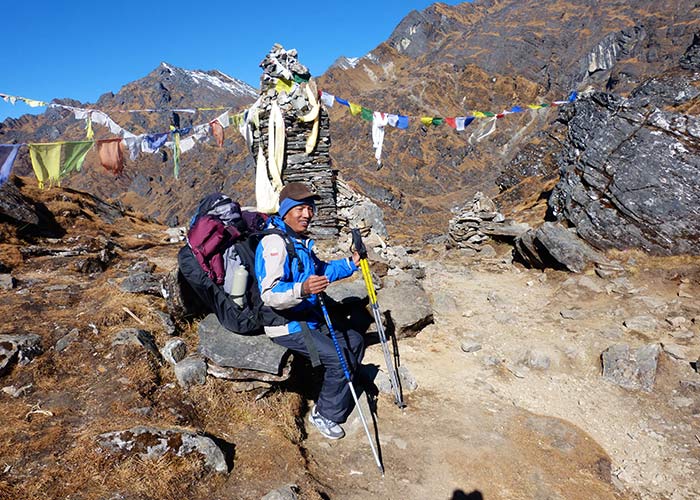
Equipment List
- Day Pack (35-45 L)
- Sleeping Bag (-20F/-30C recommended)
- Down Jacket
- Trekking Boots
- Crocs (evenings & washing)
- Trekking Pants (2-3)
- T-Shirts (3)
- Long-sleeve Trekking Shirts (2-3)
- Trekking Jacket
- Gortex (or similar) Jacket & Pants
- Fleece or Thermal Top (evenings)
- Fleece or Thermal Bottoms (evenings)
- Lightweight Long Underwear (to sleep in or layer under clothes)
- Gloves (lighter & heavier for passes)
- Baseball Cap or Wide-brimmed Hat
- Trekking Poles (optional, recommended)
- Down Booties (optional, recommended)
- Sunglasses (2)
- Water Bottles | Nalgenes (2-3)
- Bladder (optional, recommended)
- Toiletries, Sunscreen with SPF, Lip Balm with SPF
- Watch (with alarm)
- Extra Batteries
- Battery Chargers
- Head Lamp (2)
- Yak Trax (for treks with icy passes)
- Water Purifying Tablets, Small Water Filter or Steripen
- Camp Washing Bowl (optional, collapsible for clothes)
- Laundry Detergent (Kathmandu) or Bio-degradable Clothes Soap
- Hand Sanitizer
- Small Solar Panel (optional, recommended for iPods, iPhones, camera batteries, Kindles)
- Zip-Lock | Plastic Bags
- Soft Toilet Paper | Tissues (we supply toilet paper but you will want something softer for blowing your nose)
- Baby-Wipes | Wet-Wipes (for personal cleaning)
- Handi-Wipes, J-Cloth, or Chux (optional: easy for a quick daytime clean, fast drying)
- Rehydration | Electrolytes
- Personal Medical Supplies
- Available in Namche Bazaar
- Snacks, chocolate bars, energy bars (Western brands), dried fruit & nuts
- Laundry Detergent
- ALL trekking gear (Sherpa Gear, Mountain Hardwear, Tsetang’s Gear Shop all have real gear), real & knock-offs.
- Lemon Tang (for water if you want)
- Trekking Poles
- Micro Spikes
- Medical Supplies
- We strongly suggest bringing Western meds with you as there are a lot of Indian fakes on the market!
- Suggested: Diamox, Azithromycin, Ciprofloxacin, Tinidazole, or Flagyl & Augmentin. Bring COMPEED for covering blisters & good tasting electrolytes &/or rehydration salts (Emergen-C is a good American brand). The local versions aren’t very appealing.
- We also recommend bringing strong knee & ankle supports & braces, ACE bandages for sprains & strains, Tegaderm &/or other would coverings. Duct tape is always useful. We’re happy to take excess medical supplies off your hands when you leave if you won’t need them and pass them on to others. We use lots of the large amount we have with us to treat locals we meet when trekking.
Related Trips
You will also like …
- View Details
- Enquire Now
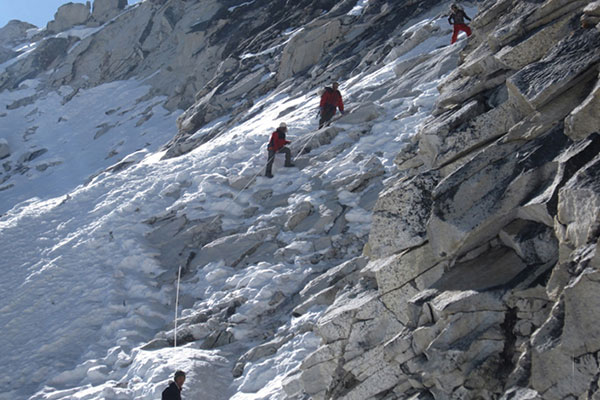
Mera Peak Climbing with Amphu Laptsa Pass
- Strenuous Plus
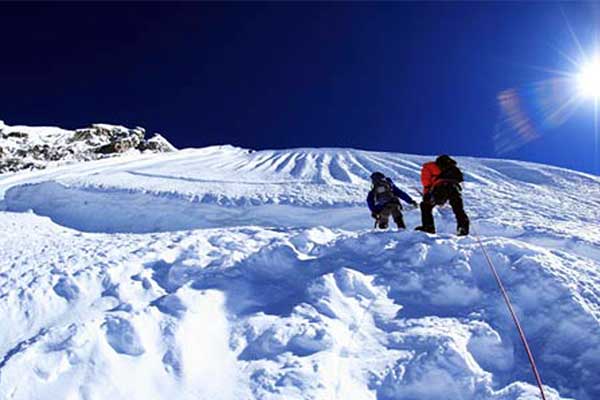
Chulu Far East Peak Climbing
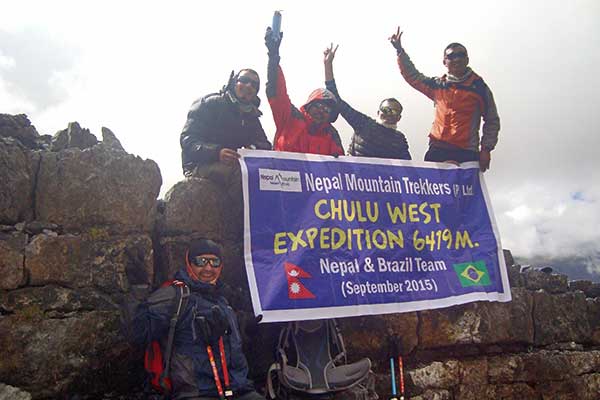
Chulu West Peak Climbing
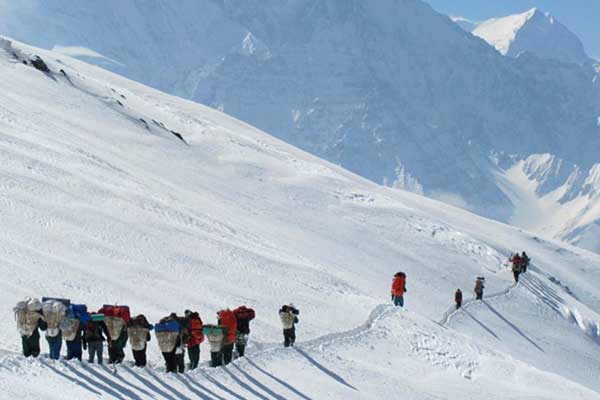
Dhaulagiri Trek with Dhampus (Thapa) Peak Climbing
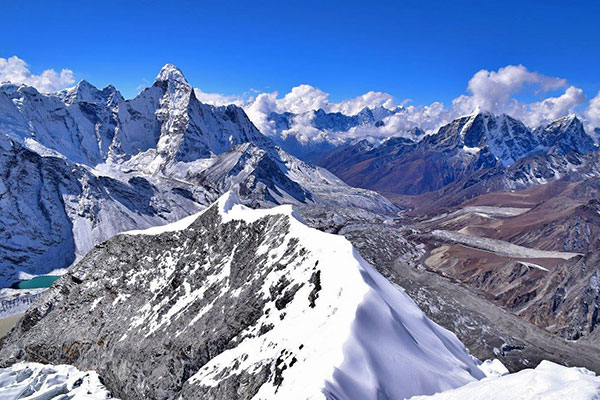
Everest Base Camp Trek with Island Peak Climbing
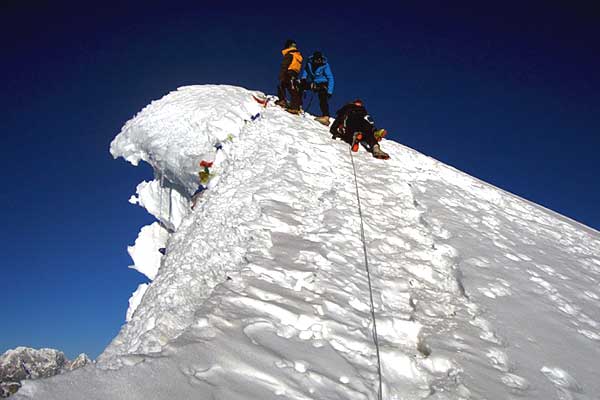
Everest Base Camp and Lobuche East Peak Climbing
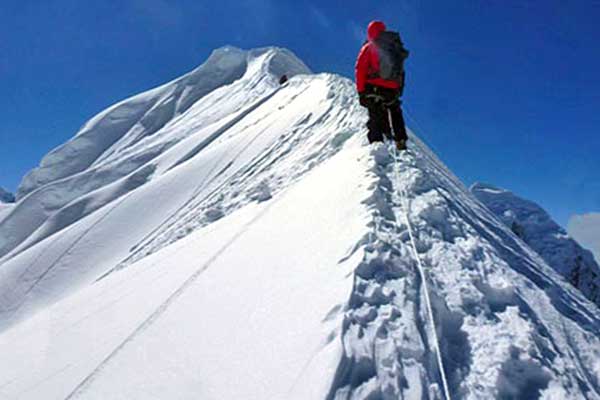
Hiunchuli Peak Climbing
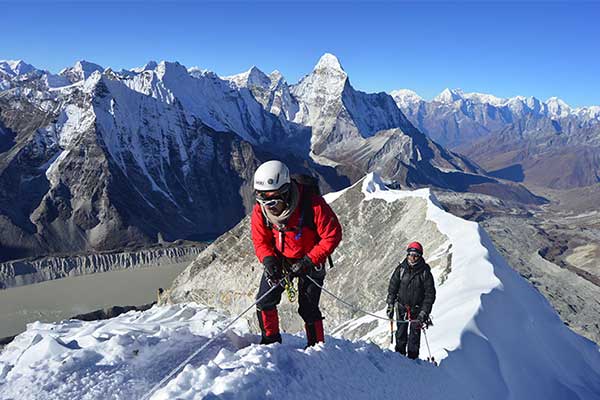
Island Peak Climbing
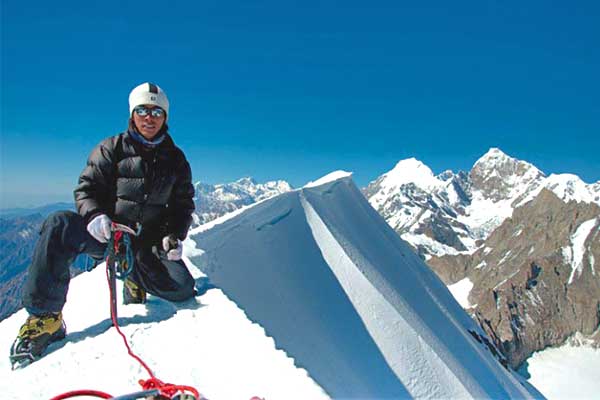
Paldor Peak Climbing
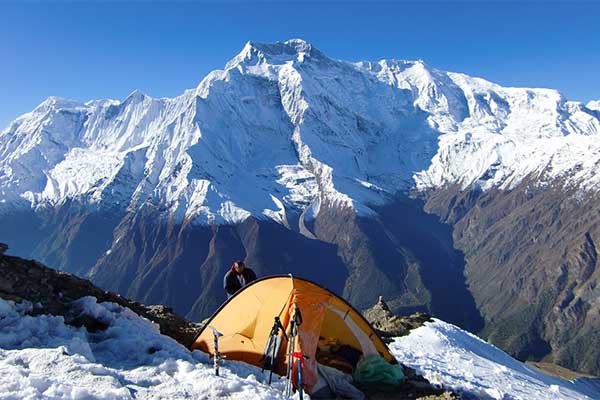
Pisang Peak Climbing
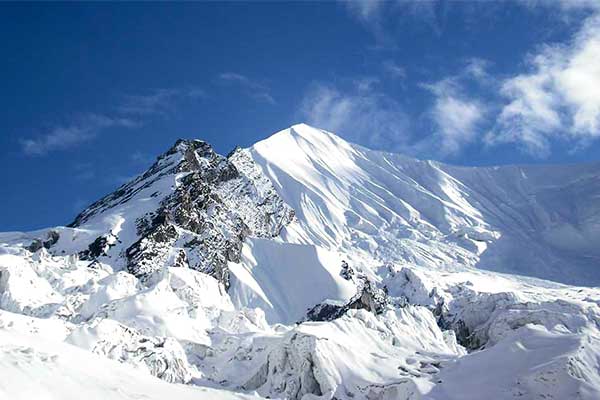
Rolwaling plus Pachermo Peak Climbing
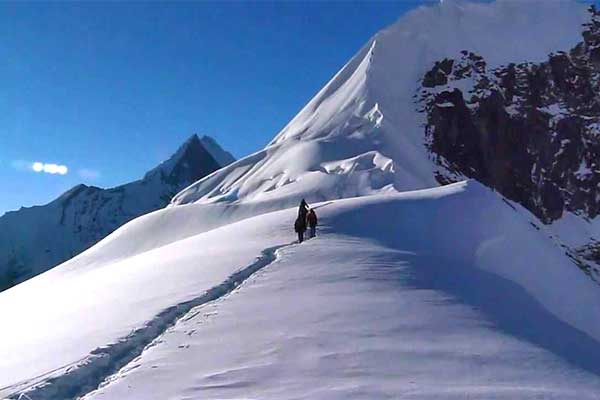
Tharpu Chuli (Tent) Peak Climbing
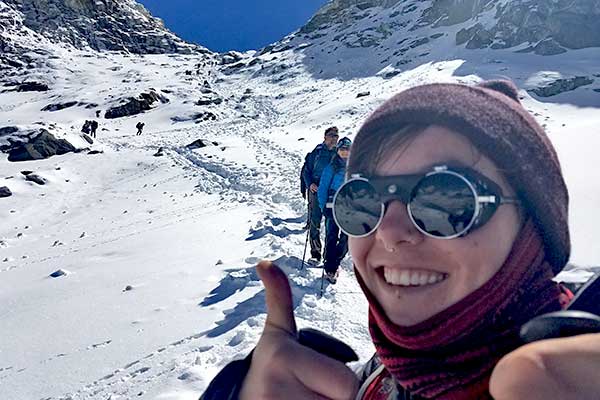
Two-Pass plus Two Peak Climbing
Clients review.
What our customers say about us
A truly amazing climbing experience and remarkable memories!
What’s the best way to trek in to Mera Peak? Only with Ramesh’s team! A lot of the success and enjoyment during the treck comes from good teamwork and communication and you can be sure that it won’t be missed. The treck is not technical but quite demanding but offering majestic views! Ramesh and his guides and porters are very knowledgable and get personally involved in the trips so you can be sure you are in good hands. They are fast, strong and trustworthy. Krishna, our guide turned out to be an excelent teacher as well and at the end of the trip I knew basic Nepali phrases! I am looking forward to continuing to hike/treck/climb with Ramesh and his team for as long as my itchy feet are able!!
WE ARE ASSOCIATED WITH
SEND US A MESSAGE

+977-9802342081
Thamel, Kathmandu, Nepal
Mera Peak Climb - 18 Days

Trekking, Sightseeing & Climbing
Breakfast in Kathmandu and all meals during the trek/climb
Minimum 2; max on group availability
Private vehicle/Flight
Lukla- Chatunga- Zatrawala- Khare- Mera Base Camp- High Camp- Summit & return
March to May & Sep to Dec

We support online payment
Customize this trip as per your need.
Big groups are adjusted accordingly.
Adjust your budget depending on your need.
You can schedule your own departure dates.
Send us your queries or requests:
Your information will never be shared with anyone outside our company.
Departure Date
Mera Peak Climb is a crucial trek ascent for hikers, expert or novice, who have aspirations of summiting the mountain. Mera Peak (6,476m) is the highest of the trekking peaks in Nepal which is also designated as one of the hardest treks ever completed in Nepal which seeks higher climbing experience.
Mera Peak Climb Trip Introduction:
Starting from the arrival, we have an 18 days guided trip to Mera Peak that includes two summits. The exhilarating journey starts from Lukla and travels through the remoteness of the Khumbu region till we reach the Zatar La pass(4, 610m) before our journey to the Mera Peak(4,800m/ 15,700ft).
The majority of the climb calls for fundamental crampon and ice axe skills. Five of the tallest mountains in the world—Cho Oyu (8,201 m/26,906 ft), Lhotse (8,516 m/27,939 ft), Makalu (8,463 m/27,765 ft), and Kangchenjunga (8,586 m/28,169 ft) in the far east—are easily visible in the journey.
Itinerary Outline:
1st Day: Arrival day in Kathmandu (1,300m/4,265 ft) 2nd Day: Kathmandu Valley sightseeing & trip preparation 3rd Day: Flight to Lukla (2,800m/9,186ft), 40 minutes flight 4th Day: Trek to Chutanga (3,430m/11,250ft), 3-4 hrs walks 5th Day: Trek to Chhatre Danda (4,000m/13,160ft), 5-6 hrs 6th Day: Trek to Mausum Kharka (3,430m/11,250ft), 3-4 hrs walks 7th Day: Trek to Thagnag (4,360m/14,301ft), 5-6 hrs walk 8th Day: Rest day for acclimatization 9th Day: Trek to Khare (5,000m/16,400ft), 4-5 hrs walk 10th Day: Rest Day/ Ice Climbing near Khare 11th Day: Trek to Mera Base Camp (5350m/17548ft), 4 hrs walk 12th Day: Trek to Mera High Camp (5,800m/19,024ft), 5-6 hrs walk 13th Day: Summiting the Mera Peak (6,476m/21,247ft) and descend to Khare (5,025m/16,486ft) 14th Day: Return back to Gothey(3600m/11,812ft) 15th Day: Trek to Tuli Kharka (4250m/13,944ft) 16th Day: Trek back to Lukla via crossing Zatrwa la (4,600m/15,093ft) 17th Day: Flight back to Kathmandu, 40-minute flight 18th Day: Departure from Kathmandu End of our services
Trip Cost Includes:
✅ All airport and hotel transportation by private vehicle in Kathmandu as per the itinerary suggested. ✅ Deluxe twin-sharing accommodation in Kathmandu with breakfast ✅ F arewell dinner in Kathmandu (Alcoholic beverages are excluded) ✅ Private transportation cost to and from Kathmandu to the destination ✅ Full board meal (breakfast, lunch, dinner, tea & coffee) during the trek ✅ Seasonal fruits during the trek are provided ✅ Comfortable & clean accommodation on teahouse/lodge/tent during the trek ✅ Government Registered Trek guide (English speaking, First Aid and eco trained), Sherpa porter (one porter for two trekkers) ✅ All necessary paper works, Entry fees, permits & TIMS card ✅ Down jacket, four seasonal sleeping bags, Nepal Vision Treks duffel bag, and trekking map (sleeping bag to be returned after trip completion) ✅ First aid exclusive medical kit bag ✅ All government and local taxes
Trip Cost Excludes:
❌ Visa fees (You can obtain a visa easily upon your arrival at Tribhuwan International Airport in Kathmandu so (bring accurate USD cash and two passport photographs)) International airfare to and from Kathmandu ❌ Lunch and dinner except for welcome & fare well dinner (and also in the case of early return from the mountain than the scheduled plan) ❌ Any extra night accommodation in Kathmandu because of early arrival, late departure, and early return from the mountain (due to any reason) than the scheduled itinerary plan ❌ Travel and rescue insurance
Mera Peak Climb Trek Map

Day 01: Arrival day in Kathmandu (1,300m/4,264 ft)
Day 02: kathmandu valley sightseeing & trip preparation, day 03: flight to lukla (2,800m/9,186ft), 40 minutes flight, day 04: trek to chutanga (3,430m/11,250ft), 3-4 hrs walks, day 05: trek to chhatre danda (4,000m/13,160ft), 5-6 hrs, day 06: trek to mausum kharka (3,430m/11,250ft), 3-4 hrs walks, day 07: trek to thagnag (4,360m/14,301ft), 5-6 hrs walk, day 08: rest day for acclimatization, day 09: trek to khare (5,000m/16,400ft), 4-5 hrs walk, day 10: rest day/ ice climbing near khare, day 11: trek to mera base camp (5000m/16400ft), 3-4 hrs walk , day 12: trek to mera high camp (5,800m/19,024ft), 5-6 hrs walk, day 13: summiting the mera peak (6,476m/21,247ft) and descend to khare (5,025m/16,486ft), day 14: return back to gothey(3600m/11,812ft), day 15: trek to tuli kharka ( 4250m/13,944ft), day 16: trek back to lukla via crossing zatrwa la (4,600m/15,093ft), day 17: flight back to kathmandu, 40-minute's flight, day 18: departure from kathmandu, how long is the mera peak climb, is mera peak climb more difficult than island peak, can you climb mera peak without a guide, is mera peak rugged.
We provide a series of fixed departure trek, tour and expeditions in Nepal, Bhutan, Tibet and India. If you are single and wishing to be with a group, you can join our fixed departure schedule. If the schedule dates are not convenient for you, contact us & let us know; we are more than happy to customize our trips to suit your needs. If any individuals or group doesn’t want to join with our other group, we can operate as per your wish and requirement. We are ground operator of these Himalayan destination and able to arrange your trip as per your interested date and choice.
Check out all the available dates
Traveller's Reviews

I did Island peak with Nepal vision at 2023 with my friends. They Organize every thing very we... See more

We did the 14 day Mera Summit trip with Nepal Vision and everything was perfect! Preparing for the t... See more
Dennis Albert & Danniel

This is my third time to the Himalayas, and my first trip with Nepal Vision. They were excellent, an... See more
Abhishek Mehra

I recently went on a trek with Nepal Vision Trek to Mera Peak, and I can confidently say that it was... See more

I had a beautiful trek in the mountains with my guide Ram. He was a delight and well experienced in... See more

Hello Namaste Everybody!!!!!!!Nepal Vision is on of the trusted company in my life because I booked... See more
Usek Yarmolenko

I took a peak climbing tour to Mera & Island Peak in Oct/Nov. It was truly a journey of a lifeti... See more
O. Marshall

I wish send to you my best thank you for your wonderful organization. Every thing was perfect since... See more
Carlo Volpi

My upmost thanks to my favourite trekking agency “Nepal Vision” this was a my 4th trip t... See more

What started as a New Years idea 18 months earlier brought four friends from different corners of th... See more
John Goulter, NZ

Keshav I would like to express my thanks and full satisfaction for the wonderful Mera Peak trek arra... See more
Aliakbar Eslahchi

After looking through about a dozen trekking agencies I chose Nepal Vision, as they were the fastest... See more
Mr. Ashley Hall

Speak to one of our travel consultants:
Call Us (24/7): +977-9802342080
WhatsApp (24/7): +977-9802342081
Customize Package
A spectacular route to Mera Peak
Mera peak summit day, why climb with adventure peaks, you may also like:, dates & prices, availability, what's included, what's excluded, trip dossier, for uk based clients:, for non-uk based clients:, leave a review.
+977 9841319155
Mera Peak Climbing
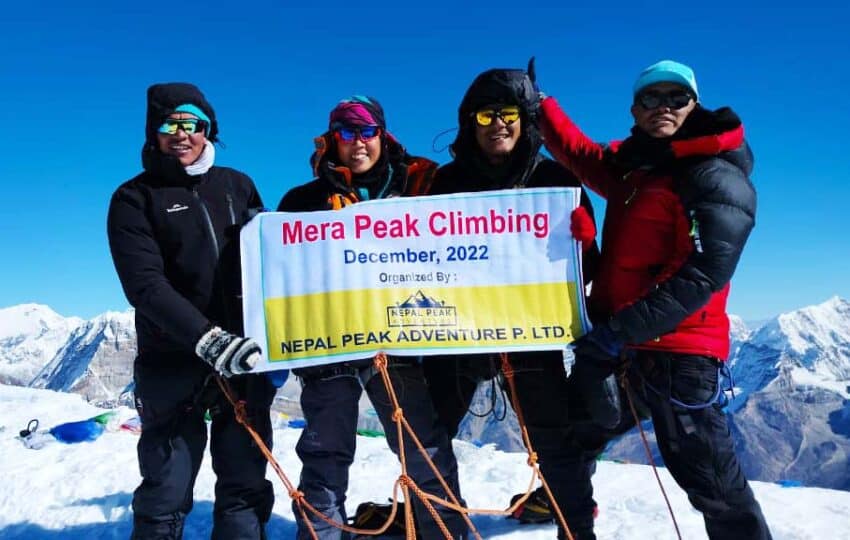
Description
Things to know before choosing Mera Peak Climbing Package:
- Mera Peak Climbing takes you to the max elevation of 6,476 meters (21,247 feet) involves trekking activities too and has a risk of altitude sickness.
- All-inclusive except international flight tickets & which are not included in the cost inclusion down below.
- In terms of difficulty, Mera Peak is a challenging peak that involves steep inclines, high altitude, long days of walking, unpredictable weather & climbing.
- It requires Sagarmatha National Park Entry Permit, Mera Peak Climbing Permit & several fees like garbage deposit fee & peak royalty fee.
- The physical fitness required for the Mera Peak Climb is very high and need professional help to manage your routine.
- To have a safe & sustainable climb in Mera Peak Nepal, you need to acclimatize for a day or two.

About Mera Peak Climbing:
Mera Peak Climbing is considered one of the adventurous climbing that rises to the south of Mount Everest. This climbing package takes you to the pinnacle of the famous mountain introducing you to the unique alpine terrain and allowing you to have insights into local lives.Walking through a dense alpine forest and enjoying the snowcapped mountains induce nothing but blissful euphoria in you. On the way to Mera Peak, you will walk through numerous passes including Kari La Pass, Panggom La Pass, and Mera La Pass.
Throughout the expedition, you will have the opportunity to immerse yourself in the unique culture and traditions of the Sherpa community. Interact with the friendly locals, visit ancient monasteries, and gain insights into their mountain way of life. The warm hospitality and rich cultural heritage will add depth and meaning to your climbing experience.
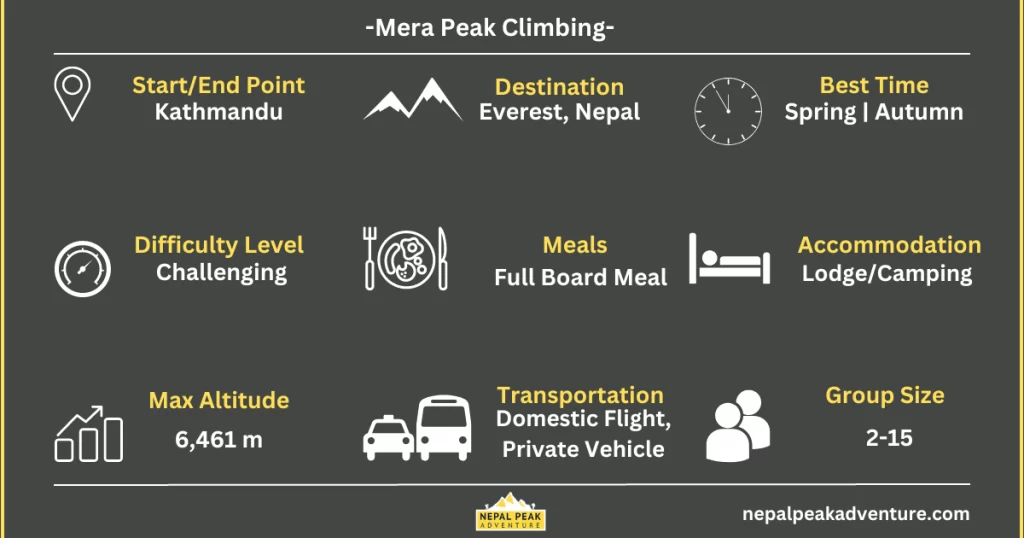
Embark on this 18-day thrilling journey to conquer the mighty Mera Peak with Nepal Peak Adventure. We guarantee you to make your Mera Peak Climbing expedition a safe, thrilling, and unforgettable journey of a lifetime.
Services Included & Excluded in Mera Peak Package:
- Airport pick-up and transfer to your hotel via private vehicle
- Welcome dinner at a reputable Nepalese Restaurant with a Nepali cultural program
- Tourist standard Hotel in Kathmandu with breakfast based on Twin Sharing | B&B
- Domestic Transfers & Domestic Flight from Kathmandu- Lukla- Kathmandu | Flight Fare (During Off-season) or
- Domestic Transfers & Domestic Flight from Ramechhap-Lukla-Ramechhap | Flight Fare (Spring & Autumn season)
- Teahouse/Mountain Lodge and Tent accommodation during the climbing
- All meals during the Trekking and Climbing | Full Board meal
- 3 cups of Tea/Coffee per day during Trekking times
- Seasonal Fruits after Dinner During Trekking
- Experienced Climbing Guide (Government-certified experienced, fluent English speaker, first aid and eco-trained expedition guide)
- Assistant Guides: We provide an assistant guide as per the group size to support wherever necessary
- Sherpa Porters: We provide porters as per the necessity to carry your stuff
- All Expenses of Guides & Porters (Insurance, Salary, Food, etc)
- All Climbing Permit Fee required for the Mera Peak
- All federal and local taxes as applicable
- Down Jacket and sleeping bags (upon request)
- A duffle Bag (for the expedition purpose only) and a T-shirt (as a souvenir)
- Mera Peak Climbing Trekking map
- Certificate ofPeak Climbing Completion
- Group medical Kit Box with all useful medicines
- Unlimited Hydration Tablet during the trek
- Emergency Helicopter evacuation service according to your travel insurance
- Farewell Dinner in a Nepalese Restaurant with Live Cultural Programa
- Final departure transfer Transfer Via Private Vehicle
Cost Exclusion in Mera Peak Package
- On-arrival Nepal Visa Fee
- International flight ticket to Kathmandu and a return ticket from Nepal.
- Other extra foods besides welcome dinner, farewell dinner, and all meals during the trek.
- The entire cost of beverages items (except hot drinks mentioned in the inclusion list), mineral water and beer, etc. while on the treks
- Travel or trekking insurance (must include Helicopter evacuation)
- Tipping to your Guide, Porter, Sherpa, and all the climbing crew
- Climbing equipment for personal uses
- Items that are not included in the inclusion list
18 Days Outline of Mera Peak Itinerary:
Here is the 18-day outline of the Mera Peak Itinerary. Please note that this itinerary is prepared by professionals and it can also be customized.
- Day 01: Arrival in Kathmandu, Nepal (4,593 ft) and transfer to Hotel via Private Vehicle
- Day 02: Sightseeing inside Kathmandu Valley and Trek preparation
- Day 03: Flight to Lukla (2860m) from Kathmandu or Ramechhap and trek to Paiya (2730m) | 30-minute flight and 3-4 hour trek
- Day 04: Trek to Panggom (2846m) – 5/6 hour
- Day 05: Panggom to Ningsow (2863m) – 4/5 hour trek
- Day 06: Trek to Chhatra Khola (2800m) – 7/8 hour
- Day 07: Trek to Kothe (3691m) from Chhatra Khola – 6/7 hour
- Day 08: Trek to Thagnak (4358m) 3-4 hour
- Day 09: Trek to Khare (5045m) – 2/3 hour
- Day 10: Khare: Acclimatization and pre-climbing training
- Day 11: Trek to Mera High Camp (5780m) – 6/7 hour
- Day 12: Climb to Summit (6461m) and return to Khare (5045m) – 8/9 hour
- Day 13: Reserve Day for Contingency
- Day 14: Trek to Kothe (3600m) – 4/5 hour
- Day 15: Trek to Thuli Kharka (4300 m) – 5/6 hour
- Day 16: Trek to Lukla (2642m) – 6/7 hour
- Day 17: Fly back to Kathmandu (1400m) – a 30-minute flight
- Day 18: Departure from Kathmandu
Outline of Mera Peak Map:
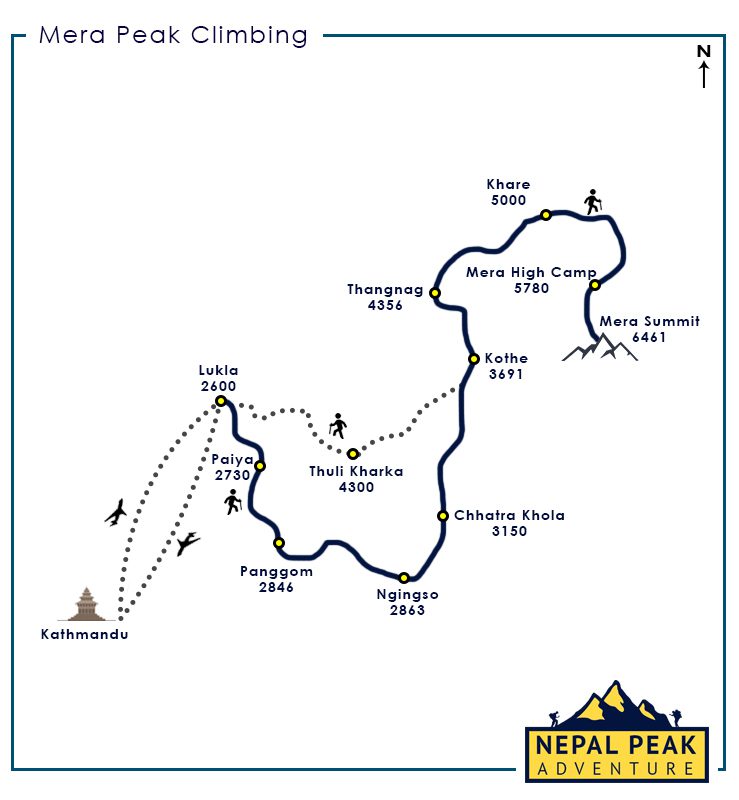
The journey then takes you to the Khare on the 7 th day by crossing the beautiful villages on the way. Also, you will walk through the rhododendron forests, and oak, silver fir, and birch woodlands, which are also highlights of the walk.
You will stop at Khare one more day for acclimatization and climbing preparations. From Khare, you will get the first glimpse of the Mera Peak summit. After spending two nights in Khare, we will head to Mera High Camp (5,780m), the day before the Mera summit and further continue the journey finally to the Mera Peak Summit. On this day we walk very early in the morning in the dark. The first rays of sunlight striking the peak of the Himalayas is a sight to behold.
After a successful Mera summit, we will then head back to the Khare for an overnight stay. From here we will return back the same trail via Kothe back to the Lukla. We will enjoy our last night in Lukla and fly back to Kathmandu bidding farewell to the Nepal Himalayas.
Exploring the Mera Peak Climbing Difficulty Level
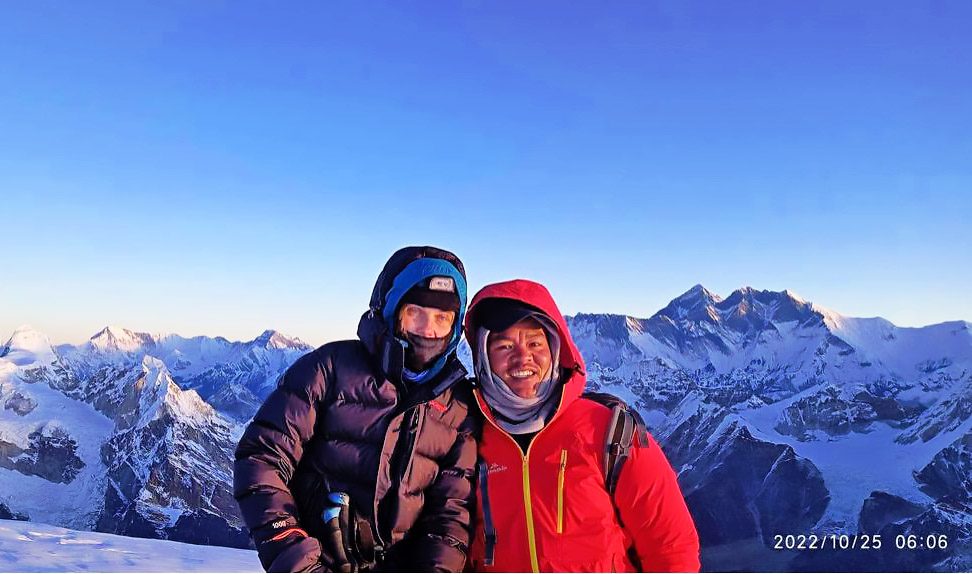
Mera Peak Climb requires a long walk of 6/7 hours on a daily basis. In addition, you have to walk through rough and rocky trails. Most parts of the Mera Peak Climbing involve trekking and only the last part is climbing to the Mera summit from the Mera Base Camp. It takes a total of three days for climbing from the base camp to Mera Peak and back to the base camp.
However, the majority of the route is non-technical and straightforward. Hence, it is best suited for beginner climbers who want to start the mountaineering journey, experience high-altitude adventure, or hone their climbing abilities.
The most problematic factors that affect Mera Peak Climbing are altitude sickness, unpredictable weather, trails & terrains, physical fitness requirement, technical skills, and many more. Down below are some guides that can help you counter the Mera Peak Difficulty.
Fitness & Preparation for Mera Peak Climbing
Climbing to the highest trekking Mera Peak at an altitude of 6,6467m requires a great deal of physical fitness and mental stability. Though Mera Peak is considered to be the easiest, it has some technical parts and possesses hurdles and challenges. High altitude and weather are the other major aspects that need to be taken into consideration. Hence, you need good fitness and good knowledge to use climbing gear and equipment.If you are planning to climb the Mera Peak summit then you need to be well prepared and do a lot of training. Below is the list of training & guide you need to start doing now.
- Cardiovascular Training
- Hiking Training
- Eating Proper Diet
- Endurance Training
- Mental Preparation
I have made a full guide about " How to train for peak climbing: Tips from Pros ", so check that out if you are interested.
Mera Peak Gear & Equipment Lists
Mera Peak offers you the finest and most thrilling climbing experiences. While going for such a lifetime adventure you must be well prepared.And having the right gear in your backpack will definitely make a huge difference. You have to be very careful while packing the Mera Peak gear list. Make sure you don’t overpack. Try to make it as light as possible. Good preparation will make your journey easier and more enjoyable.
Here is the list of essential gear and equipment you need for Mera Peak Climbing.
Read our Ultimate Mera Peak Packing List in detail.
Note: All of these items are easily accessible in Thamel, Kathmandu. You can buy or rent it too. Our company will manage all of the listed items for you.
Meals and Accommodation during Trek & Climbing
Mera Peak expedition is a combination of the teahouse and camping trek. During the whole trip, we try to provide you with the best possible accommodation and food. Firstly, upon your arrival in Kathmandu, you will be transferred to one of the star hotels in Thamel. We provide a three-night stay in Kathmandu.During the trek, your stay will be in the teahouse for 12 nights and around 2 nights in a tented camp. The rooms on the teahouse are provided on the basis of twins sharing. We will camp one night at Mera High Camp and the other one is during reserve day for contingency.
We provide full board meals (breakfast, lunch, dinner) with tea or coffee on every meal on the trek. You can choose from a wide range of menu items that are offered by the teahouses. And while on the camp our staff/team cooks and prepares the food.
Overall, the Mera Peak climbing expedition is a mixed combination of all sorts of trekking and climbing experience.
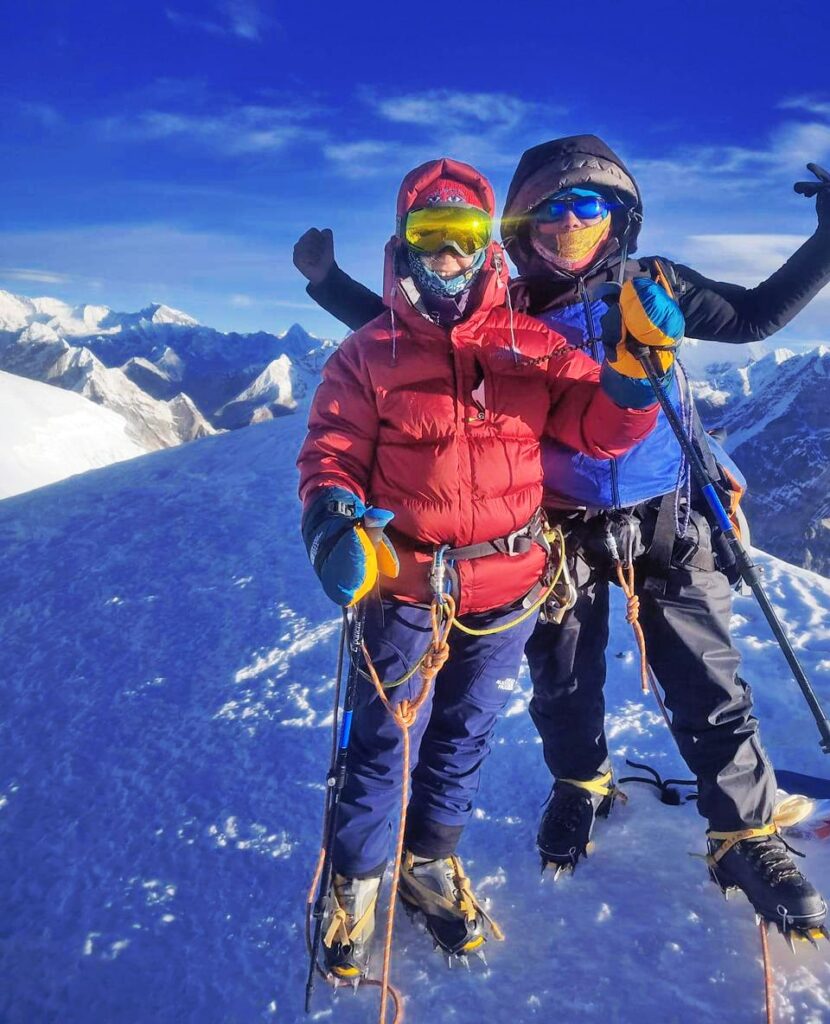
Mera Peak Climbing FAQs
Is mera peak climbing dangerous, where is mera peak, what is the mera peak climbing cost.
The cost of climbing Mera Peak depends on several factors such as services, itinerary, and guide, as we as the number of climbers in the group. On average, the cost of climbing Mera Peak can range from $2,500 to $5,000 per person.But we are selling at a best-selling price of $2,590 with a duration of 18 Days. All the cost inclusion & exclusion is listed above.
How Difficult is Climbing Mera Peak?
Considered a technical moderate climbing peak, Mera Peak is a challenging peak that requires good mountaineering experience & good physical condition. The major factors that make Mera Peak difficult are glaciers, crevasses, challenging terrain, snow-covered slopes & altitudes, unpredictable weather, and extreme cold.The Mera Peak climbing also requires technical equipment such as crampons, ice axe, harnesses, carabiners, camping equipment, & many useful gears. Similarly, with a help of an experienced climbing guide, climbing Mera Peak will be a lot easier and safer.
About Airport Pick Up and Drop Off:
One of our company representatives will be there to pick you up at the airport either with our company signboard or with your name. You will be then transferred to the designated hotel in Thamel by private vehicle.
Likewise, on your departure day, our company will drop you off at the airport from the hotel by private vehicle.
Emergency Rescue in Mera Peak:
Will i get a certificate of achievement after the succession of peak climbing, can a beginner climb mera peak.
Yes, a beginner can climb Mera Peak with the appropriate training, preparation, and support. Mera Peak is considered a suitable choice for novice climbers who are physically fit and have some prior trekking experience. Beginners should engage in a comprehensive training program that includes cardiovascular exercises, strength training, and endurance-building activities. It is also crucial to acclimatize properly to the high altitude by undertaking gradual ascents and allowing sufficient time for rest and adaptation.
Nepal Peak Adventure company offers Mera Peak expeditions that are specifically designed for beginners and novice climbers.
How long is the Mera Peak trek?
Who are we.

- Summit Mera Peak 6,461m; one of the popular peaks in Nepal
- Outstanding close-up views of tallest mountains, Mt. Everest, Mt. Lhotse, Mt. Makalu from the summit.
- Climb with Professional Sherpa with 20 years of experience in peak climbing like Mera Peak.
- Minimal Technical climbing peak and considered moderate level among other climbing peaks.
- Tent, Accommodation, Meals, Porter everything included in the pacakge.
Today will be your arrival day at Tribhuvan Airport of Kathmandu. Upon arrival at the airport, you will need to have your on-arrival visa if you don't have one. After all the paperwork and checking inside the airport, you will find us outside the exit door.
One of our representatives will be outside waiting for your arrival with your name on the board. After meeting him, he will bring you to your booked hotel. From the airport, it may take 35-45 minutes to reach your hotel in the Thamel area.
The dinner will be from us Nepal Peak Team in a reputed Nepali Restaurant which will also present you with beautiful cultural dance.
Sightseeing inside Kathmandu Valley is the best thing you can do while staying in Kathmandu. Today, we will visit the famous places in Kathmandu, which have historical sites, stupas, temples, Durbar Square, and many more cultures.
After finishing sightseeing in Kathmandu, you will return back to your hotel. Things like money exchange, renting gear, or buying gear should be done today as we will start the trek tomorrow.
During peak season, the flight to Lukla is operated from Ramechhap Airport which is why we will leave Kathmandu early. Usually, it takes 4-5 hours to reach Ramechhap from Kathmandu via private vehicle. Only during the off-season, Lukla flights are operated from Kathmandu.
From Ramechhap Airport, it only takes 15-20 minutes to reach Lukla which will be a most amazing flight with beautiful scenery of mountains. The guide will be with you all the time from Kathmandu to Lukla so you don't have to worry.
After arriving at Lukla, you will meet your porter there and you will have a short break at Lukla. After some breaks, the trek will start from Lukla to Paiya.
Paiya/Puiya is a small village and a famous starting point for the Mera Peak Climbing trek. Crossing some nearby villages Surke beside Dudh Koshi River, the trek is steep up to Chutok La a saddle & then steep down to Puiya village.
We will start our trek early in the morning downhill and cross the bridge. After crossing the bridge, it is steeped up to Khari La Pass and steeped down to Kare. We should be careful when crossing the Khari La Pass as the roads will be very slippery.
After lunch, you will walk through narrow paths encountering bamboo and rhododendron trees. On the way, you will have magnificent views of Dudhkoshi Valley and Dudh Kund Himal. After this, you will reach Panggom for an overnight stay.
After breakfast, you will start ascending to reach Panggom La Pass. You will then climb up to cross Peseng Kharka Khola (a local stream) after which you will reach Peng Kharka Danda (hill). Enjoying the beautiful landscapes around, you will cross a local Ningsow Khola to reach your today’s destination, Ningsow village.
In the beginning, you will walk on a down and uphill trail until you reach Ramailo Danda. From this point, you can enjoy the view of Mera Peak. After a short break, a further walk takes you into the Makalu Barun National Park. Then we start the Pasang Lhamu trail to reach Chhatra Khola where you halt for the day.
You will start the day with a hike to Hinku valley. Then, you will follow the leisurely trail to reach Tashinig Ongma. This is the place of seasonal teahouse where you will have lunch. You will continue walking to pass through Sanu Khola until you reach Kothe for the overnight stay.
After breakfast, you will trek along the Hinku Khola and reach Gondishung for lunch. We will then visit a 200-year-old monastery called Lungsumgba Gompa where travelers receive blessings from the Lamas for their climb. You will stroll around the clo ister for a short time before you leave for Thagnak where you stop for the day.
As you resume the trek today, you will follow the lateral moraine of Dig Glacier to Dig Kharka. From this place, you can enjoy the view of Charpate Himal. The trail will then climb through moraines to the snout of the Hinku Nup and Shar glaciers. Then you will have a steep climb to reach Khare where you stay overnight.
Today, you will spend at Khare for acclimatization purpose. Moreover, you will prepare yourself for the Mera Peak climbing with the orientation on the use of climbing gears namely ice axe, harness and crampons. You will also learn to use the rope while climbing. Overnight at Khare.
Today you will hike to Mera Peak Base Camp by walking through the boulder-strewn course on a steep trail. You will cross Mera La pass to reach the Mera High Camp. The campsite at the High Camp offers majestic views of Mount Everest, Makalu, Cho Oyu, the south face of Lhotse amongst others.
Today, you will start climbing early in the morning and ascend a cliff. After a while, the slope steepens making the trail difficult to walk. At the foot of the summit, you can use a fixed rope to reach the top. You will enjoy the views of Mt. Everest, Lhotse, and Makalu and the mountain terrain from the top. You will return to high camp and descend to Khare for the overnight stay.
Due to adverse weather in the mountains and other circumstances sometimes you cannot go as per the planned itinerary, so this is a reserve day for a contingency plan. If everything goes as per the itinerary and weather remains favorable, you will skip this day and continue the trip.
You will retrace the path to Kothe from Khare. The trail is rough with fields and scarce settlement. Upon reaching Kothe, you can celebrate the success of summiting Mera Peak with your crew members. Overnight at Kothe.
Today you will walk on an up and downhill trail passing through Inkhu Khola to reach Taktho. Further, you will pass a Chorten on the way and then climb downhill on a steep trail. After this, you will ascend to Thuli Kharka and pass another Chorten before reaching today’s destination, Thuli Kharka.
After breakfast today, you will start ascending to reach Zatra La Pass. From here, you will leave the Makalu Barun National Park and get fascinated with the beauty of Lukla valley. Then, you will descend to Chutanga and walk on an easy trail leading to Lukla. Overnight at Lukla.
Flights to and from Lukla are scheduled in early hours considering unpredictable weather conditions. So, we take an early flight back to Kathmandu leaving behind the spectacular mountains. Upon arrival at Kathmandu, the guide will escort you to the hotel. You can stroll around the city and relax in the afternoon.
Your Mera peak climbing trip ends today after eighteen adventurous days. We will transfer you to Tribhuvan International Airport to catch your scheduled international flight.
Things to do upon your Arrival at Kathmandu before your trek:
Upon your arrival at Kathmandu’s Tribhuvan International Airport, a representative from our company will be there to extend a warm welcome to you. You will then be swiftly transferred to the hotel in a private vehicle. Upon reaching the hotel, you can check in and take some time to relax. At the scheduled time, our company owner, Hom Rana, will personally greet you for the trip briefing on the Everest Base Camp Trek, providing comprehensive details.
During this briefing, we will carefully go through your packing list to ensure you have everything you need. Additionally, you will have the opportunity to meet your trek guide and receive essential items such as the company duffel bag, t-shirt, cap, and trekking map.
In the evening, we cordially invite you to join us for a welcome dinner hosted by the company. Following this, the next day you will embark on a flight to Lukla to commence your trekking adventure.
Lukla Flight Information (Kathmandu & Ramechhap):
We would like to update you on important changes regarding Lukla flights during peak trek seasons (March, April, May, October, and November). Due to increased air traffic in these months, Lukla flights will be operated from Manthali airport in Ramechhap instead of Kathmandu. However, during non-peak seasons (January, February, June, July, August, September, and December), Lukla flights will continue to operate from Kathmandu.
If you are catching a Lukla flight from Ramechhap, please be advised that you need to depart from Kathmandu early in the morning, around 1:30 to 2:00 AM. The journey from Kathmandu to Ramechhap takes approximately 4-5 hours. Your guide will arrive at your hotel at the specified time to pick you up and drive you to Ramechhap.
It’s important to note that Lukla flights may face disruptions due to factors such as bad weather, airline technical problems, and other unforeseen circumstances. Therefore, we recommend planning for an additional 2-3 days as a contingency to accommodate potential delays.
We appreciate your understanding and cooperation in adapting to these changes for a smoother and more enjoyable trekking experience.
Tea House Meals During EBC Trek:
Nepal Peak Adventure consistently provides our clients with top-notch lodging and dining options. Our Everest Base Camp package includes three full-board meals: breakfast, lunch, and dinner, complemented by tea or coffee at each meal. Throughout the trek, you can choose your meals from the teahouse menu, which offers a variety of local and international dishes, ensuring you maintain energy levels with nourishing meals.
You have the flexibility to opt for Nepali, Western, or Indian cuisines during the entire trek, and the cost of food is covered in the package, allowing you to relish your preferred meals. We highly recommend trying Dal and Bhaat, a typical Nepali dish. For day hikes, it’s beneficial to carry energy bars or dried fruits and stay well-hydrated.
For health reasons, we strongly advise against consuming non-vegetarian items throughout the trek.
Typical Day during EBC trek:
Your trek officially begins upon your arrival in Lukla. Each day, a typical routine commences with a substantial breakfast served between 6:30 to 7:30 AM. After breakfast, you set out on your trek, progressing toward the planned destinations. Before starting the trek, it is advisable to pack all the essentials for the day hike in your backpack, while your duffel bags will be carried by the porter at their own pace.
Throughout the journey, you will make regular stops for short breaks to hydrate, have snacks, or capture photos. Typically, after three to four hours of trekking, a lunch break is scheduled along the route.
Upon reaching the designated overnight stay, you have the opportunity to relax or explore the surrounding area. In the evening, around 6 to 7 PM, dinner will be served. Following dinner, you can engage in conversation with your guide, who will also brief you about the plan for the next day. Subsequently, you can choose to retire to bed or spend your time playing cards, reading books, or simply relaxing at your own pace.
About Wifi, Charging, and Electricity Facility in Tea Houses:
Upon your airport arrival, it is recommended to acquire a Nepali SIM card (with Ncell being a suggested choice) for the duration of your entire trek. You can opt for a tourist data pack that remains accessible for most of the trek, covering locations like Lukla, Namche, Phakding, and Gorakshep. While teahouses generally offer WiFi facilities, there are additional charges ranging from approximately 300-500 per device. Hence, having a data pack proves beneficial in these regions.
In Tyangboche or Deboche, Dingboche, and Lobuche, you can obtain a WiFi card from Airlink. They offer an unlimited internet package at the cost of NRS 700 for 24 hours and NRS 1200 for 48 hours. This Airlink WiFi is accessible in almost all teahouses along the way but can only be logged in on one device.
For charging, an extra fee is required, depending on the devices and duration. Free charging is available until Namche, where there is an electricity supply. However, after Namche, particularly from Dingboche onward, all teahouses rely on solar energy, and charging your devices is not free. The pricing for charging varies from place to place. Note that charging may be slow and challenging at times due to low solar energy.
Best season for Everest Bsae Camp trek 14 Days:
The key ingredient for a successful Everest Base Camp trek is timing it right. The optimal seasons for trekking are spring (March to May) and autumn (November to December). However, it’s worth noting that during these peak seasons, the trail tends to be crowded with fellow trekkers. If you prefer a less crowded experience, choosing the shoulder times such as post-monsoon and pre-winter is an option, and Nepal Peak Adventure can seamlessly arrange it for you.
Preparation for trekking in Nepal is a crucial aspect, and when it comes to packing gear, careful selection of the right materials is essential. A well-thought-out preparation and packing strategy contribute significantly to the success of the trek.
We conduct a thorough packing list check during the briefing session in Kathmandu and provide you with a company duffel bag. It’s important to note that there is a weight limit of 20 kg for luggage carried by our porter, with one porter assigned for two trekkers. Therefore, each trekker’s luggage weight should not exceed 10 kg. We kindly request you to pack accordingly.
From headwear to footwear, here is the list of gear you will need to complete the trekking in Nepal properly.
Basic Gears and Equipment:
- Duffle Bag (Company will provide you with a 50-70 liters duffle bag)
- Day Pack (35-45 liters recommended) with rain cover
- Trekking Poles (1 pair)
- Four-season sleeping bag (can be rented at Thamel)
- Sleeping bag liner (optional)
Personal First Aid Kit and Medications:
- Our guides will carry a first aid kit provided by the company. However, you can have your own with the consultation of your doctor.
- Water bottle / Water bladder
- Beanie (1 Nos)
- Sun hat or Cap (we provide a free company cap) (1 Nos)
- Polarized Sunglass (1 Nos)
- Buff/Neck Gaiter (1 Nos)
- Headlight (1 Nos)
- Insulating layers/thermal wear (2 pairs)
- T-shirt (2 pairs)
- Full sleeve t-shirt (thin and thick) (1 each)
- Waterproof and windproof outer layers (1 Nos)
- Fleece jacket (1 Nos)
- Down jacket (Company provides)
Lower Body:
- Hiking Pants (2 pairs)
- Comfortable pants for the teahouses (1 Nos)
- Hiking shorts (optional)
- Waterproof and windproof pant (optional)
Hand Wears:
- Fabric liner gloves (1 pair)
- Hard-shell outer glove (1 pair)
Feet Wears:
- Fabric warm socks (2/3 pairs)
- Hiking socks (2/3 pairs)
- Trekking boot high ankle with a good grip recommended (1 pair)
- Casual shoes for the teahouses
- Gaiters (optional)
Personal Utilities:
- Undergarments (according to your needs)
- Pajamas or sleeping clothes (optional)
- Sunscreen cream
- Toothbrush and toothpaste
- Snacks (chocolates, dry fruits, energy bars, etc.)
- Playing cards
- Power banks
Documentation:
- Valid passport and necessary permits
- Extra passport-sized photos
- Travel insurance details
- Emergency contact information
- Money (local currency and small denominations)
Note: Most of the gear can be rented in Thamel, Nepal, so you don’t need to carry heavy luggage. Also, some of the gear will be provided to you by Nepal Peak Adventure.
“Feel free to inquiry or ask any question. We love to chat with avid travelers like you.”
Your Number
Your Message (optional) [wpcf7.remote_ip]
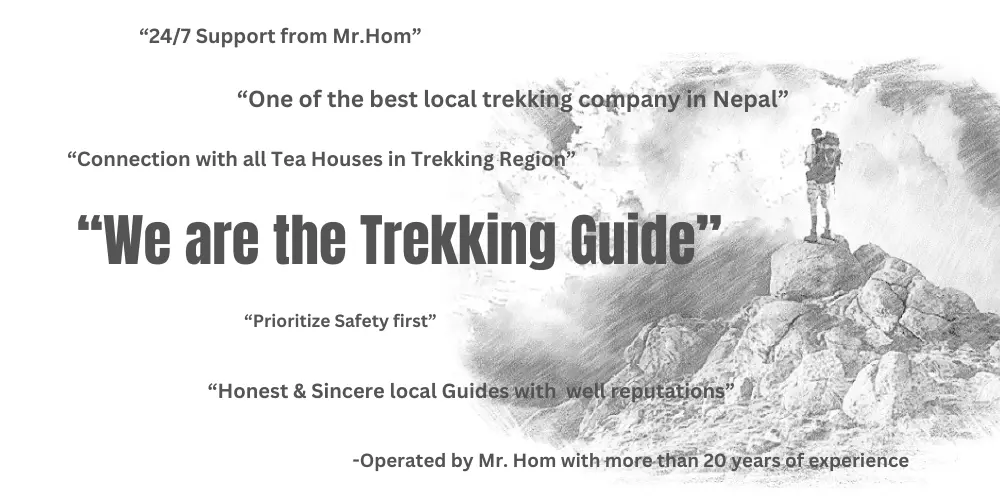
10%-25% Deposit Service Available to Book any Package | Secure Online Payment System
Government Registered Comapny | Check our Legal Documents
We are a Eco-Friendly Tour Operator | Eco-friendly Guides & Porters
Licensed English Speaking Guide | Trained for any Emergencies
No hidden charges, 100% money return upon cancellation of trip | See our Cancellation Policy
Year: Select 2024 2025
Months: Select January February March April May June July August September October November December
Lukla Flight Dates: Choose a month first
Your Message:
You May Also Like
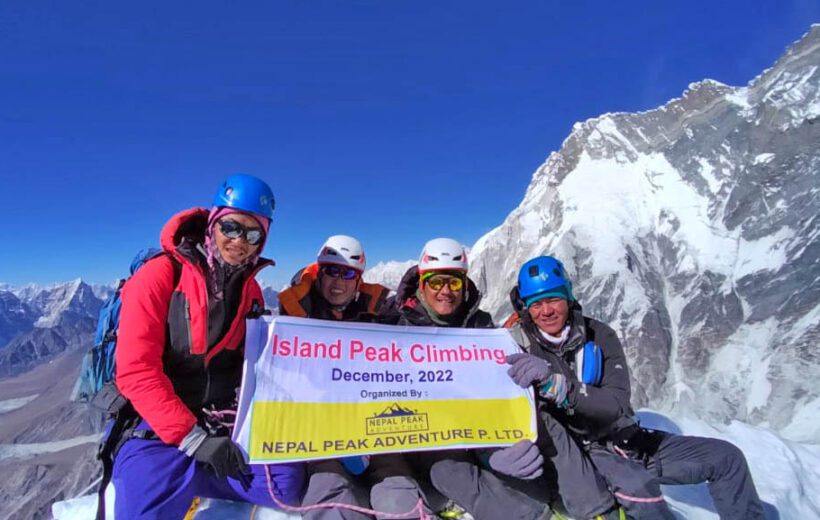
Book This Tour
We are affiliated with:.

Nepal Peak Adventure
Nepal Peak Adventure stands as a premier trekking and travel agency dedicated to curating exceptional and memorable journeys in the heart of the Himalayas.

Trekking & Climbing
- Everest Region
- Annapurna Region
- Langtang Region
- Manaslu Region
- Dolpo Region
- Short Treks
- Beginner's Level Climbing
- Intermediate Level Climbing
- Challening Level Climbing
- Legal Documents
- Trekking Guides
- Climbing Guides
- Celebration
Bhagwan Bahal Street, Thamel, Kathmandu- Nepal
What’s App: +977 9841319155
+(977) 9841319155

- Terms & Conditions
- Privacy Policy
Russia Travel Blog | All about Russia in English
- About our blog
- RussiaTrek.org
Sidebar →
- Architecture
- Entertainment
- RussiaTrek.org News

- Send us a tip with a message
- Support RussiaTrek.org
- Travel Guide to Ukraine
- Comments RSS
← Sidebar
The trains and stations of the Moscow Metro
2 Comments · Posted by Alex Smirnov in Cities , Travel , Video
The Moscow Metro is the third most intensive subway system in the world after Tokyo and Seoul subways. The first line was opened on May 15, 1935. Since 1955, the metro has the name of V.I. Lenin.
The system consists of 12 lines with a total length of 305.7 km. Forty four stations are recognized cultural heritage. The largest passenger traffic is in rush hours from 8:00 to 9:00 and from 18:00 to 19:00.
Cellular communication is available on most of the stations of the Moscow Metro. In March 2012, a free Wi-Fi appeared in the Circle Line train. The Moscow Metro is open to passengers from 5:20 to 01:00. The average interval between trains is 2.5 minutes.
The fare is paid by using contactless tickets and contactless smart cards, the passes to the stations are controlled by automatic turnstiles. Ticket offices and ticket vending machines can be found in station vestibules.
Tags: Moscow city
You might also like:

The bridge over Zolotoy Rog Bay in Vladivostok
The views of St. Petersburg from the TV tower >>
Tomás · August 27, 2012 at 11:34 pm
The Moscow metro stations are the best That I know, cars do not.
Alberto Calvo · September 25, 2016 at 8:57 pm
Great videos! Moscow Metro is just spectacular. I actually visited Moscow myself quite recently and wrote a post about my top 7 stations, please check it out and let me know what you think! :)
http://www.arwtravels.com/blog/moscow-metro-top-7-stations-you-cant-miss
Trains Moscow to Elektrostal: Times, Prices and Tickets
- Train Times
- Seasonality
- Accommodations
Moscow to Elektrostal by train
The journey from Moscow to Elektrostal by train is 32.44 mi and takes 2 hr 7 min. There are 71 connections per day, with the first departure at 12:15 AM and the last at 11:46 PM. It is possible to travel from Moscow to Elektrostal by train for as little as or as much as . The best price for this journey is .
Get from Moscow to Elektrostal with Virail
Virail's search tool will provide you with the options you need when you want to go from Moscow to Elektrostal. All you need to do is enter the dates of your planned journey, and let us take care of everything else. Our engine does the hard work, searching through thousands of routes offered by our trusted travel partners to show you options for traveling by train, bus, plane, or carpool. You can filter the results to suit your needs. There are a number of filtering options, including price, one-way or round trip, departure or arrival time, duration of journey, or number of connections. Soon you'll find the best choice for your journey. When you're ready, Virail will transfer you to the provider's website to complete the booking. No matter where you're going, get there with Virail.
How can I find the cheapest train tickets to get from Moscow to Elektrostal?
Prices will vary when you travel from Moscow to Elektrostal. On average, though, you'll pay about for a train ticket. You can find train tickets for prices as low as , but it may require some flexibility with your travel plans. If you're looking for a low price, you may need to prepare to spend more time in transit. You can also often find cheaper train tickets at particular times of day, or on certain days of the week. Of course, ticket prices often change during the year, too; expect to pay more in peak season. For the lowest prices, it's usually best to make your reservation in advance. Be careful, though, as many providers do not offer refunds or exchanges on their cheapest train tickets. Unfortunately, no price was found for your trip from Moscow to Elektrostal. Selecting a new departure or arrival city, without dramatically changing your itinerary could help you find price results. Prices will vary when you travel from Moscow to Elektrostal. On average, though, you'll pay about for a train ticket. If you're looking for a low price, you may need to prepare to spend more time in transit. You can also often find cheaper train tickets at particular times of day, or on certain days of the week. Of course, ticket prices often change during the year, too; expect to pay more in peak season. For the lowest prices, it's usually best to make your reservation in advance. Be careful, though, as many providers do not offer refunds or exchanges on their cheapest train tickets.
How long does it take to get from Moscow to Elektrostal by train?
The journey between Moscow and Elektrostal by train is approximately 32.44 mi. It will take you more or less 2 hr 7 min to complete this journey. This average figure does not take into account any delays that might arise on your route in exceptional circumstances. If you are planning to make a connection or operating on a tight schedule, give yourself plenty of time. The distance between Moscow and Elektrostal is around 32.44 mi. Depending on the exact route and provider you travel with, your journey time can vary. On average, this journey will take approximately 2 hr 7 min. However, the fastest routes between Moscow and Elektrostal take 1 hr 3 min. If a fast journey is a priority for you when traveling, look out for express services that may get you there faster. Some flexibility may be necessary when booking. Often, these services only leave at particular times of day - or even on certain days of the week. You may also find a faster journey by taking an indirect route and connecting in another station along the way.
How many journeys from Moscow to Elektrostal are there every day?
On average, there are 71 daily departures from Moscow to Elektrostal. However, there may be more or less on different days. Providers' timetables can change on certain days of the week or public holidays, and many also vary at particular times of year. Some providers change their schedules during the summer season, for example. At very busy times, there may be up to departures each day. The providers that travel along this route include , and each operates according to their own specific schedules. As a traveler, you may prefer a direct journey, or you may not mind making changes and connections. If you have heavy suitcases, a direct journey could be best; otherwise, you might be able to save money and enjoy more flexibility by making a change along the way. Every day, there are an average of 18 departures from Moscow which travel directly to Elektrostal. There are 53 journeys with one change or more. Unfortunately, no connection was found for your trip from Moscow to Elektrostal. Selecting a new departure or arrival city, without dramatically changing your itinerary could help you find connections.
Book in advance and save
If you're looking for the best deal for your trip from Moscow to Elektrostal, booking train tickets in advance is a great way to save money, but keep in mind that advance tickets are usually not available until 3 months before your travel date.
Stay flexible with your travel time and explore off-peak journeys
Planning your trips around off-peak travel times not only means that you'll be able to avoid the crowds, but can also end up saving you money. Being flexible with your schedule and considering alternative routes or times will significantly impact the amount of money you spend on getting from Moscow to Elektrostal.
Always check special offers
Checking on the latest deals can help save a lot of money, making it worth taking the time to browse and compare prices. So make sure you get the best deal on your ticket and take advantage of special fares for children, youth and seniors as well as discounts for groups.
Unlock the potential of slower trains or connecting trains
If you're planning a trip with some flexible time, why not opt for the scenic route? Taking slower trains or connecting trains that make more stops may save you money on your ticket – definitely worth considering if it fits in your schedule.
Best time to book cheap train tickets from Moscow to Elektrostal
The cheapest Moscow - Elektrostal train tickets can be found for as low as $35.01 if you’re lucky, or $54.00 on average. The most expensive ticket can cost as much as $77.49.
Find the best day to travel to Elektrostal by train
When travelling to Elektrostal by train, if you want to avoid crowds you can check how frequently our customers are travelling in the next 30-days using the graph below. On average, the peak hours to travel are between 6:30am and 9am in the morning, or between 4pm and 7pm in the evening. Please keep this in mind when travelling to your point of departure as you may need some extra time to arrive, particularly in big cities!
Moscow to Elektrostal CO2 Emissions by Train

Anything we can improve?
Frequently Asked Questions
Go local from moscow, trending routes, weekend getaways from moscow, international routes from moscow and nearby areas, other destinations from moscow, other popular routes.
- Elektrostal Tourism
- What to do in Elektrostal
- Elektrostal Hotels
- Itineraries
- Elektrostal
- 3 Days In Elektrostal
Elektrostal Itinerary 3 Days
Popular itineraries for 3 days in elektrostal.
To make planning simple, explore these popular itineraries for 3 days in Elektrostal. These are the most viewed and customized itineraries for Elektrostal. Choose a Elektrostal itinerary for 3 days and customize to fit your needs.

Recent Elektrostal Itinerary 3 Days
Explore these recently created itineraries to get ideas on attractions currently visited by people or hotels people are staying at. Refer to these more realistic itineraries for Elektrostal, that are perfect for a visit in next few days.

Create a Elektrostal Itinerary 3 Days Now
Can't find what you're looking for? Create Your Itinerary From Scratch. Hit the start planning button, enter the dates and follow simple steps. Get an awesome Elektrostal itinerary 3 days ready in few minutes. You can share or print this itinerary for free.
Explore these 3 Day Itineraries in Cities Nearby
- 3 Days in Moscow

IMAGES
VIDEO
COMMENTS
14 Days Mera Peak Outline Itinerary: Day 1: Arrival in Kathmandu (1,400m/4,593ft) - Transfer to Hotel and Trek Preparation. Day 2: Fly to Lukla and trek to Chutanga (3,100m/10,168ft) ...
Mera Peak Climbing Route Options. There are several different climbing routes available for Mera Peak. The most popular is to go over the Zatrwa La Pass on the second day. The pass is 4600m and you sleep at a whopping 4200m. Most of the people who came this way described it as extremely difficult, and most suffered altitude sickness on the ...
5-6 hrs Trek Lodge . Chhuthang Elevation: 3,020 meters Tuli Kharka Elevation: 4,300 meters Zatrawal Pass Elevation: 4,600 meters Elevation Gain: 1,580 meters It's another day of scenic adventure in your Mera Peak Climbing, however, as you will pass one of the high Himlayan passes, you need to take it easy and stay hydrated throughout the adventure.
Mera Peak Climbing Itinerary of 14 days is one of the few thrilling adventures that take you to one of the remotest and highest corners of the world. You climb Mera Peak, the highest trekking peak in Nepal, after trekking past the untouched and wild Hinku Valley. The valley, located in the Everest Region, is a storehouse of rare Himalayan flora ...
Mera Peak Climbing is the ultimate journey for adventure lovers in the Nepalese Himalayas.This 15-day-long peak climbing expedition takes visitors to the summit of the highest 'trekking peak' currently open for travelers in the country, Mera Peak at an elevation of 6461 meters above sea level. The peak is a hidden gem in eastern Nepal and is often considered the next level for someone who ...
Updated: May 5, 2023. Mera Peak is widely regarded as the one of the highest trekking peaks in Nepal. The trek is suited for experienced high-altitude trekkers but does not require technical climbing skills as slopes rarely exceed 40 degrees. It is an Alpine Grade F (easy) except for the final 30 or 40 metres, which are Grade PD (not very hard).
Mera Peak (6480 m) is the highest of trekking peaks in Nepal located in SoluKhumbu district in the Everest region's eastern part of Nepal. It is a very high mountain although it is a normal climb that requires no technical climbing on this route. One can experience its climb with an average fitness even though no previous experience of climbing.
The trail to Mera Peak unfolds like a story with each day revealing a new chapter. Here's a glimpse of the typical itinerary: Days 1-2: Kathmandu Captivation: Breathe in the vibrant chaos of Kathmandu, explore ancient temples, and gear up for adventure. Day 3: Lukla Landing: Take a thrilling flight to Lukla, the gateway to the Himalayas, and ...
Detailed Itinerary of Mera Peak climbing Day 1: A flight from Kathmandu to Lukla and an Uphill trek to Chhuthang. Chhutang's altitude - 3020 meters. Flight hours - 45 minutes. Walking hours - 4 to 5 hours. Overnight stay at lodge in Chhuthang. You will start your adventure of Mera peak climbing by boarding a flight from Kathmandu to Lukla.
Day 12 Trek up to Thuli Kharka (4200m) 6 hours, Off the Beaten Trail. You will follow a new route back to Thuli Kharka, located on an open hill. The trail passes through pine forests and later walks off the beaten track. On the way, you will have a wonderful view of Mera North, Mera Central and Mera South.
Mera Peak Trek Overview: The Mera Peak is one of the most popular trekking peaks in Nepal, and it is popular for a good reason. Situated in the Everest Region, the peak lies at an altitude of 6,476 meters.The summit of the peak provides a breathtaking 360-degree view of the Himalayan range, including Mount Everest (8,848m), Mt Lhotse (8,586m), Mt Cho Oyu (8,201m), and Mt Makalu (8,643m).
Day 4 Trek to Ningsow (2863m) 5 hours, Rhododendron Jungle Trail. Today the trail will feature some great scenic views. You will climb to Nankung La (3110m) from where you can observe a breathtaking view of Mera Peak. Further on, you descend to Sibuje (2770m) and walk to reach Ningsow. Night in Lodge.
Outline Itinerary of Mera Peak in 10 Days. Day 01: Kathmandu to Lukla Flight and uphill trek till Chhuthang. Day 02: Chhuthang to Tuli Kharka Trek crossing Zatrawala Pass. Day 03: Trek from Tuli Kharka to Kothe [4182m/13716ft] Day 04: Kothe to Thangnak Trek.
Mera Peak with an altitude of 6,476 m is situated in the Khumbu region of Nepal. It is well-liked by climbing enthusiasts. In principle, this peak is an exceptional initial peak for those without climbing knowledge. As you trek higher into this remote valley, following the river to the glaciers; you shall notice that this is a clear-cut climb ...
The Mera Peak climb is the highest trekking peak in the world which is located at 6476m is one of the most demanding and challenging treks. ... Itinerary Outline: 1st Day: Arrival day in Kathmandu (1,300m/4,265 ft) 2nd Day: Kathmandu Valley sightseeing & trip preparation
The highest of Nepal's Trekking Peaks - At 6476m Mera Peak is the highest 'trekking peak' suitable for anyone with little or no previous experience of using an ice axe and crampons but have a high level of fitness. From £3,450 Altitude 6,476m Grade: 2B. Description Dates & Prices Trip Dossier Itinerary Photos Insurance Reviews.
Mera Peak Trek is a 14 days peak climbing in Nepal to conquer the trekking peak of Mera. Elevating at 6476 meters above the sea level, Mera peak is the highest trekking peak in Nepal. Part of the Mahalangoor Himalayan range (Everest mountain range)- Mera mountain was successfully ascended by J.O.M Roberts in 20 th May 1953 for the first time.. Best for the climbers having basic ice climbing ...
Lobuche Peak Climbing. 19 days. 0 /5. From $2575. More Information. The most popular trekking peak package is here. Join the Mera Peak Climbing 18 Days itinerary with Nepal Peak ...
The Moscow Metro is the third most intensive subway system in the world after Tokyo and Seoul subways. The first line was opened on May 15, 1935.
23 Feb 2024 Peak Climbing Nepal. Mera Peak trek and climb is an adventurous journey to the highest trekking peak in the Himalayas. Captivating Mera Peak in the Khumbu region stands majestically at an elevation of 6,476 meters/21,247 feet.This trekking peak is the best option for beginner mountaineers to experience the high-altitude trek accompanied by the introductory mountain climb.
The 9th radio centre of Moscow was a high power shortwave and medium wave broadcasting facility at Elektrostal near Moscow.Its broadcasting frequency was 873 kHz with a transmission power of up to 1200 kilowatts. It was also used as radio jammer of "unwanted" stations.
The journey from Moscow to Elektrostal by train is 32.44 mi and takes 2 hr 7 min. There are 71 connections per day, with the first departure at 12:15 AM and the last at 11:46 PM. It is possible to travel from Moscow to Elektrostal by train for as little as or as much as . The best price for this journey is . Journey Duration.
Elektrostal itinerary 3 days and 2 nights: Have a look at these well-crafted itineraries for three days in Elektrostal and travel guides. Know how to get most out of 3 days in Elektrostal with proper planning.